The young tramspotters’ guide to holidaying in the Netherlands
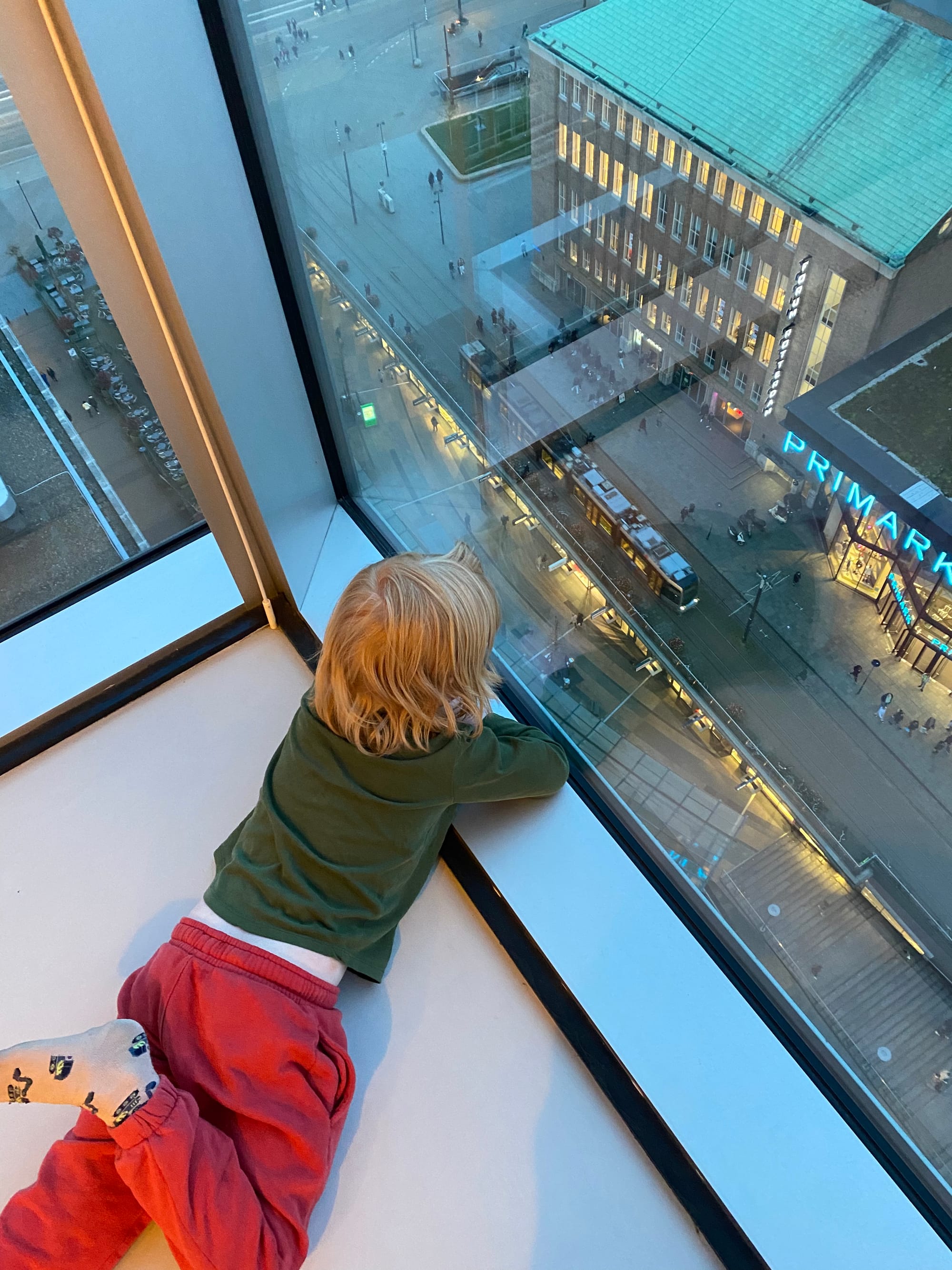
When I told casual acquaintances (our friends know us too well) we were going on holiday to the Netherlands, I got a lot of questions. Mostly where we were going and whether we were visiting a theme park - because that’s a kid thing, we have two young kids, and Amsterdam isn’t famous for its kid-friendly attractions.
In fact, we stayed in Rotterdam for a week, with a couple of day trips beyond the city limits. The trip worked really well. This isn’t usually a travel blog, but I wanted to share my experience for anyone Googling who has kids like mine. I have two boys, aged 4 and 7. Officially speaking, my Bigger Boy is Dual and Multiply Exceptional (DME. Twice Exceptional, 2e,US terminology) - he’s both autistic and highly gifted. My Smaller Boy is similar, but not quite as bright.
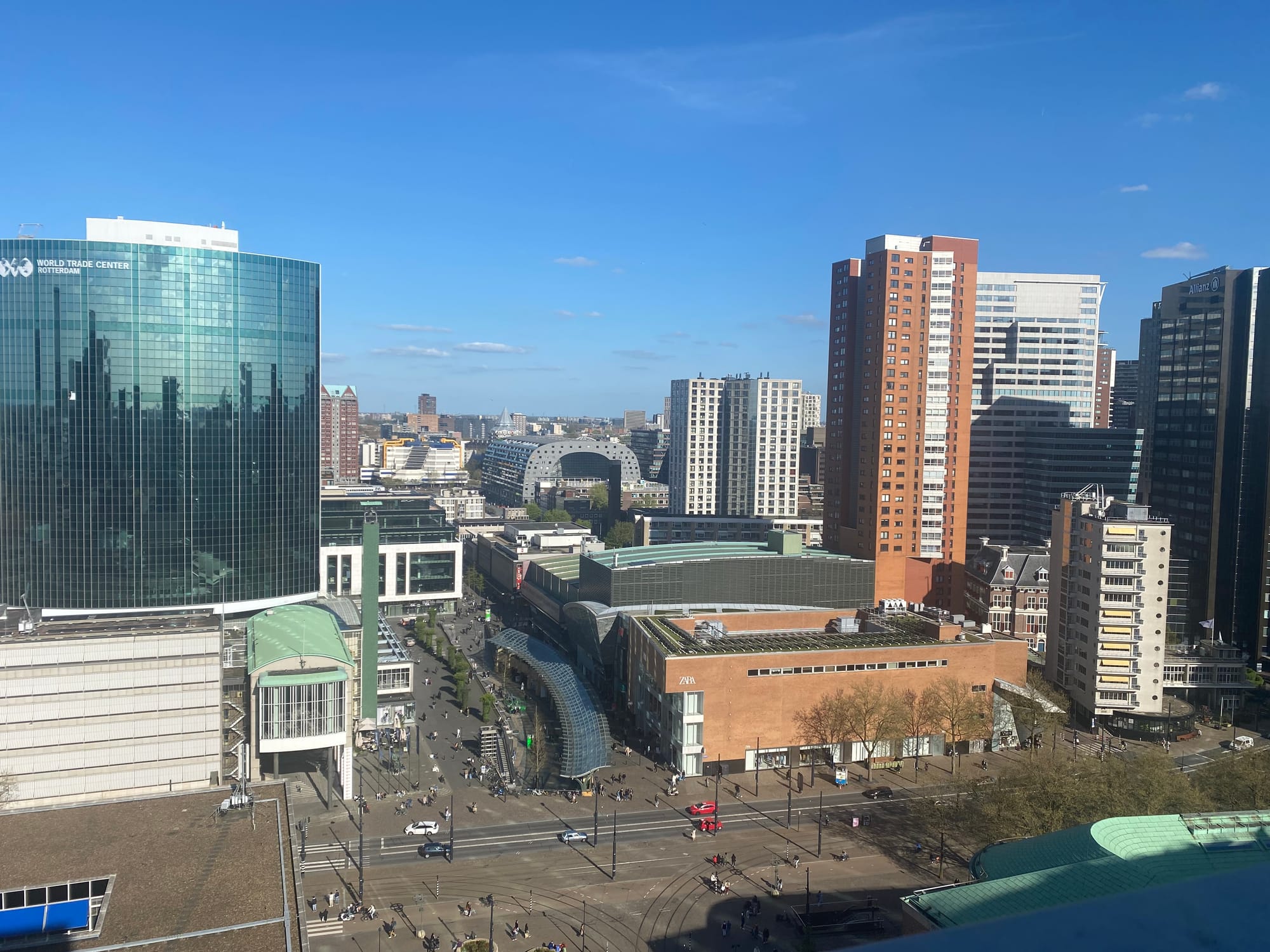
It’s almost universal on High Learning Potential (HLP) Facebook groups for little boys to be interested in space/Minecraft/Lego/reading, but most kids‘ holiday recommendations don’t account for those interests. My kids can’t go to theme parks, as they’re too noisy, and children’s activities are babyish for my Bigger Boy. Organised autistic trips don’t work for DME kids either - they’re usually designed for children with learning disabilities.
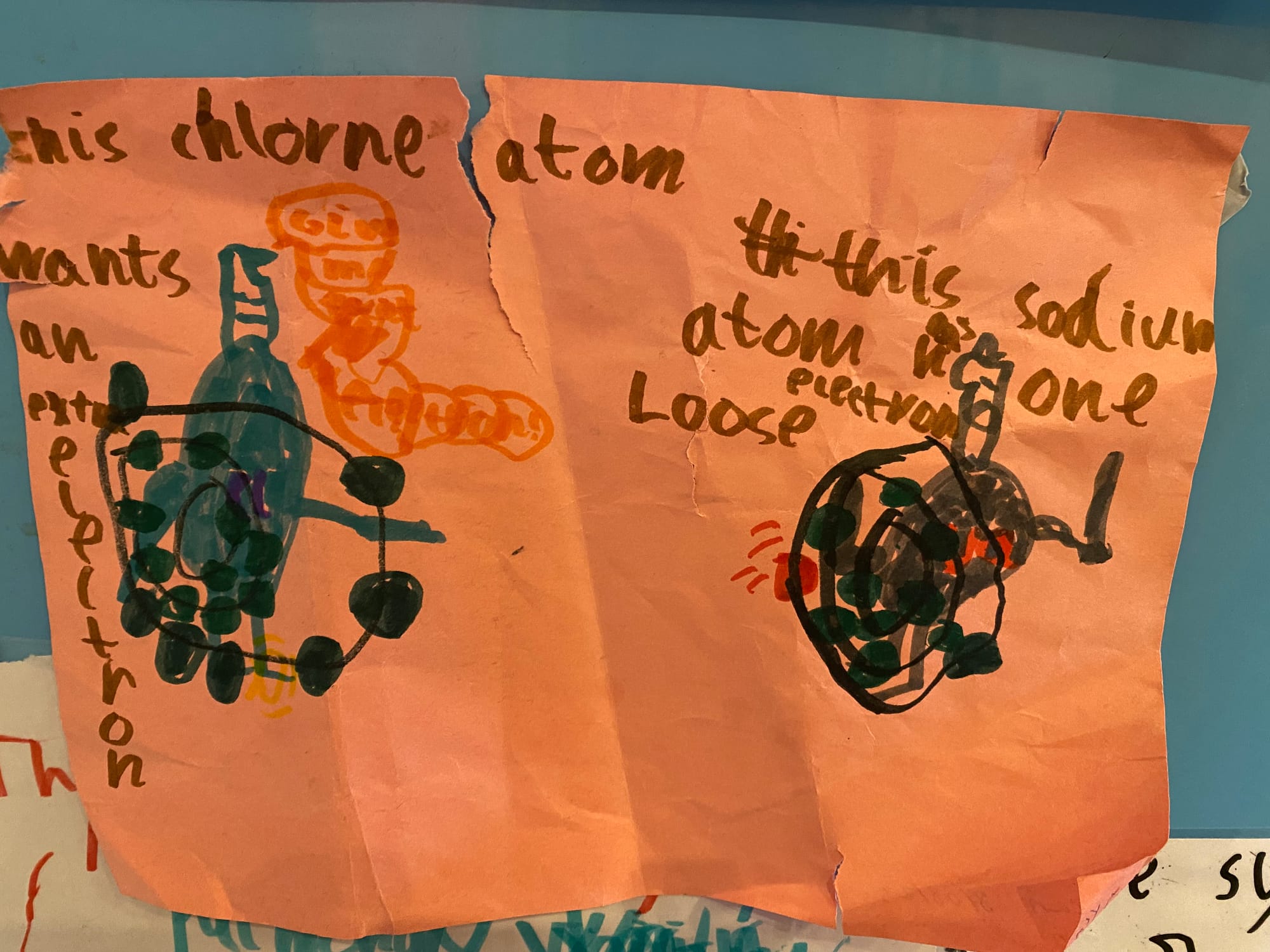
Bearing all that in mind, here are some ideas for a holiday that worked for two bright, geeky kids with major sensory issues who are interested in Minecraft, Lego, space and all things technical. Smaller Boy is also super-interested in transport (planes, trains, buses and trams) - hence, the blog title. Bigger Boy currently wants to be a medical researcher when he grows up.
In this guide, I’ve included information on the practicalities of travel and accommodation, along with attraction reviews. It's very long, so feel free to use the table of contents to find the information you want.
Getting there (and back)
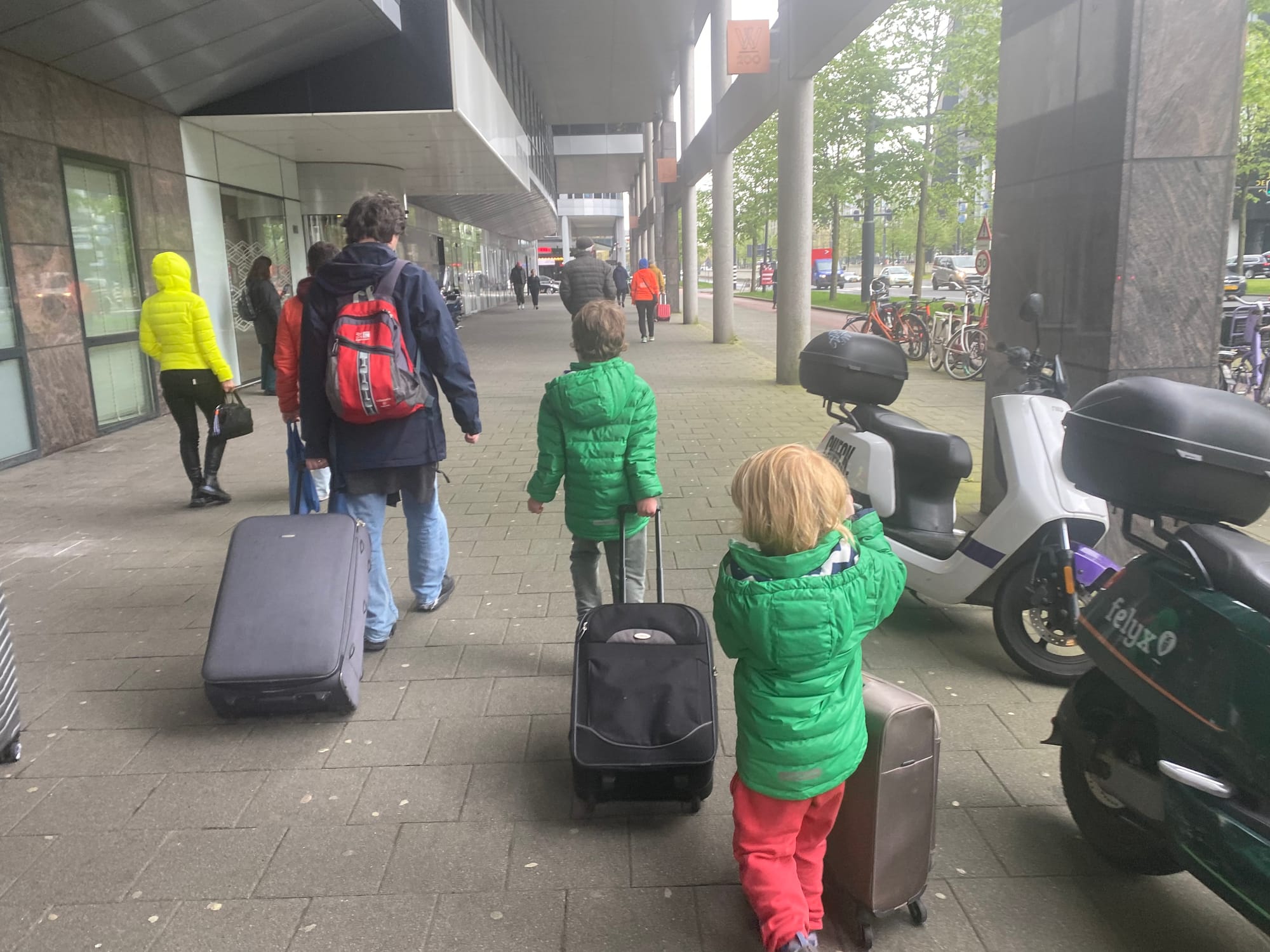
Travelling to mainland Europe on Eurostar had been on Bigger Boy’s bucket list since an international train overtook our high-speed Javelin. He was so keen to travel at 300km/hr that it took us a while to realise his desire to visit Paris wasn’t about the Eiffel Tower.
I’d been thinking about visiting the Dutch Pinball Museum (we play pinball) and, as we investigated, it turned out that the Netherlands seemed to have more for kids. When we began, I assumed we’d visit Amsterdam, because that’s a tourist destination, but - as our planning went on - it turned out most trips could be done more easily from Rotterdam, the Eurostar stop before Amsterdam.
Rotterdam is about 3 1/4 hours from London on Eurostar and the train had the benefit of not being a plane. The 60-minute check-in allows time to clear British and EU border controls before you get on the train, so there’s no queuing for passport control when you get off.
Special Assistance
We took advantage of the Eurostar Special Assistance (based on Bigger Boy’s autism diagnosis) to be whisked through security at the St. Pancras, London, end of the trip. Neither boy had travelled overseas before, and we worried the crowding and unfamiliar environment could cause Bigger Boy to have a meltdown.
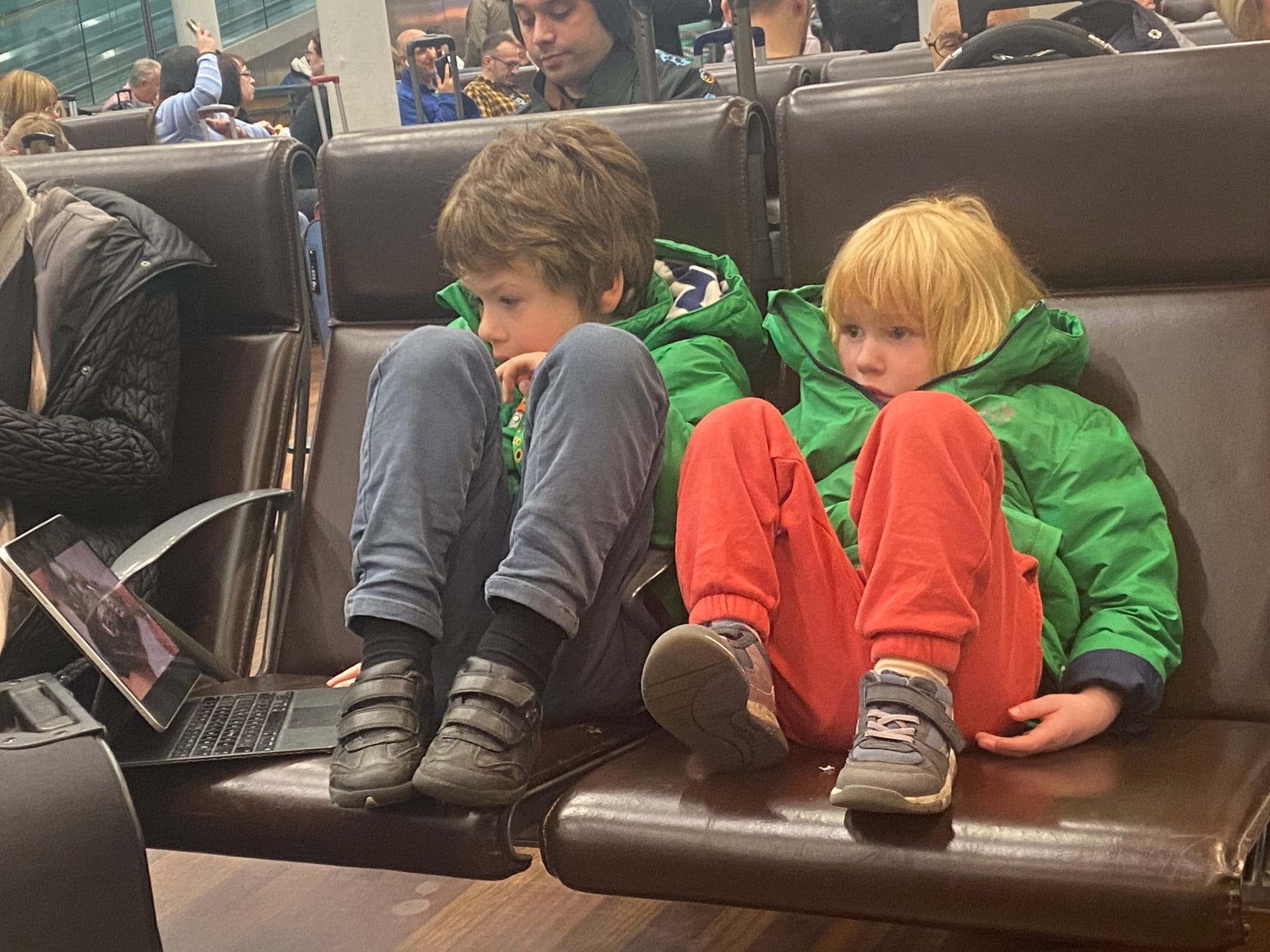
We weren’t offered Special Assistance on the way back because Eurostar (correctly) said we wouldn’t need it in the quieter Rotterdam station, but we were moved to Priority Seating as a family group (with two young kids and my 77-year-old mum).
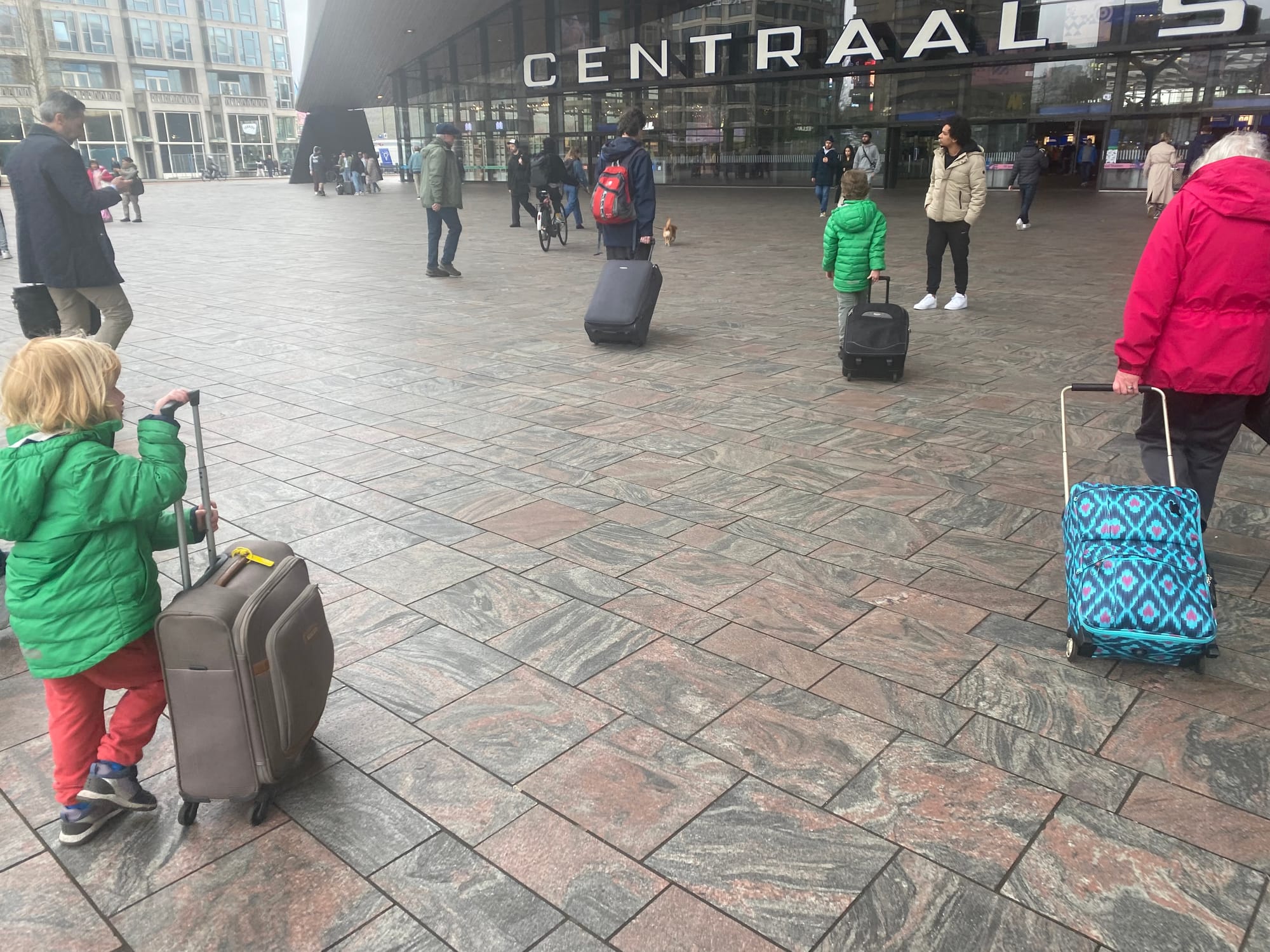
The Special Assistance worked well, with the amusing caveat that the lady assisting us called Smaller Boy “my princess” throughout and then spent several minutes slowly explaining departure boards (ableism ain’t dead, folks). While waiting, we met a lovely Rotterdam local in a powered wheelchair who gave us wonderful tips for places to visit with kids (thank you so much, lovely Rotterdam lady, I’m sorry I never got you and your friend’s name).
Standard Premier - seats and food
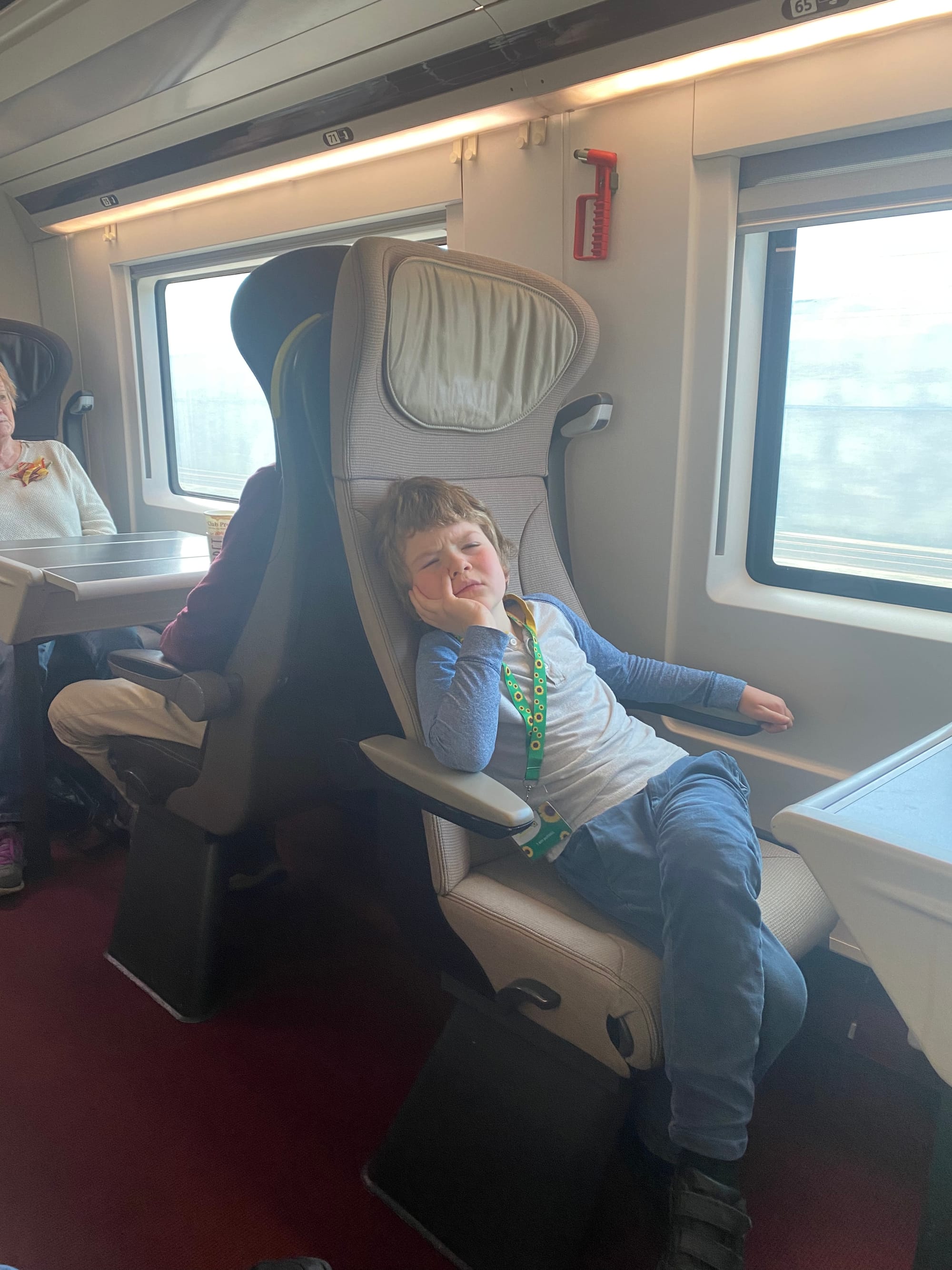
My mum had upgraded us to Standard Premier (the leisure equivalent of First Class on a normal train). This gave us more space, less noise and a light meal on each journey. The boys enjoyed their kids’ meals, although - having decided to be adventurous with food - Bigger Boy was disappointed with the same kids’ meal both ways.
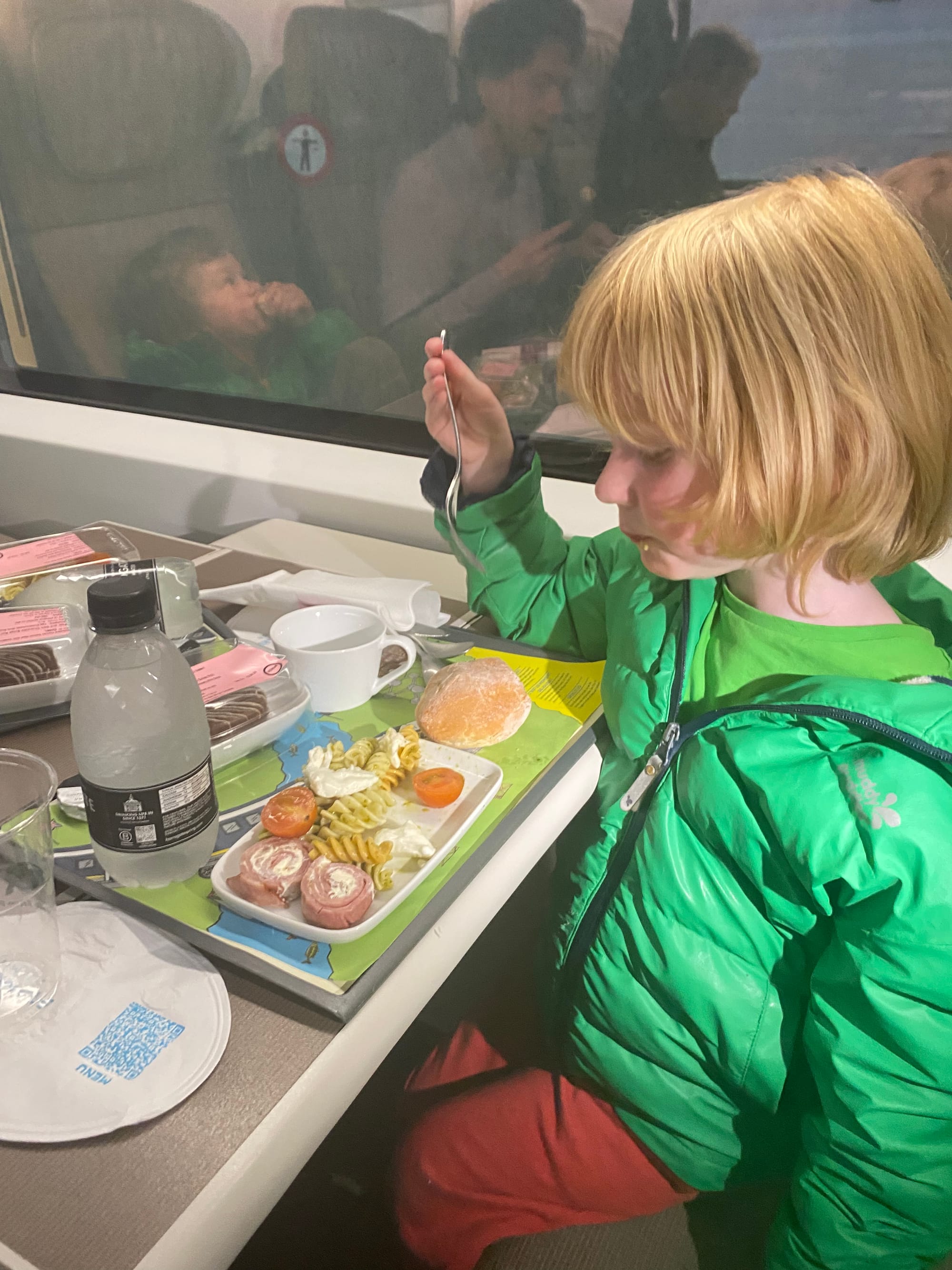
I’ve been on a low-carb diet since I had gestational diabetes with Smaller Boy, and ordered the diabetic meal. I was disappointed to find it was almost identical to the standard meal, except with chicken replacing falafels, and the dark chocolate/cream dessert replaced by pineapple slices.
Pineapple is Kryptonite for diabetes…
Don’t order the diabetic meal, folks.
Where we stayed!
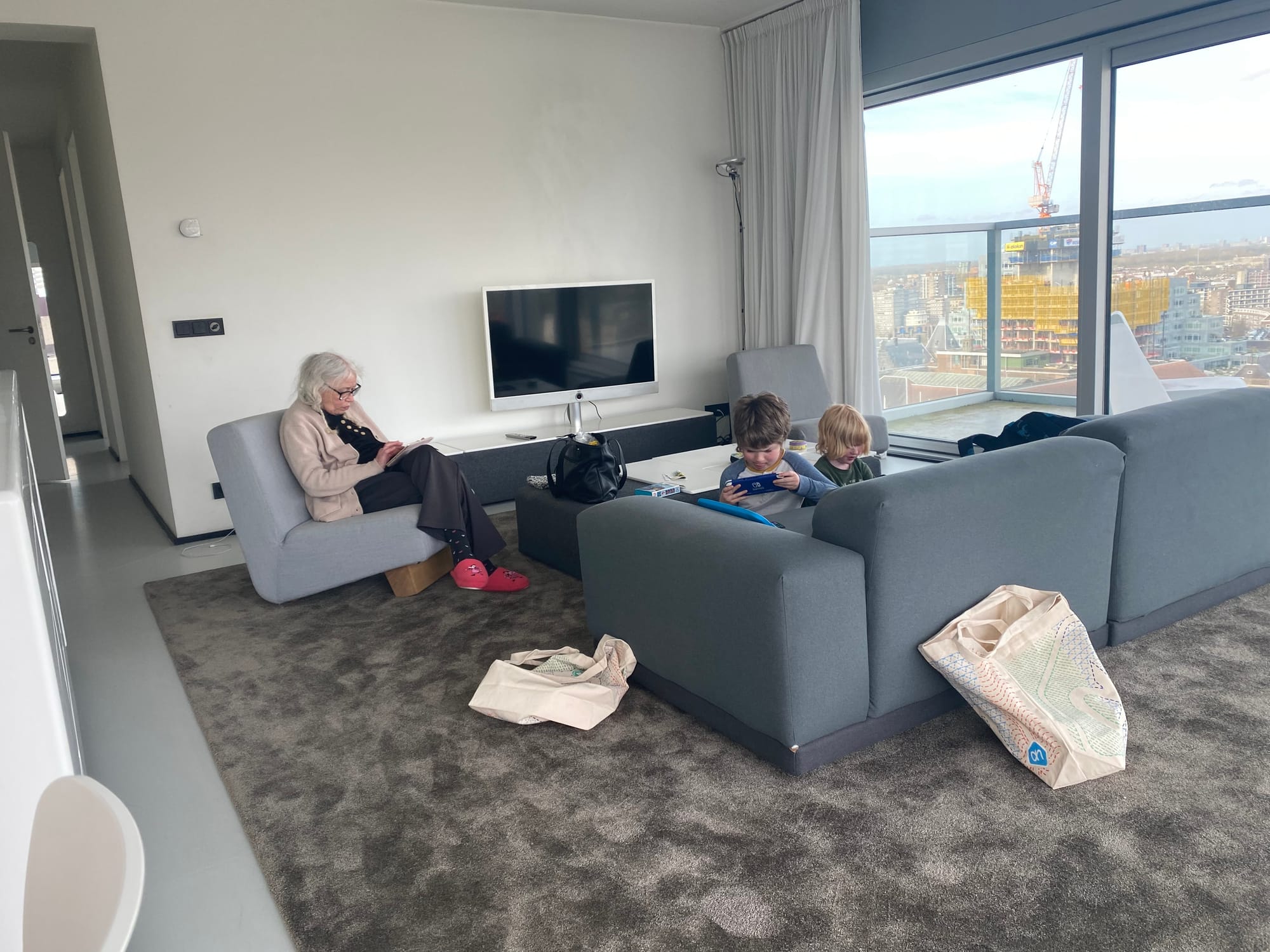
Both boys are picky eaters, making hotels and B&Bs unlikely to work for us. We also needed four bedrooms, as Smaller Boy and Bigger Boy won’t share. We also needed to be close to a Metro station. It turned out that accommodation in central Amsterdam was prohibitively expensive and we’d have had to stay in the suburbs.
Rotterdam was more affordable, but we couldn’t get a four-room unit in the city centre, and opted - instead - for a ‘family studio’ and an apartment in Urban Residences, Rotterdam. Smaller Boy slept on the sofa bed in our 8th floor studio, and Bigger Boy and my mum took the two full-sized bedrooms in the 17th floor apartment.
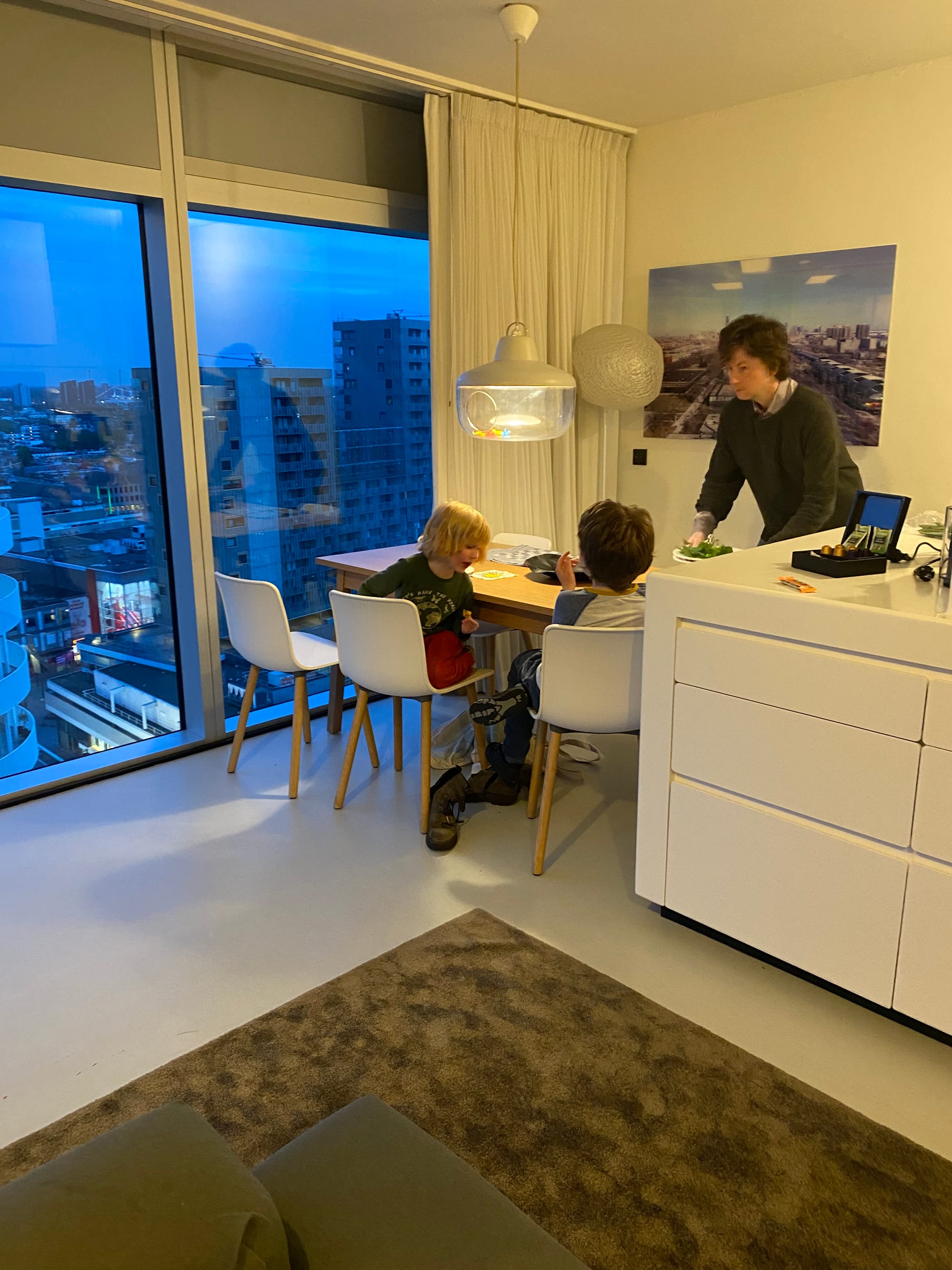
These rooms became christened ‘day room’ and ‘night room’ because the apartment was comfortably large enough for all five of us during the day.
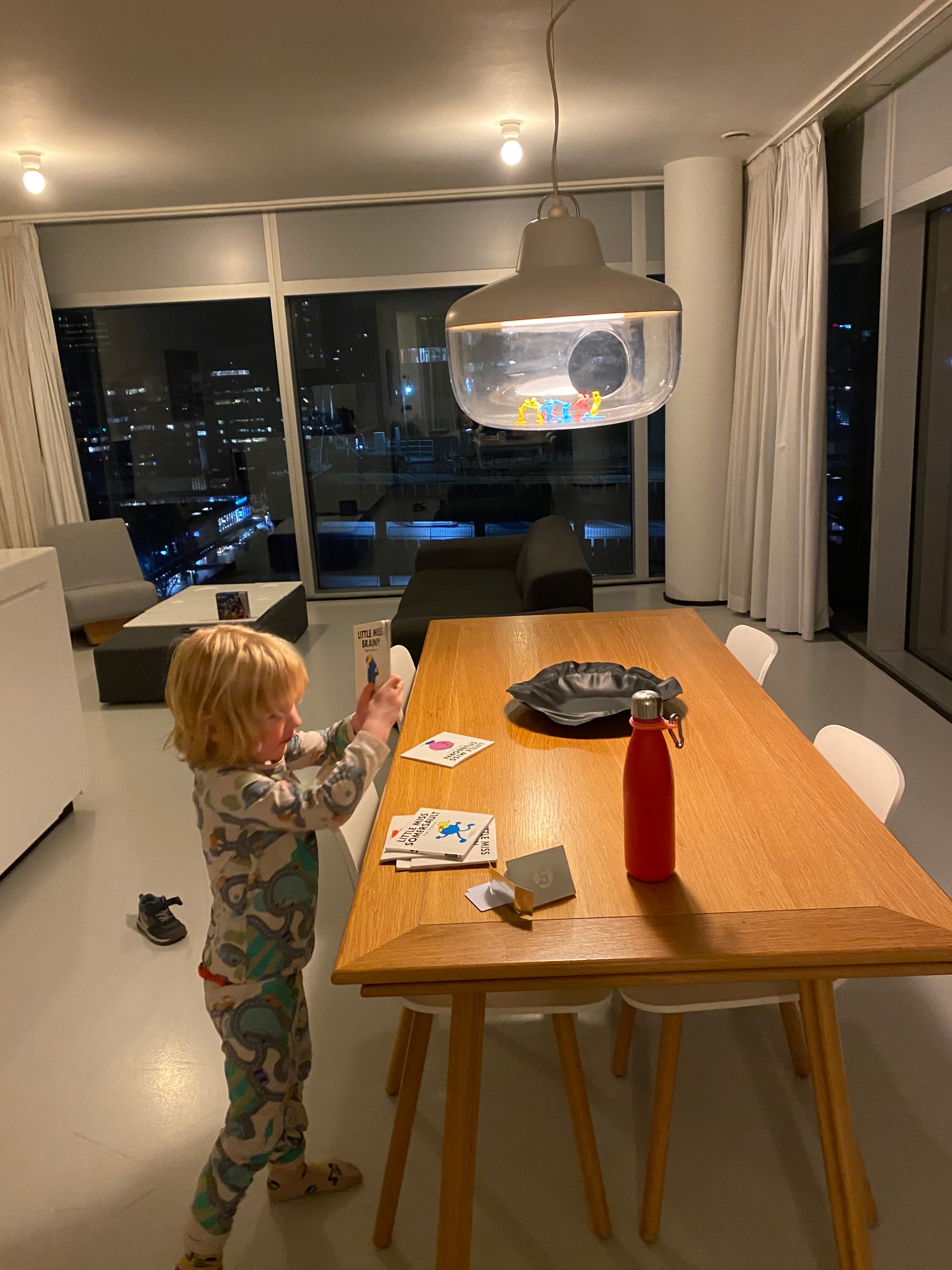
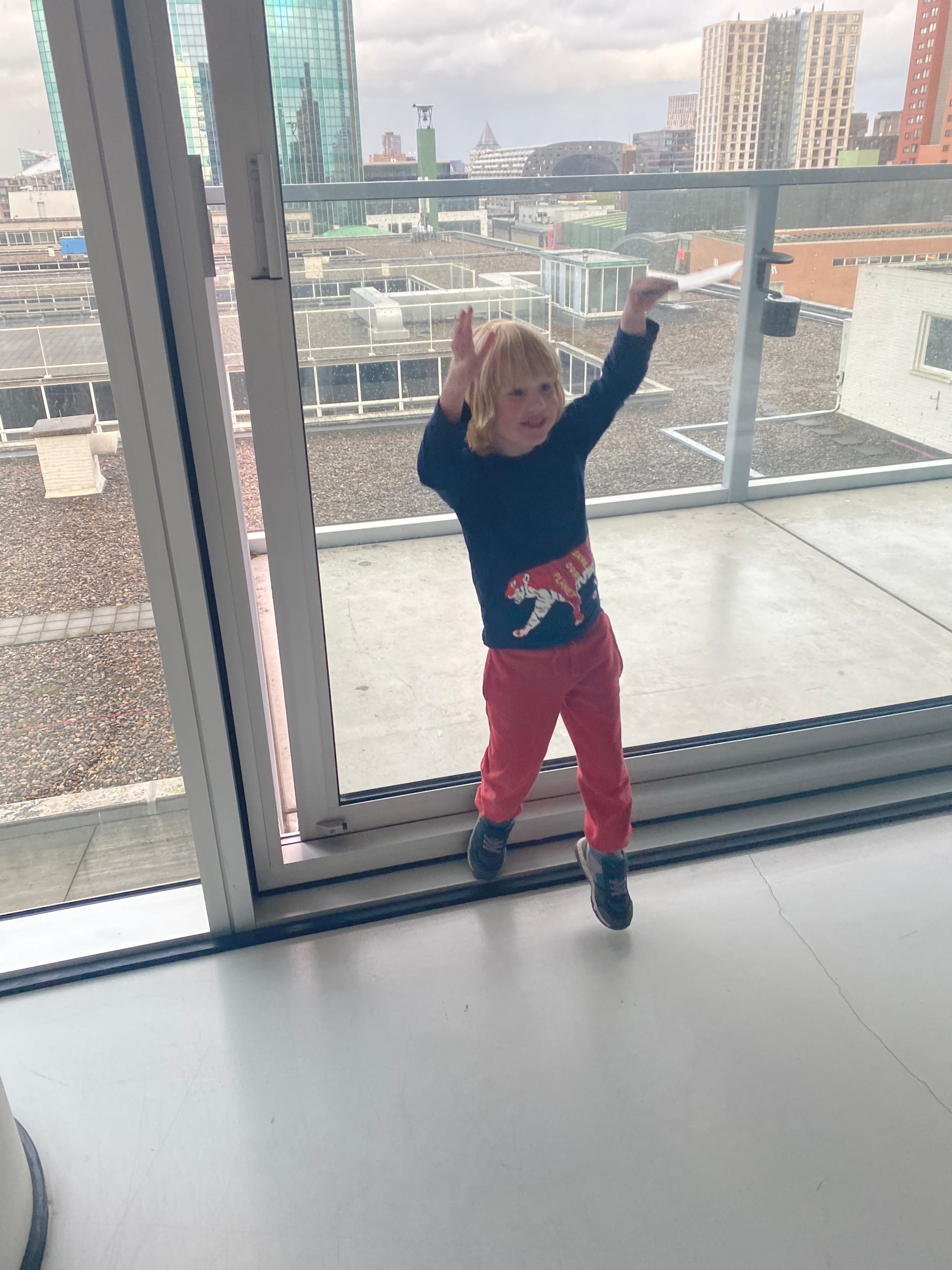
The apartments were clean and quiet, with comfortable beds, helpful staff, and relatively good kitchens. The 17th floor apartment gave Smaller Boy (and bulbasaur) hours of fun spotting trams passing beneath the windows.

The apartment block was well located in the main shopping area of central Rotterdam with a large branch of Albert Heijn, the Dutch equivalent of Tesco, an Etos pharmacy and an Intertoys toy shop, just across the road.
Introducing Rotterdam sightseeing
The first thing you’ll notice about Rotterdam, as compared to Amsterdam, is that the city centre was flattened during World War II and fully rebuilt between 1950 and 1970. Unlike similar British cities, such as Hull, the architects who rebuilt Rotterdam were creative and adventurous - making this a great city to enjoy the best of modern architecture.
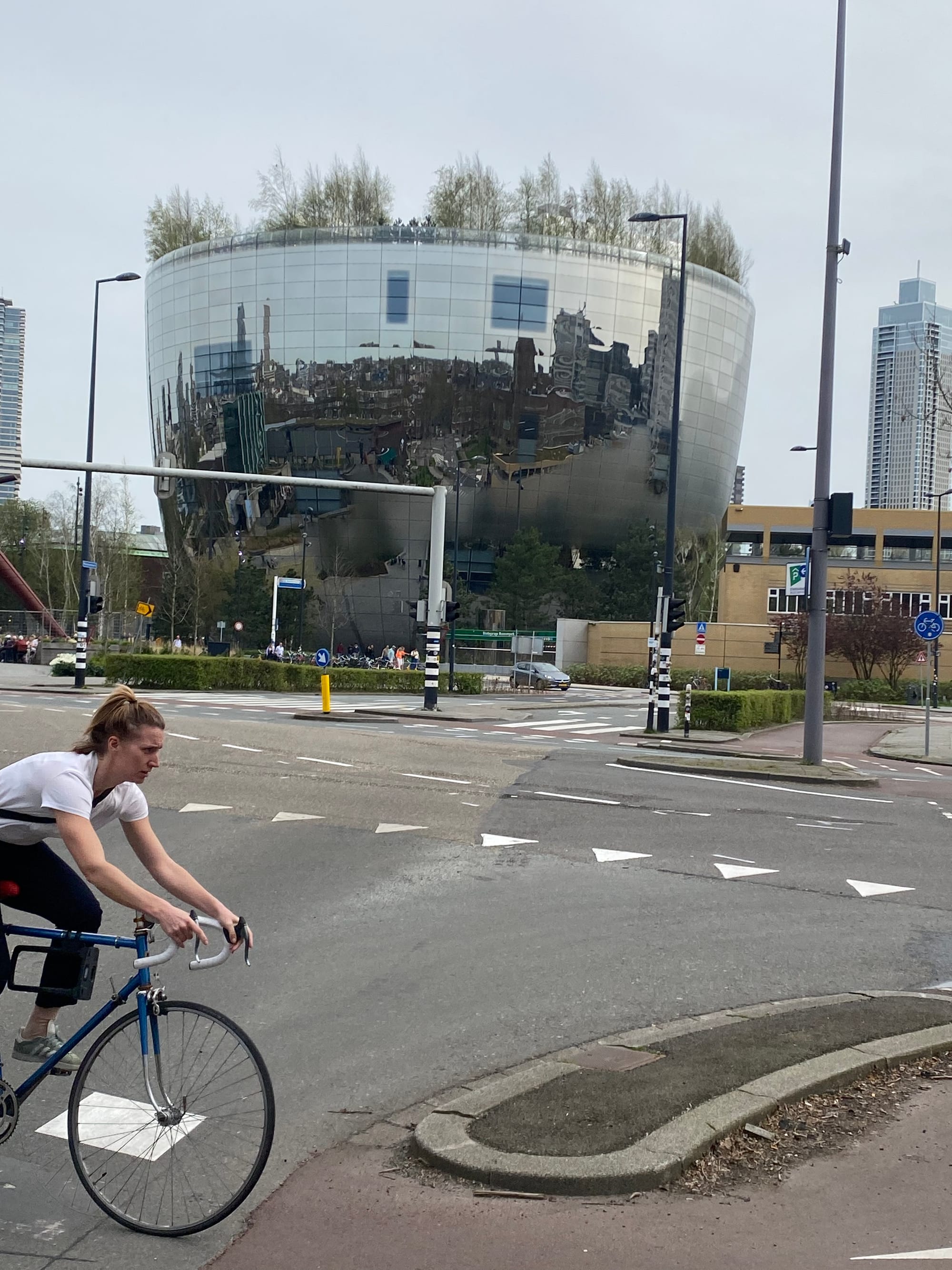
Next to our apartment, for example, was the Lijnbaan, Europe’s first pedestrianised street. Both boys also enjoyed the wonderful cube houses (more later), and the spectacular Erasmus Bridge that is now a landmark for the city.
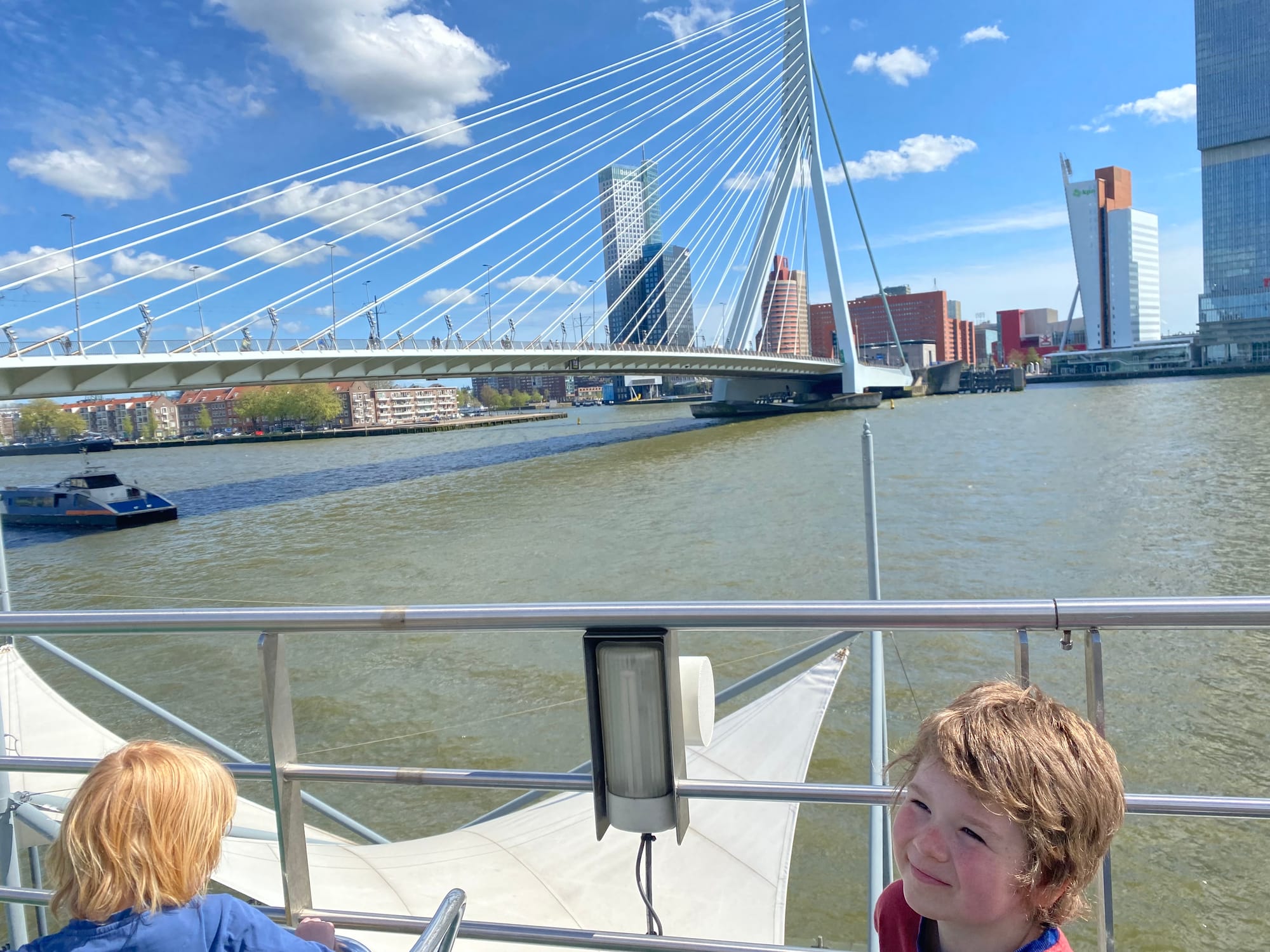
A guide to attractions
When we first evisaged the trip, we planned to visit the Madurodam outdoor miniature Netherlands attraction and Scheveningen beach in The Hague, which I remember from visiting the Netherlands as a child.
However, we adjusted our plans based on recommendations from the local lady we met in Special Assistance and the interest levels of the boys. One of the biggest things we’d learned from a summer trip to Whitby last year was Bigger Boy can only sightsee for a few hours without getting overwhelmed. Thus, we planned for one main activity each day.
Day One: Miniworld, Dutch Pinball Museum, and… street sculpture
Miniworld, an indoor miniature version of Rotterdam covering an area twice the size of a tennis court, was recommended by the local lady from Special Assistance but was unfortunately our least successful attraction.
Miniworld advert in Dutch. Sadly, I didn’t take any pictures in here
Smaller Boy enjoyed it a huge amount. He probably spent two hours watching the miniature train sets and working windmills, and excitedly pointing out buildings he already recognised from our evening ramble around the neighbourhood.
Unfortunately, for an extra 2EURO, we’d bought a ’spot the plastic figure’ map with fourteen Pokemon to find (there was also a Paw Patrol one). Smaller Boy was too young to engage with it, but Bigger Boy was very excited to spot every one. The problem was that Miniworld works on a day/night cycle, where the whole room goes dark for several minutes to highlight the evening attractions of Rotterdam.
When the room went dark, Bigger Boy was unable to see the Pokemon in the miniature city, didn’t appreciate the sparkling lights, and fled the entire exhibit in distress. He told us later that he’d expected the miniature city to be outdoors - presumably because I’d previously trailered Madurodam.
My mistake, but the unexpected day/night effect is something to bear in mind if you take neurodivergent children here.
Dutch Pinball Museum
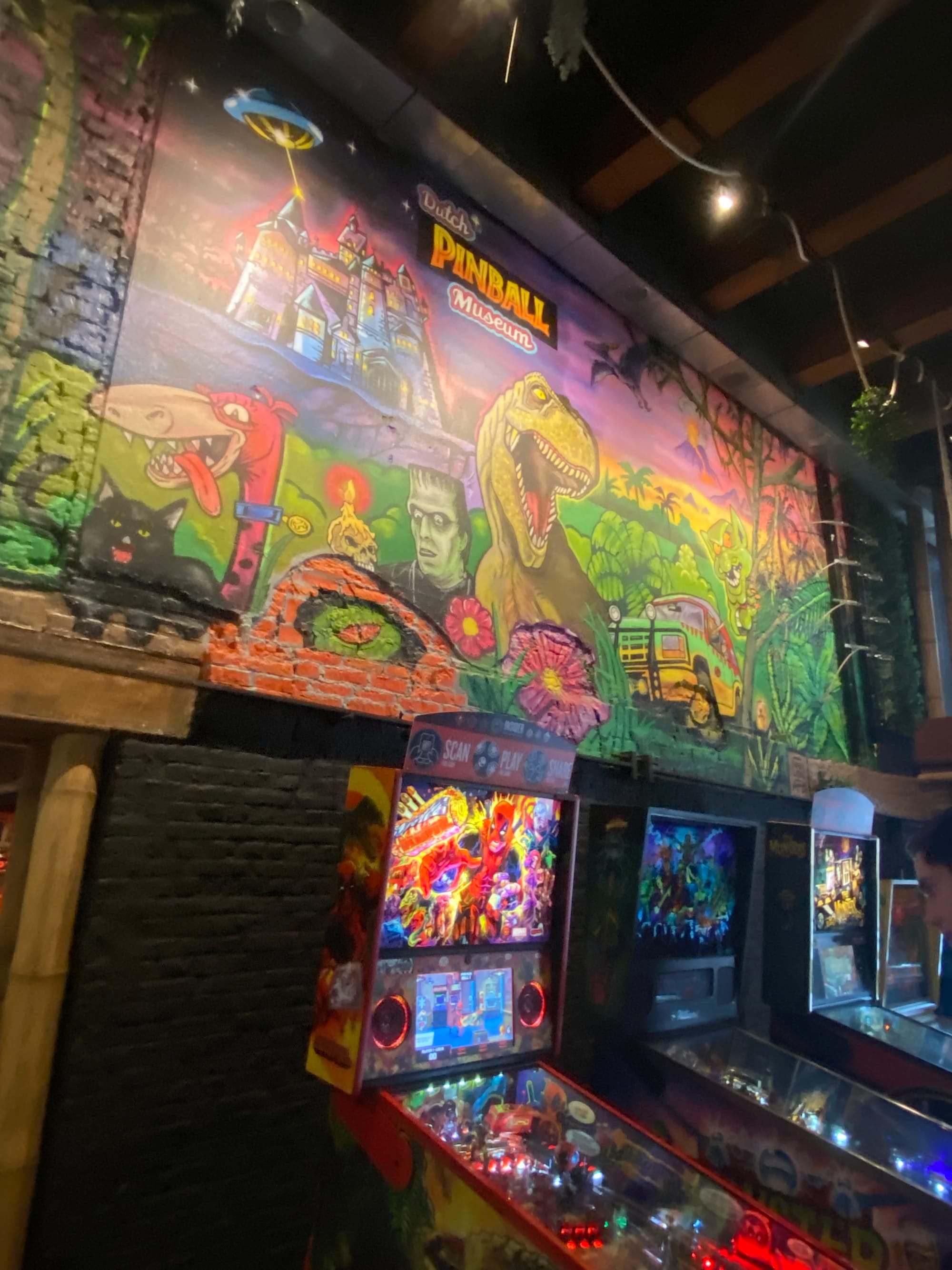
You‘d assume a pinball museum would be a niche attraction, but it was explicitly mentioned on our boat tour of Rotterdam harbour. Housed in a beautiful historic grain warehouse in the historic Delfshaven neighbourhood of Rotterdam, it combines a single-floor exhibit on the history of pinball with two further floors of playable pinball machines.
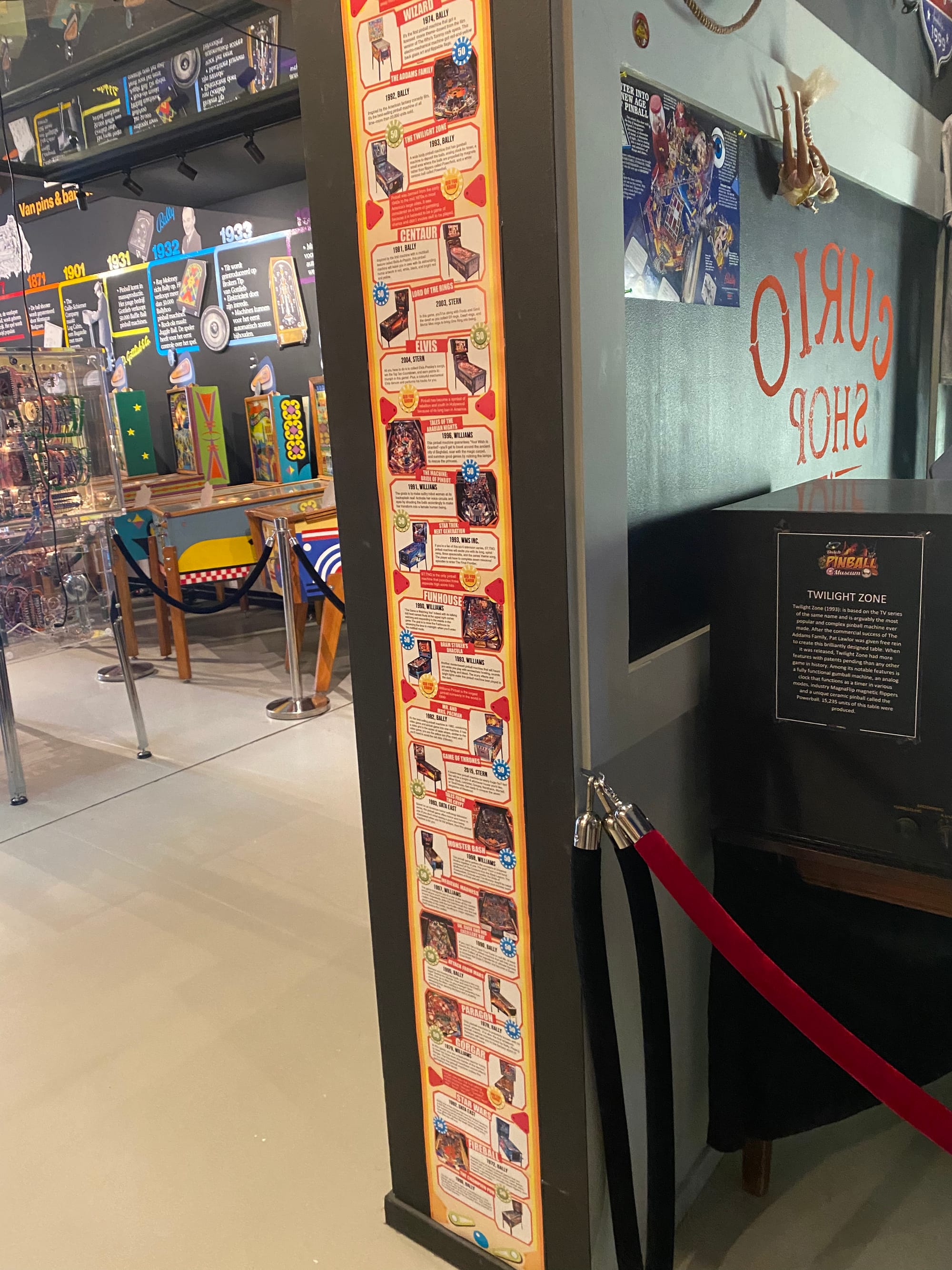
If you thought pinball was consigned to history by the advent of video games, then the Dutch Pinball Museum could change your mind. Featuring both playable modern machines, such as Deadpool (released 2018) and vintage titles, such as Dolly Parton (1979), it’s a great fun way to spend a couple of hours.
The museum is open on Saturday/Sunday/Wednesday afternoon. Payment is at the door for a two-hour slot after which all games are free to play. We spent about four hours there, spread over two days (Sat/Sun). The UK equivalent is Pinball Republic in Croydon, near London, which is due to reopen in a new venue hopefully in May.
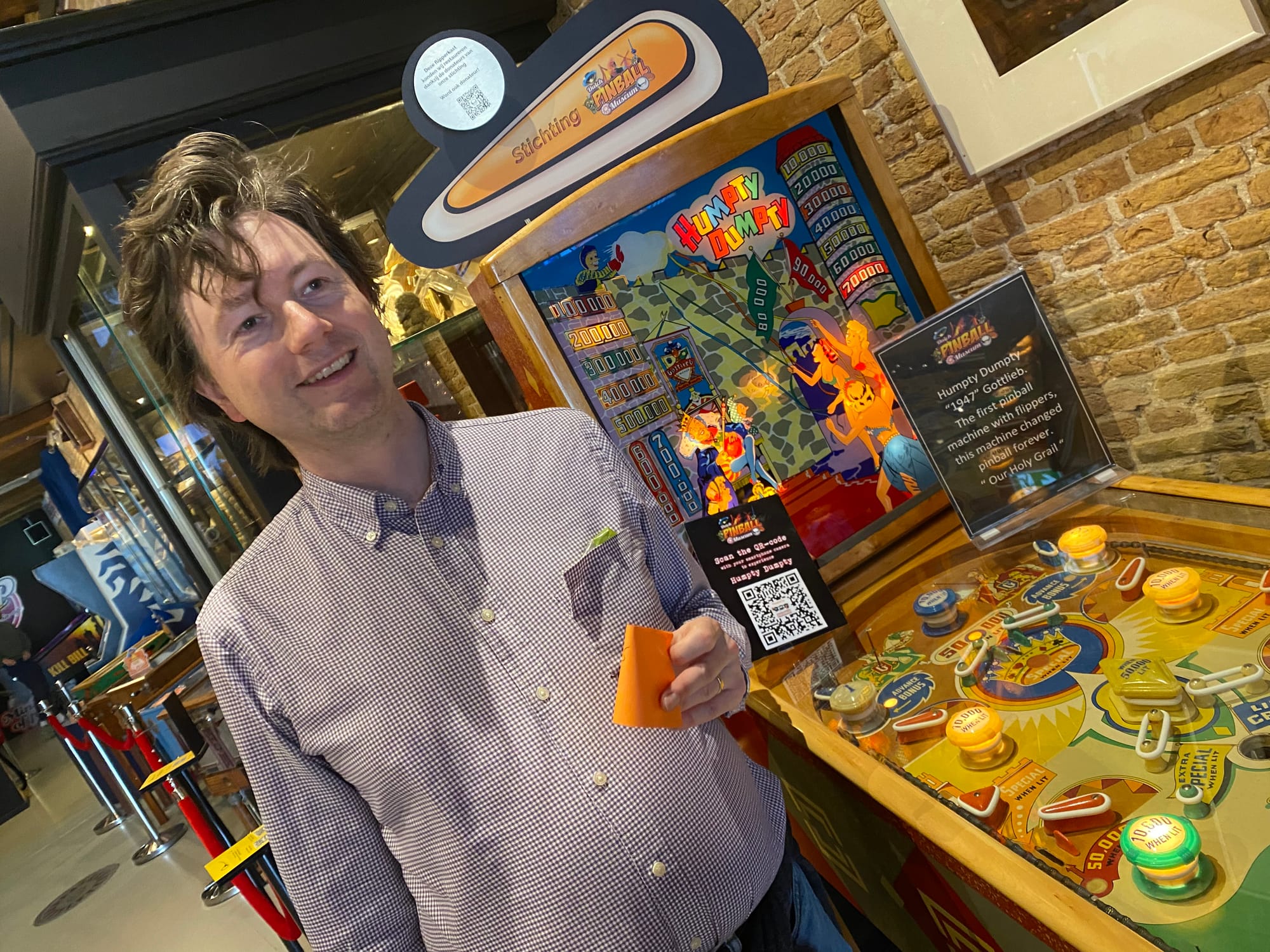
My husband and I visited the Dutch Pinball Museum on our own, leaving the boys building Lego in the day room with my mum.
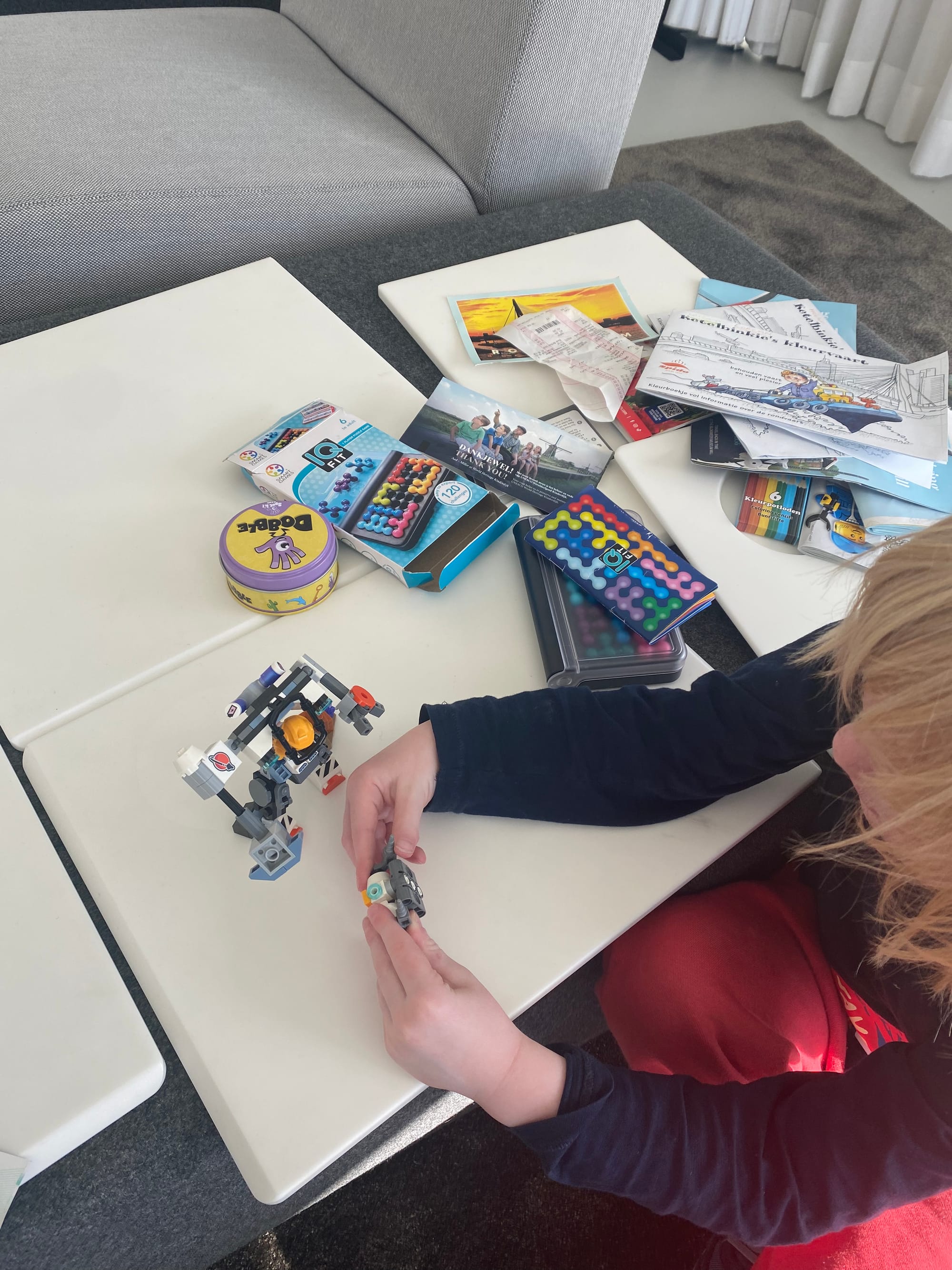
Street sculpture
It costs £100 for a 1 day ticket to Disneyland Paris, but street sculpture is absolutely free. Happily, Rotterdam has lots of public sculptures and my boys loved them. Whether interpreting what abstract sculptures were supposed to represent, or just climbing on top of them, it was often hard to drag the boys away.
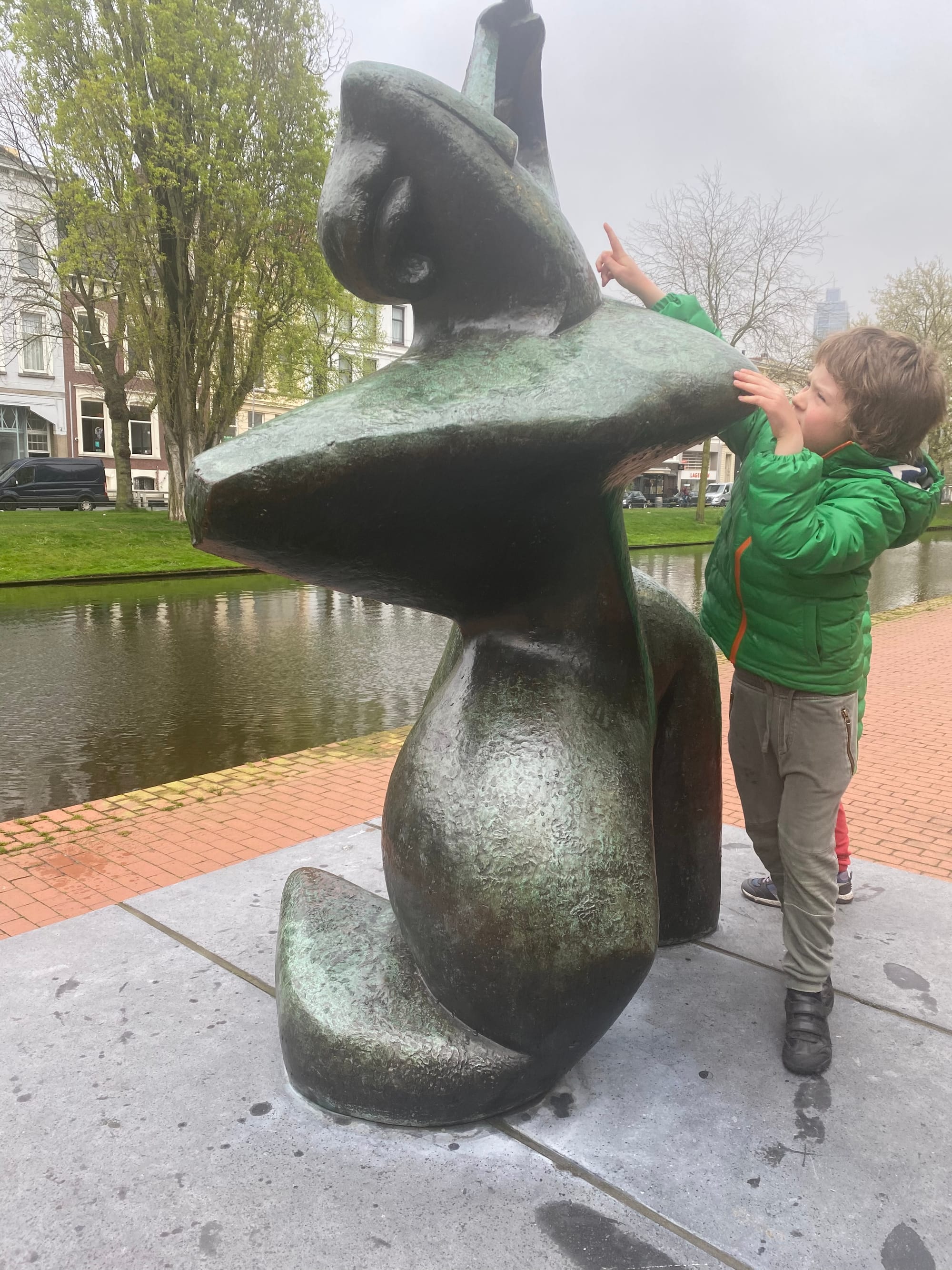
The sheer joy of touching, interpreting… exploring is often under-appreciated on trips with kids. Stopping to investigate unfamiliar street sculptures was a repeat theme of our days in Rotterdam.
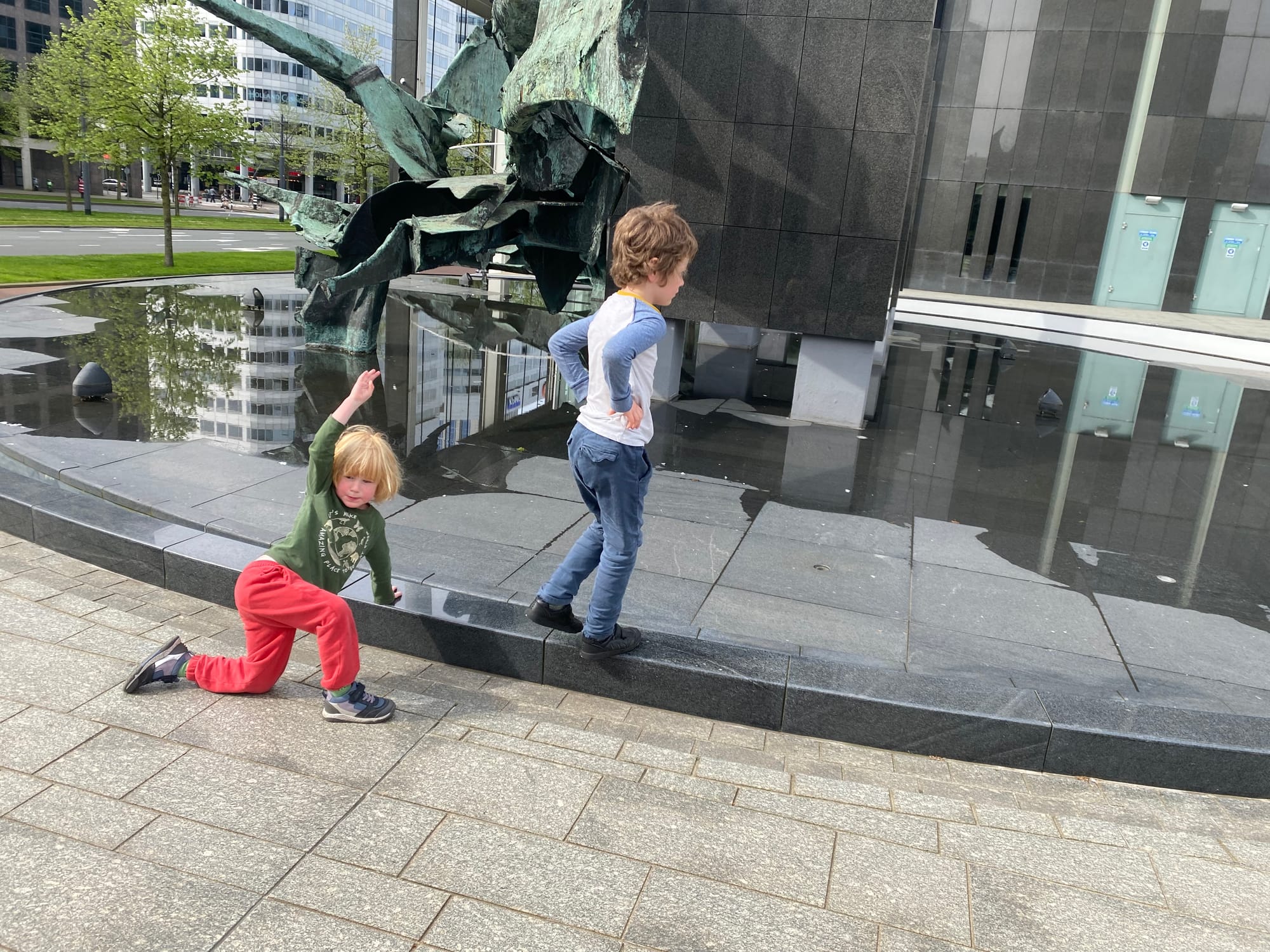
Day Two: Cube Houses, Markthal (market hall) and a boat tour of Rotterdam harbour
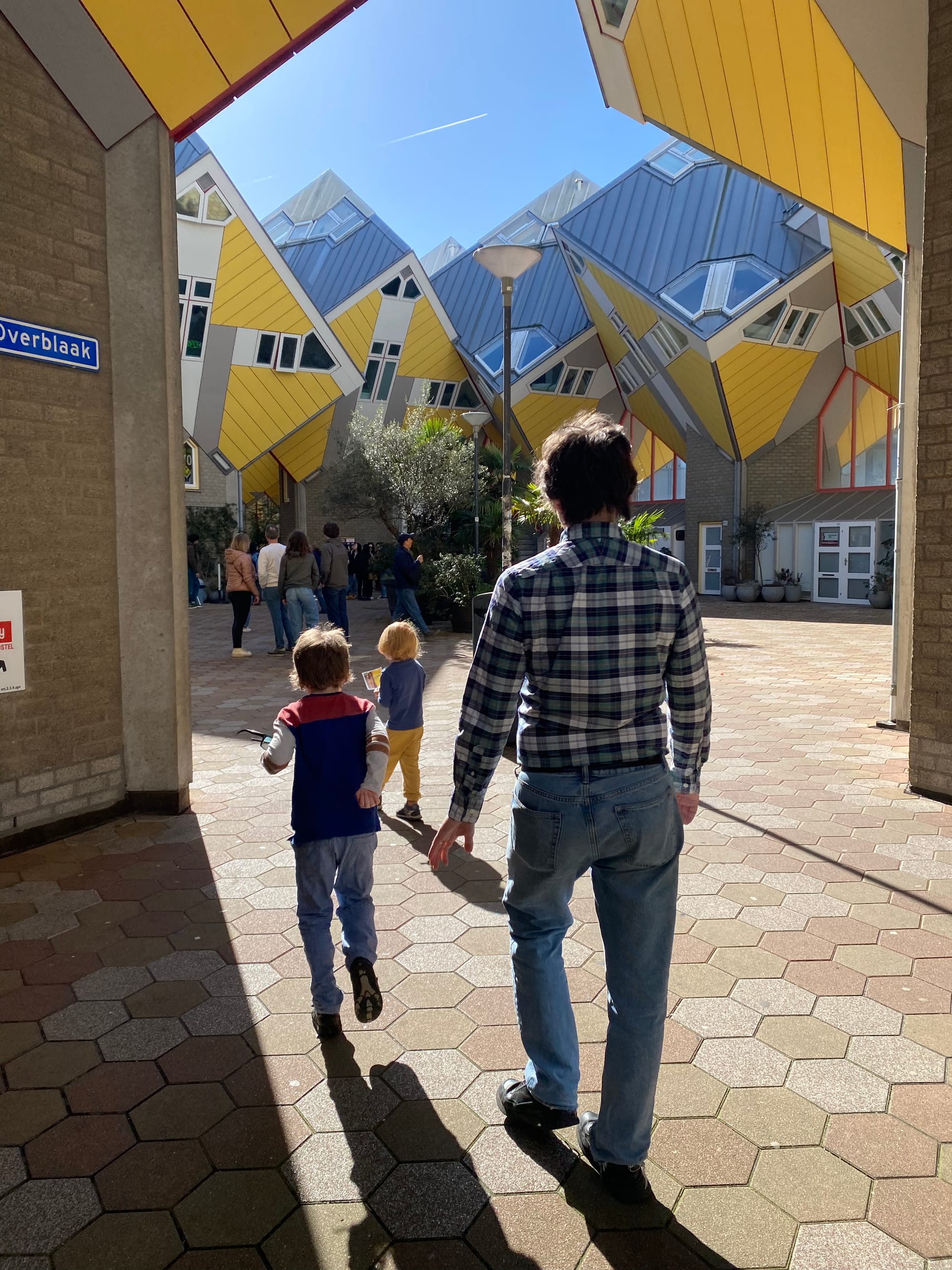
Innovative architecture and young kids don’t normally go together, but Rotterdam’s Cube Houses turned out to be super-fun for all ages. Both boys loved the museum ‘show house’, which has walls slanted at ~55 degrees, meaning all the windows point in different directions.
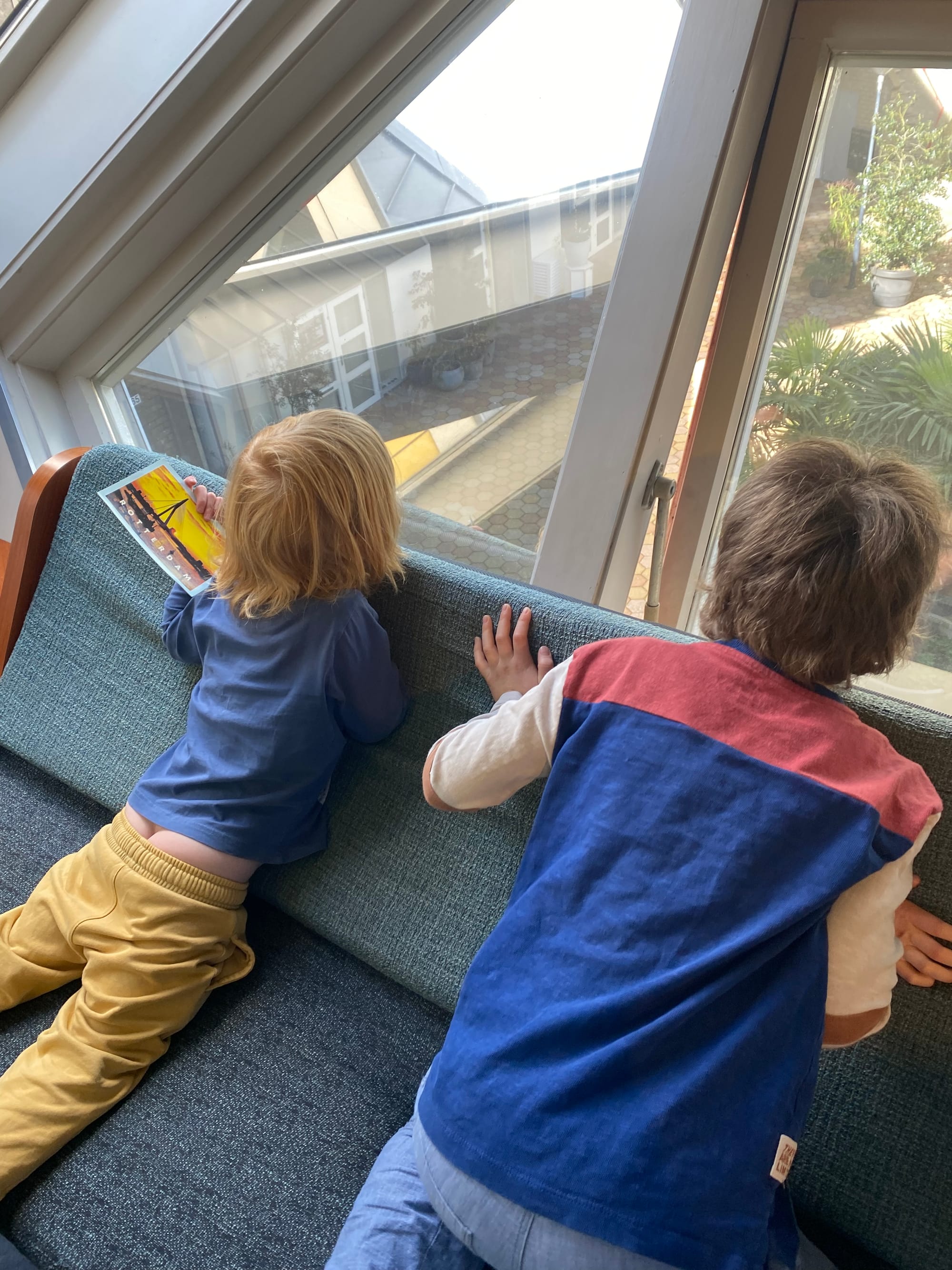
Only one Cube House is open as a museum, for a nominal entry fee (2-3 euros), with the rest being a youth hostel and rental properties. The Museum of Chess Pieces, which we didn’t have time to visit (Bigger Boy likes chess), is also located inside the Cube ’forest’.
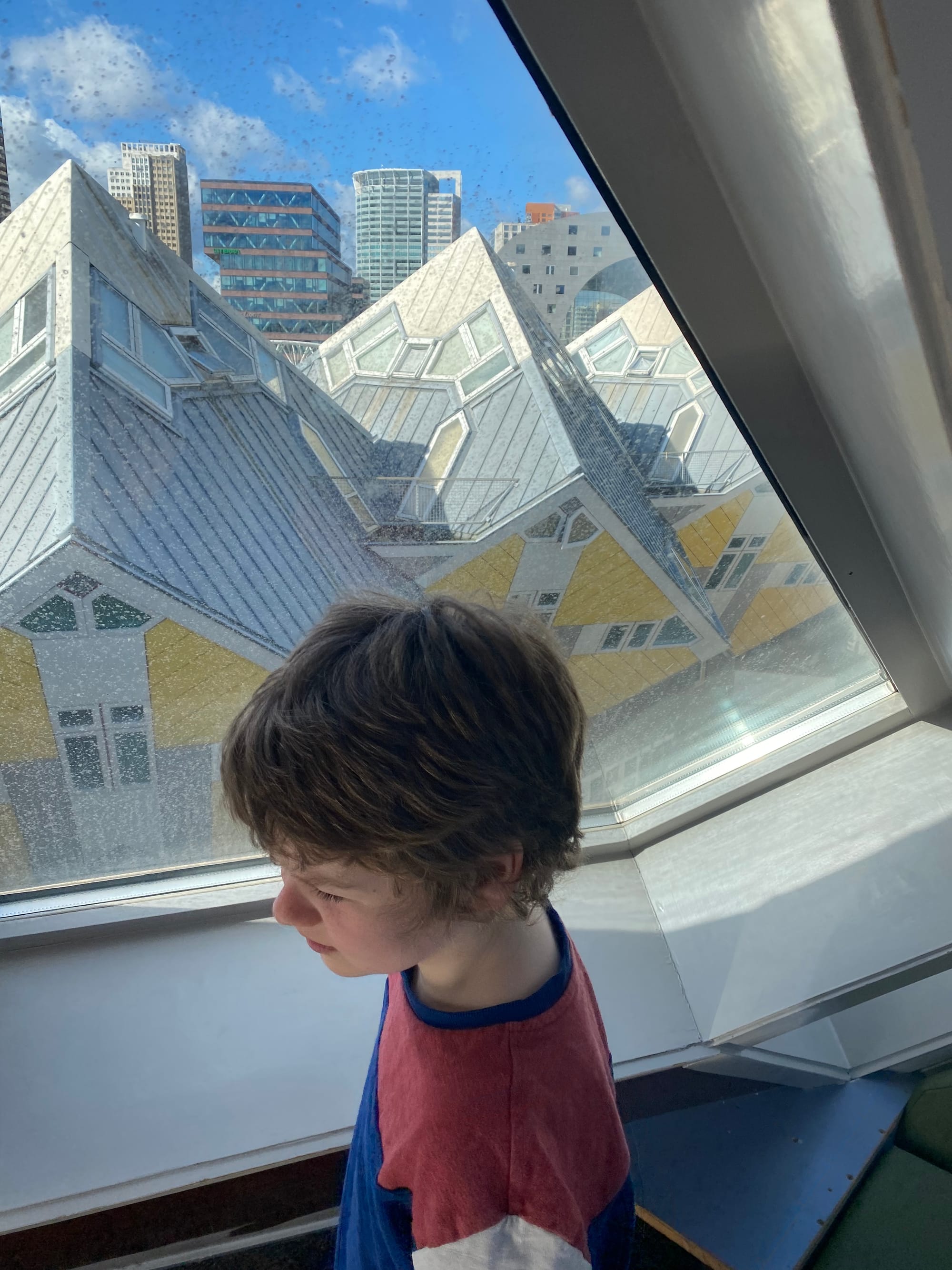
The first courtyard inside the Cube ‘forest’ also has a ice cream shop, and a couple of other shops (inc. a souvenir shop IIRC). If you have mobility issues, the museum house is accessed via a narrow staircase in the ‘trunk’, with more narrow, winding staircases inside the cube itself.
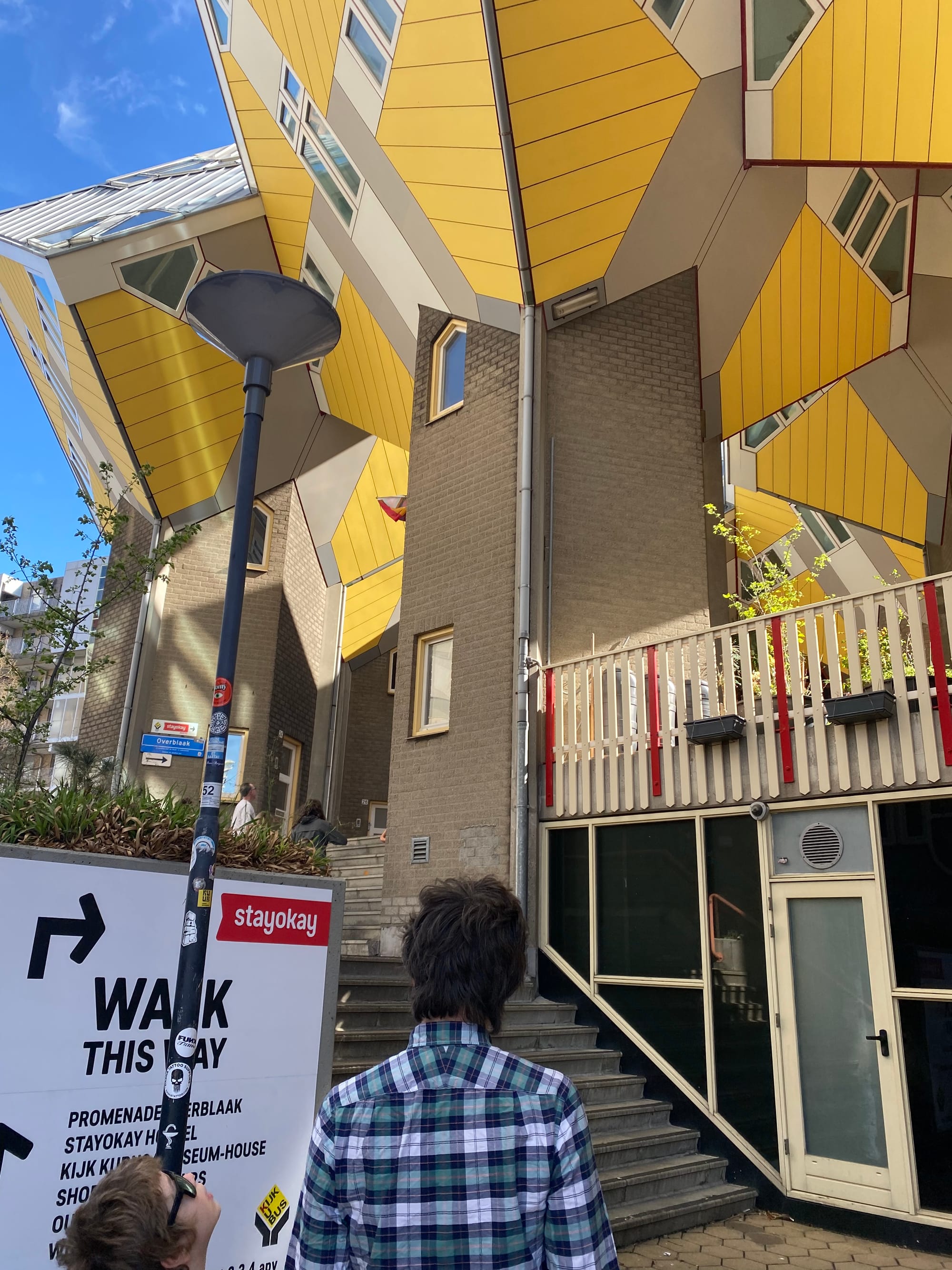
It didn’t cause us much of a problem, but - as with a couple of the attractions - it made us nervous for Smaller Boy, who was climbing things bigger than he was, and my slightly frail mum was worried about a fall.
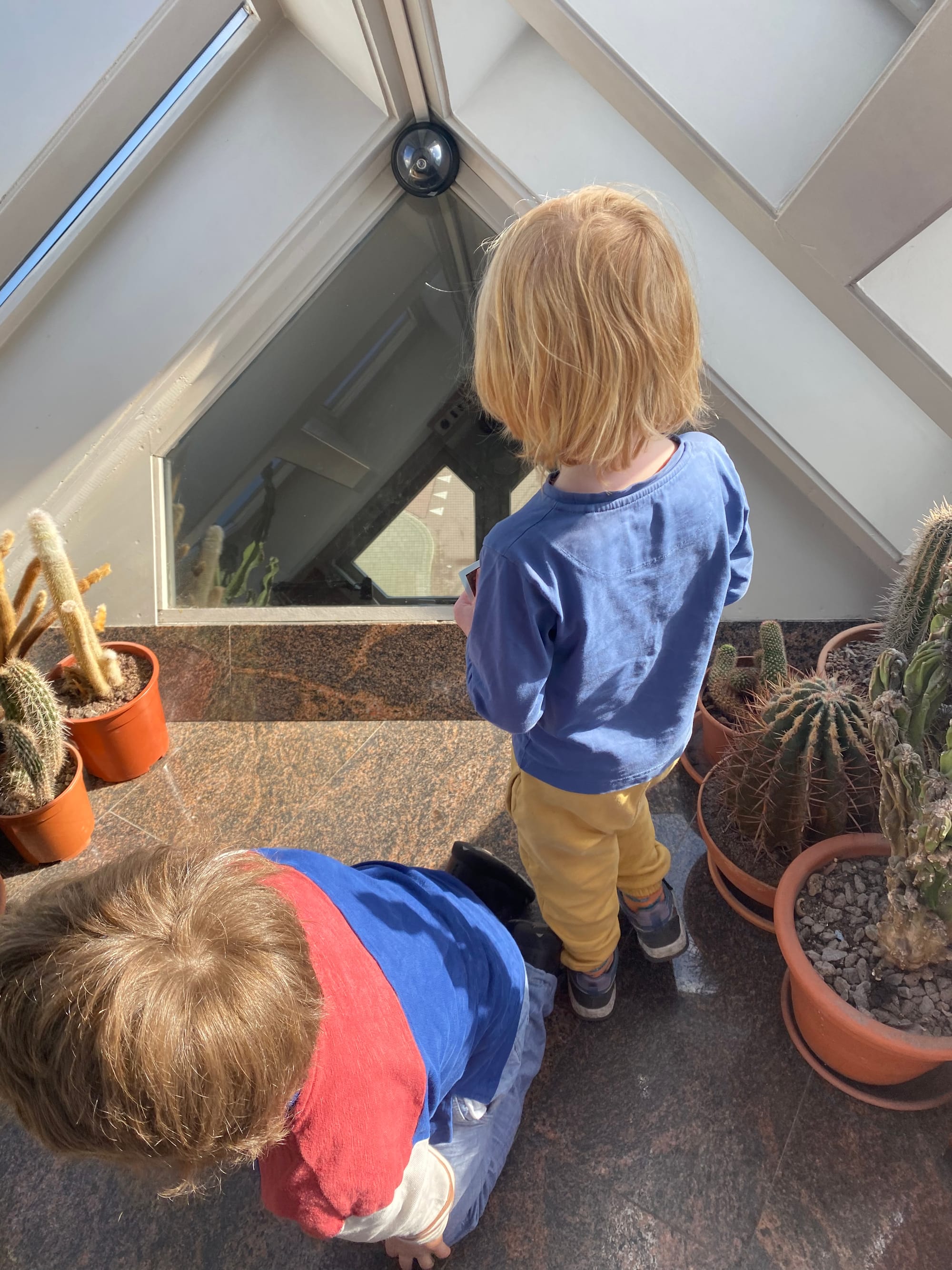
Markthal ‘Market Hall’
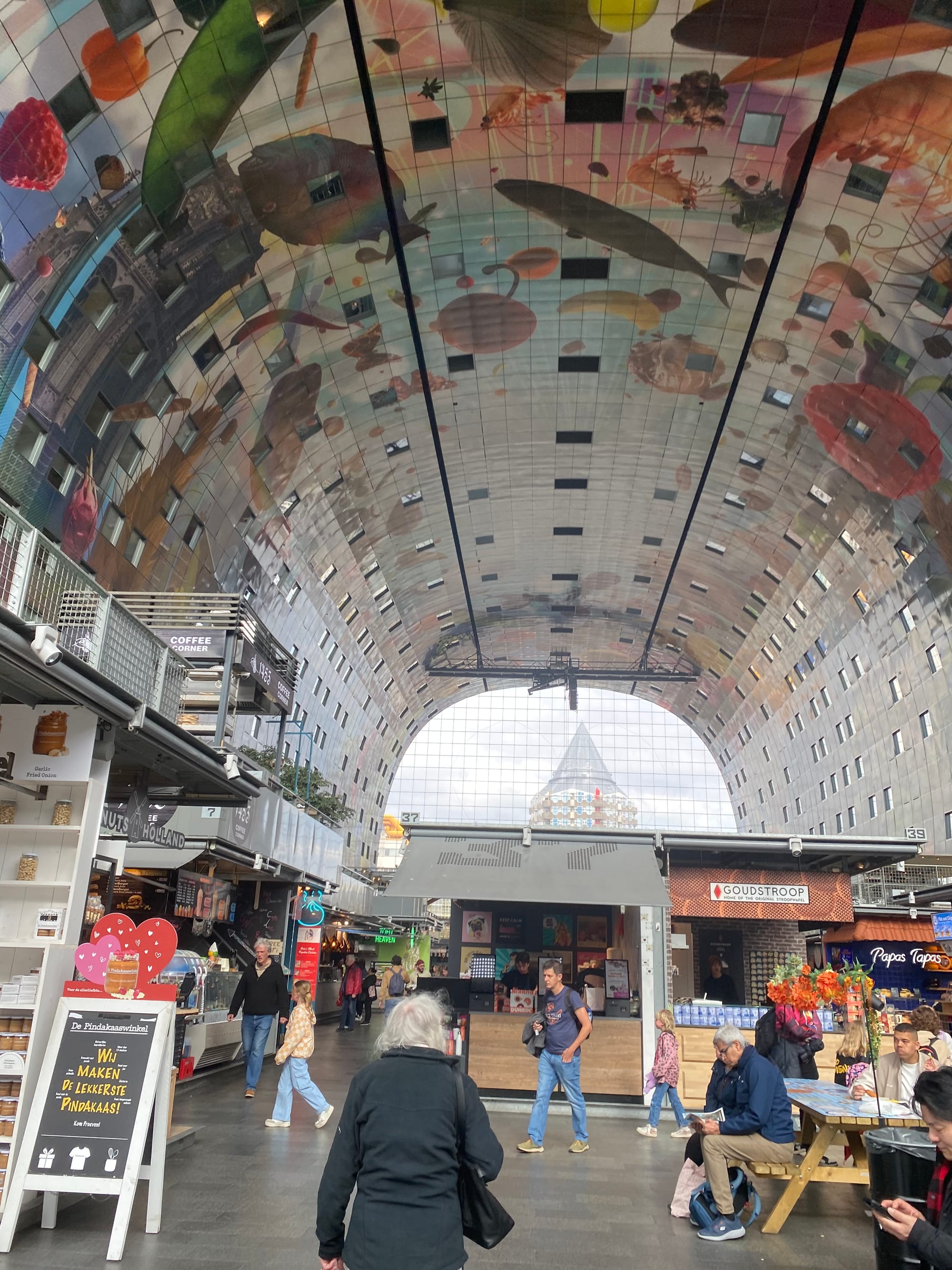
The Market Hall (or ‘tunnel building’, as Smaller Boy insisted on calling it) is an indoor food market across the square from the Cube Houses. It’s worth a quick peek inside for the spectacular ceiling mural, but the only thing it offers to most young kids will be lunch.
We turned up on a Sunday morning to find the market closed, and Bigger Boy didn’t want to come back when it reopened.
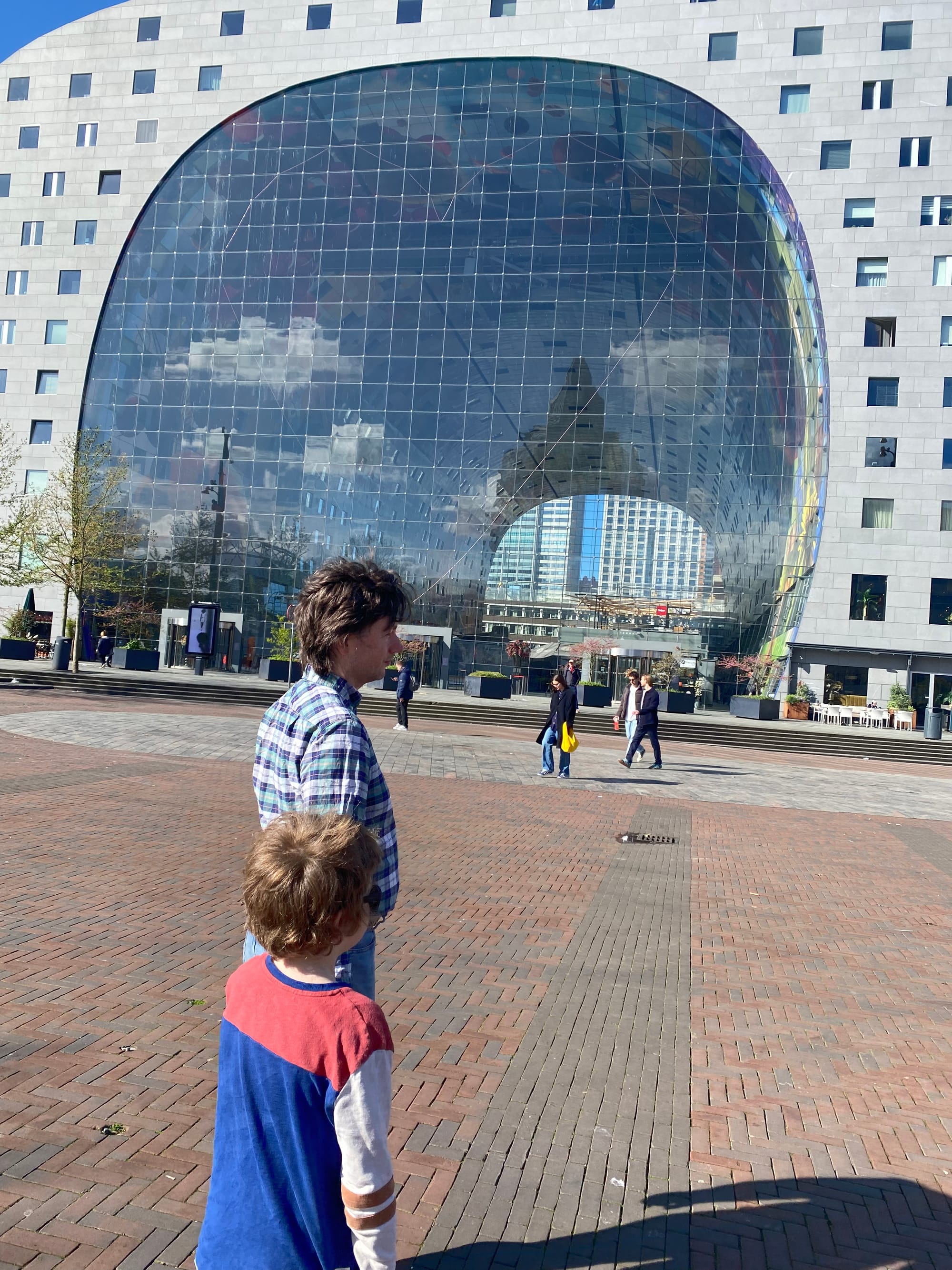
I eventually returned for a quick look at the mural with my mum and she had a quick search for food-related gifts, such as Kruidnoten, a traditional Dutch hard cookie, for sale at the Peppernuts stall.
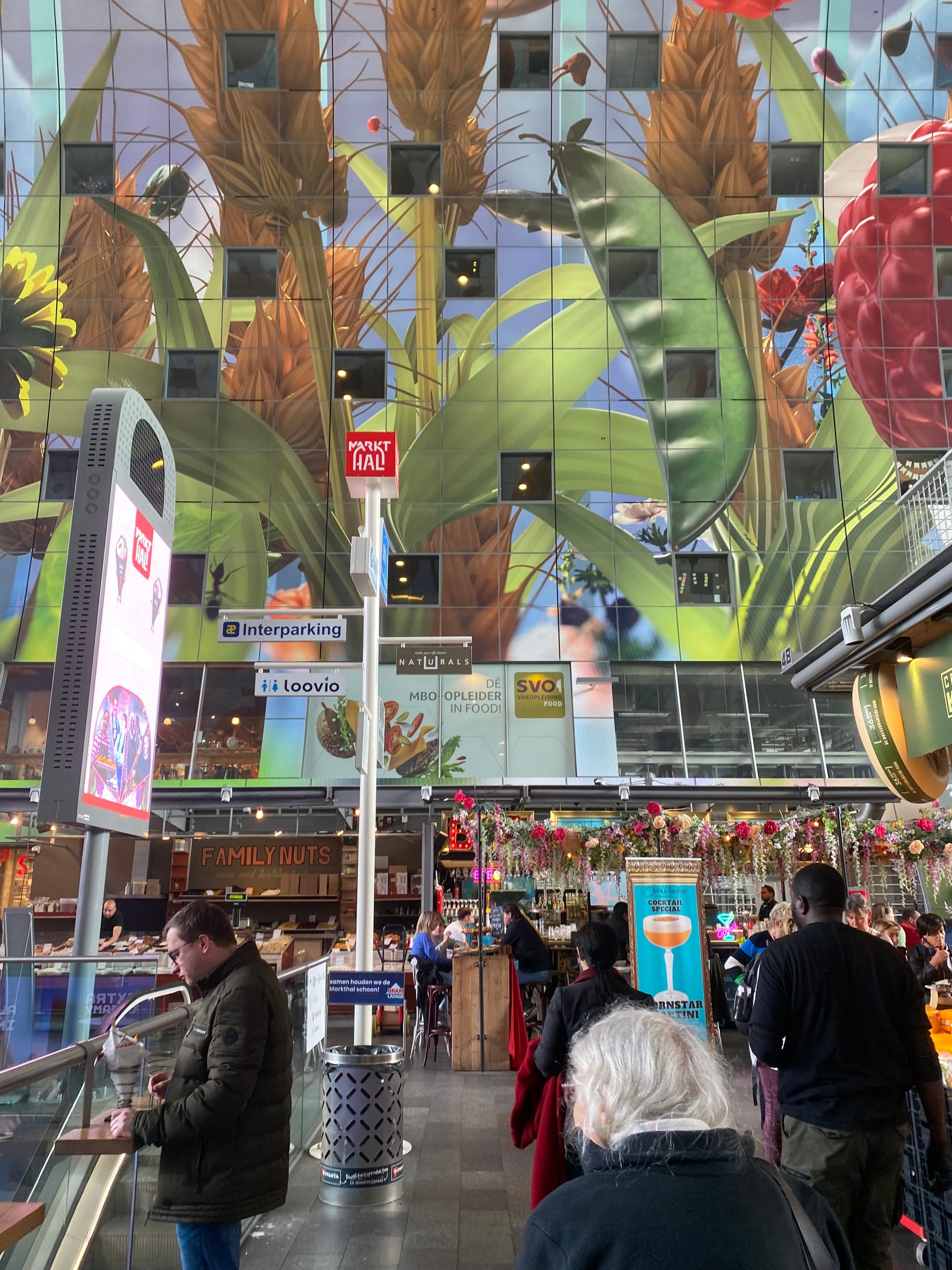
Spido Harbour Cruise

Rotterdam is primarily a port city and, like Amsterdam, has a shape built around water. There are lots of canals, docks and bridges to explore, but one of the biggest water features is the Nieuwe Maas - a massive river that brings the waters of the Rhine, the second longest river in western/central Europe, to the sea.
The historic port of Rotterdam was built along the Nieuwe Maas and, today, you can take boat tours to see the old docks, and the new developments built around them. We went on a Spido harbour tour, which left from a pier next to the Erasmus Bridge.
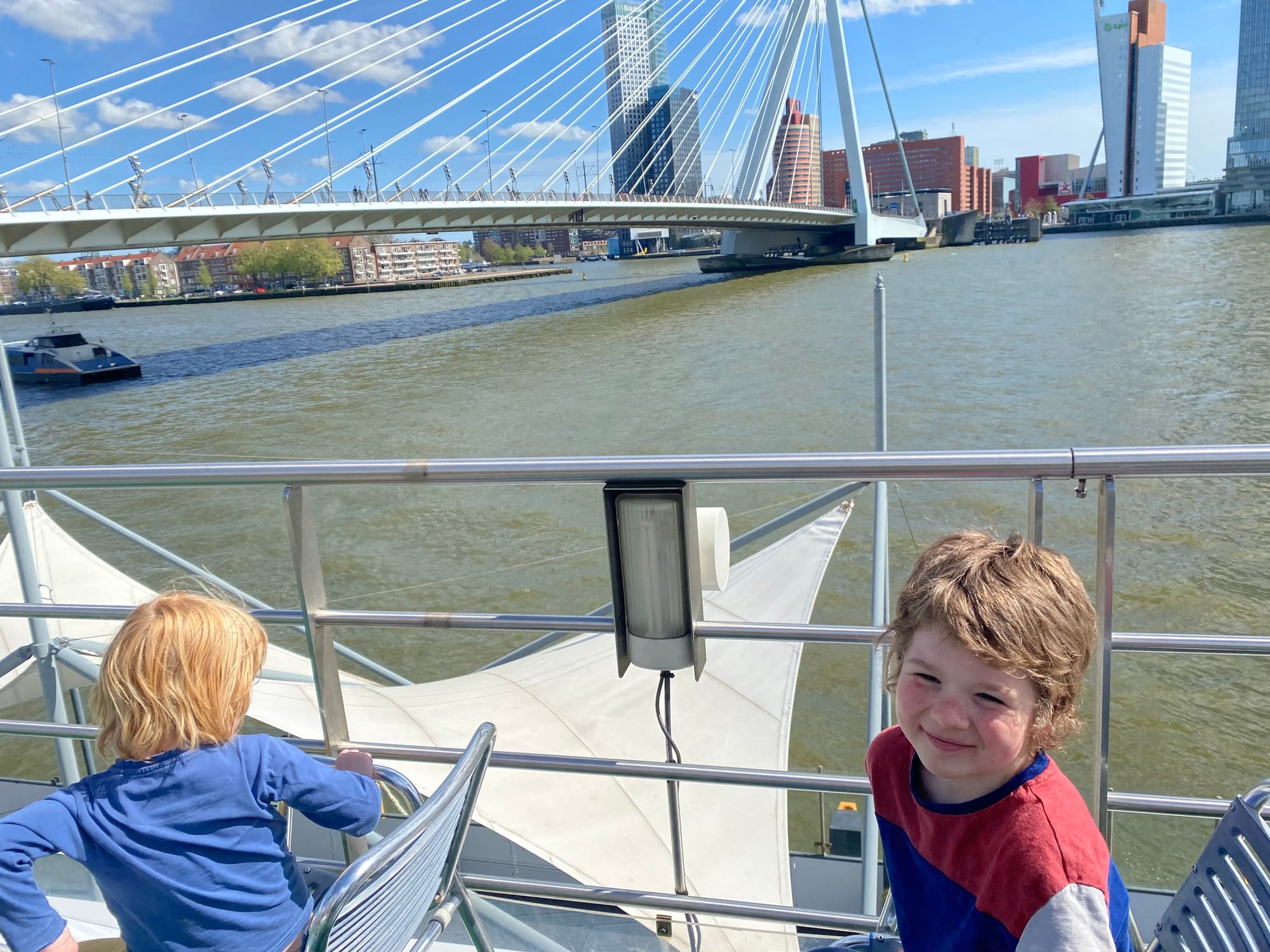
Practical information-wise, it’s important to pre-book your Spido harbour cruise. They are popular, even on a Monday in spring. Our first choice time was sold out when we arrived at the pier (to the great frustration of Bigger Boy).
Bring coats/jumpers/fleeces if you want to sit outside on the viewing deck because the wind on the Nieuwe Maas can be cold. Also, be careful of reflections off the water if it’s sunny. I had to buy emergency suncream because both boys (and my husband) got slightly sunburned.
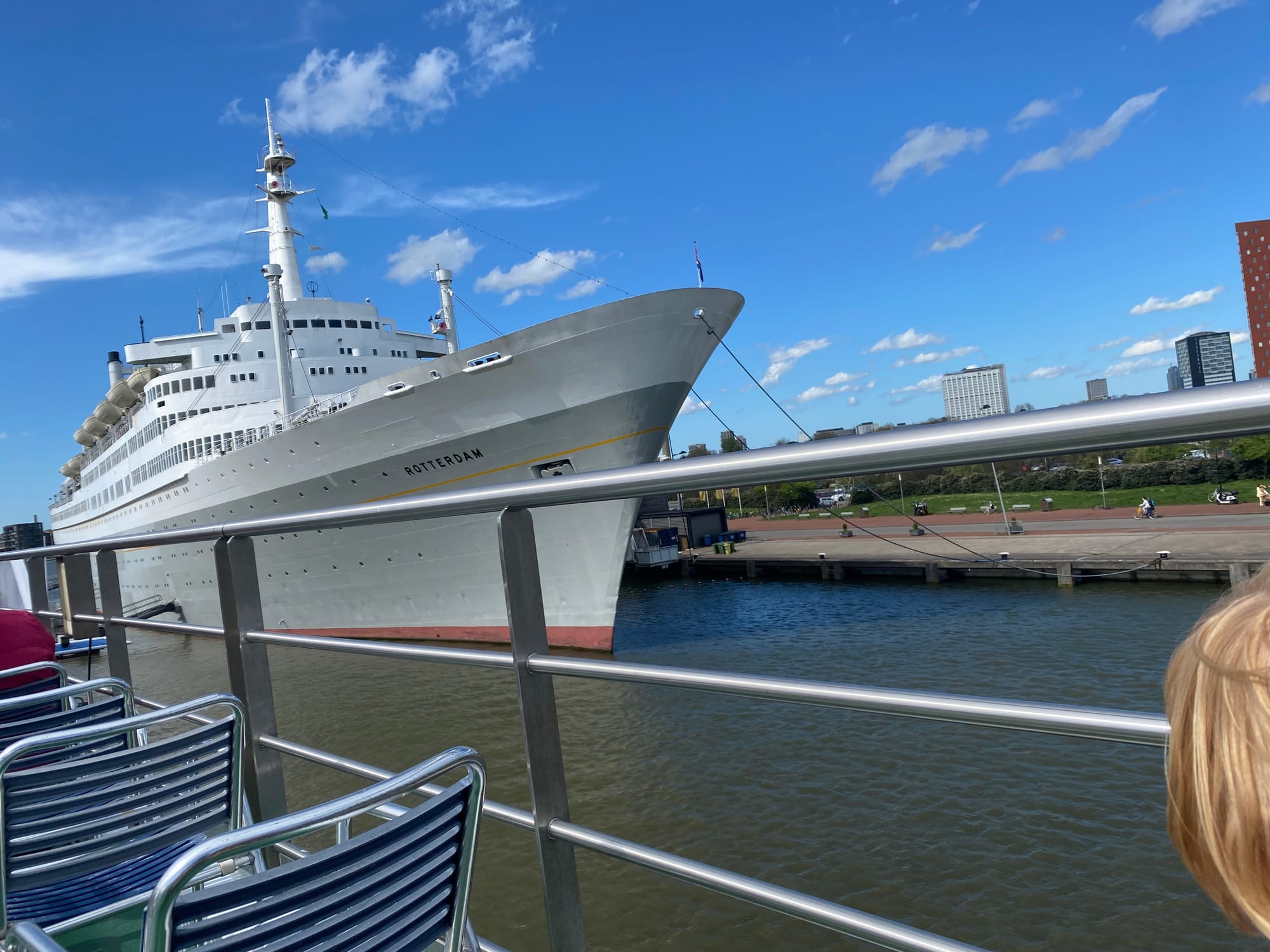
The tour takes in iconic Rotterdam landmarks, such as Hotel New York Rotterdam, Euromast (probably worth a visit if you’re not staying in a 17th floor apartment), and the old sailing ships in the historic Veerhaven area.
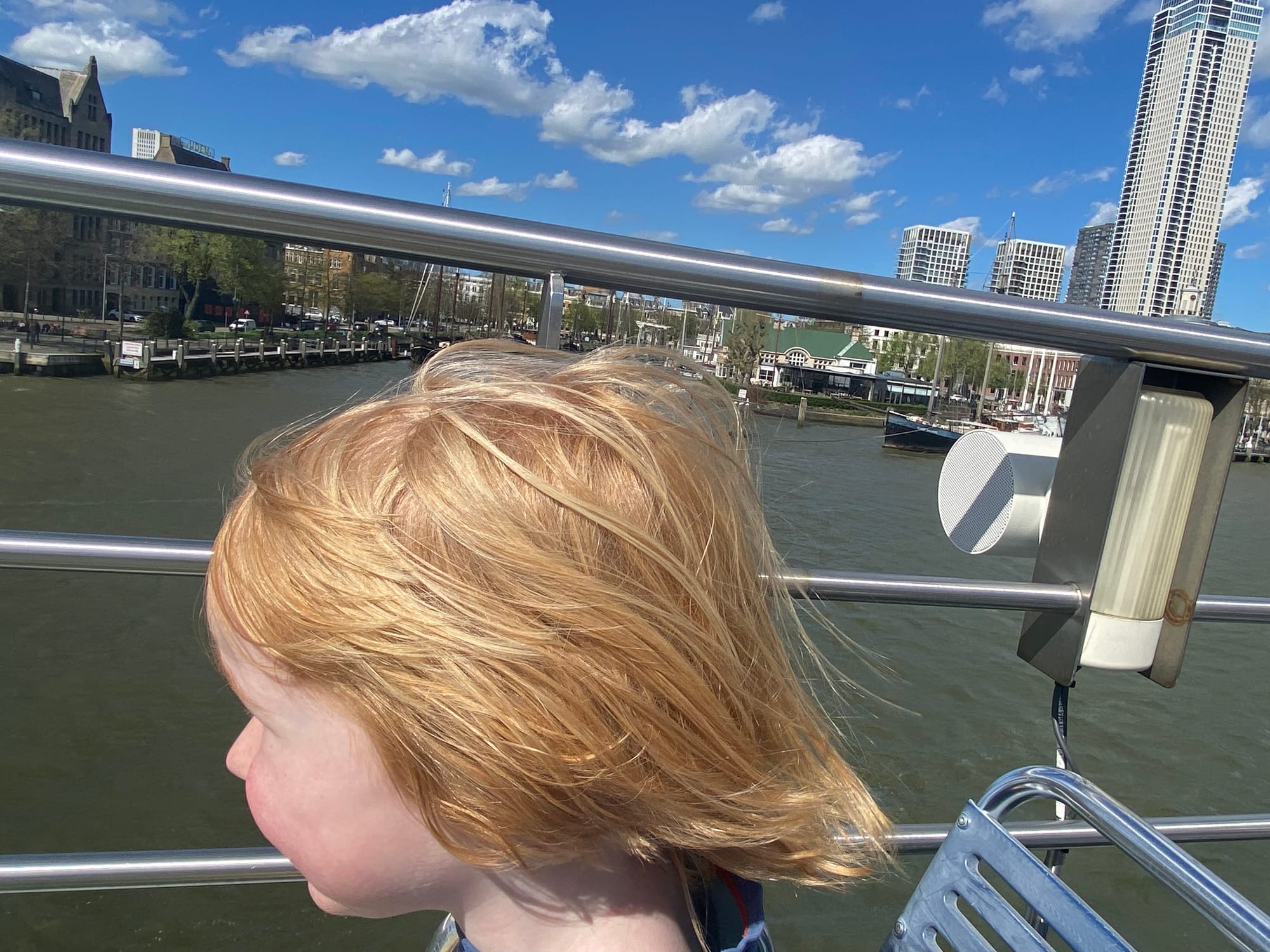
The 75-minute tour doesn’t cover the new port areas (we visited the new container terminals on a different day). My boys largely enjoyed themselves, but about ten minutes before we got back to the Erasmus Bridge they got impatient and cold - despite coats.
In short, the tour was probably about ten minutes too long, at their current ages.
Day Three: Kinderdijk… or Windmills in Old Rotterdam

When Smaller Boy was about two years old, he was obsessed with the children’s song Windmill in Old Amsterdam. It was during the pandemic lockdowns, we couldn‘t travel, but I vowed one day I’d take him to see some real Dutch windmills.
After some investigation, it became obvious the best preserved windmills were not in Amsterdam, but at Kinderdijk, a village on the outskirts of Rotterdam. A UNESCO World Heritage Site since 1997, Kinderdijk is a row of 18th century windmills with an old pumping station and an exhibition on polder drainage engineering.

You’d expect this trip to be radioactive to kids. My boys were almost the only children there. However, if your children are very geeky, Kinderdijk is a great opportunity for a 40-minute outdoor stroll with some engineering/exploring thrown in.
Getting there (and back)
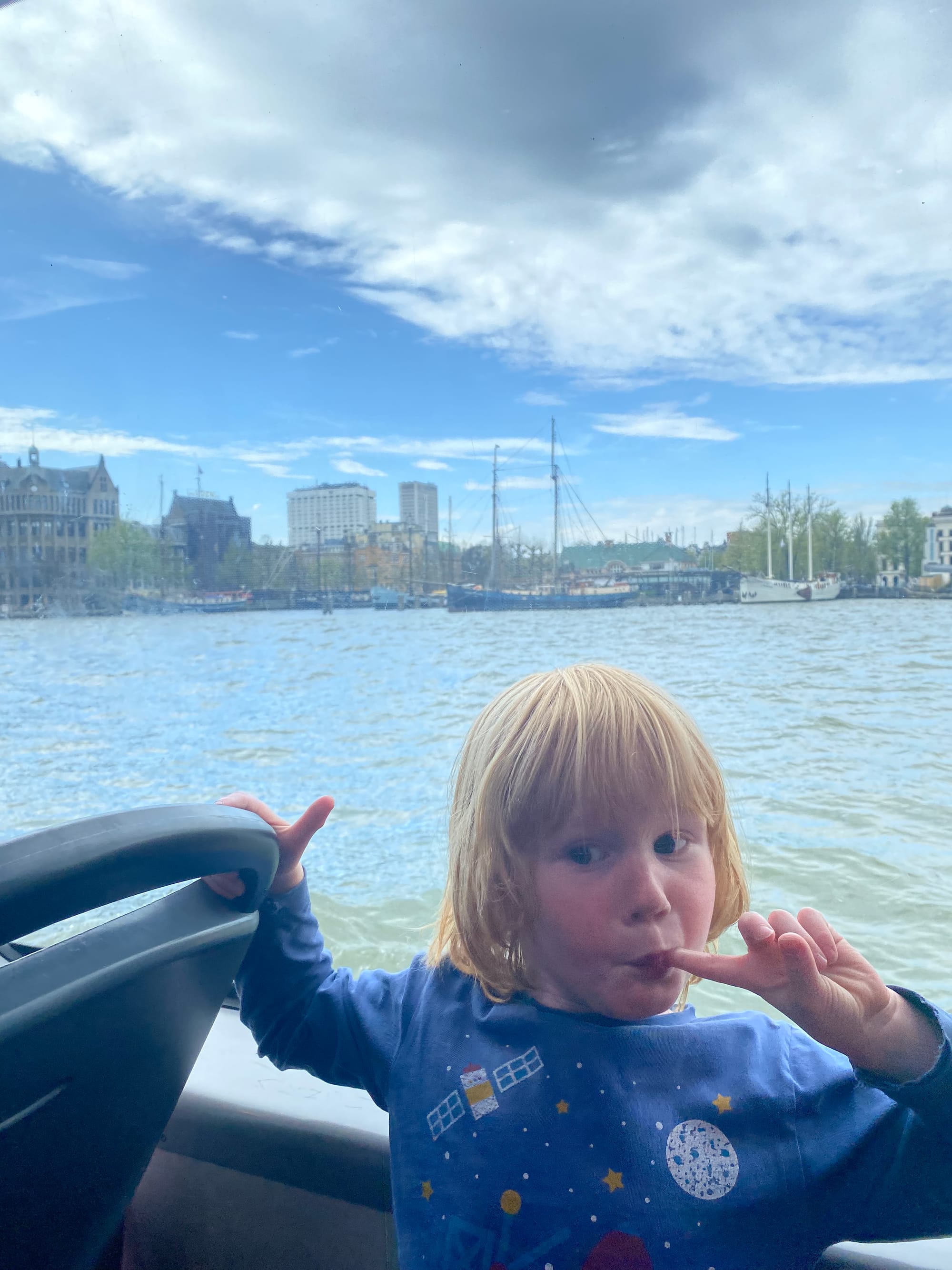
There are a couple of routes for travelling central Rotterdam to Kinderdijk. We chose the most scenic, and tourist-friendly, being the Blue Amigo Waterbus from the Erasmus pier, beside the bridge and Spido harbour tour.
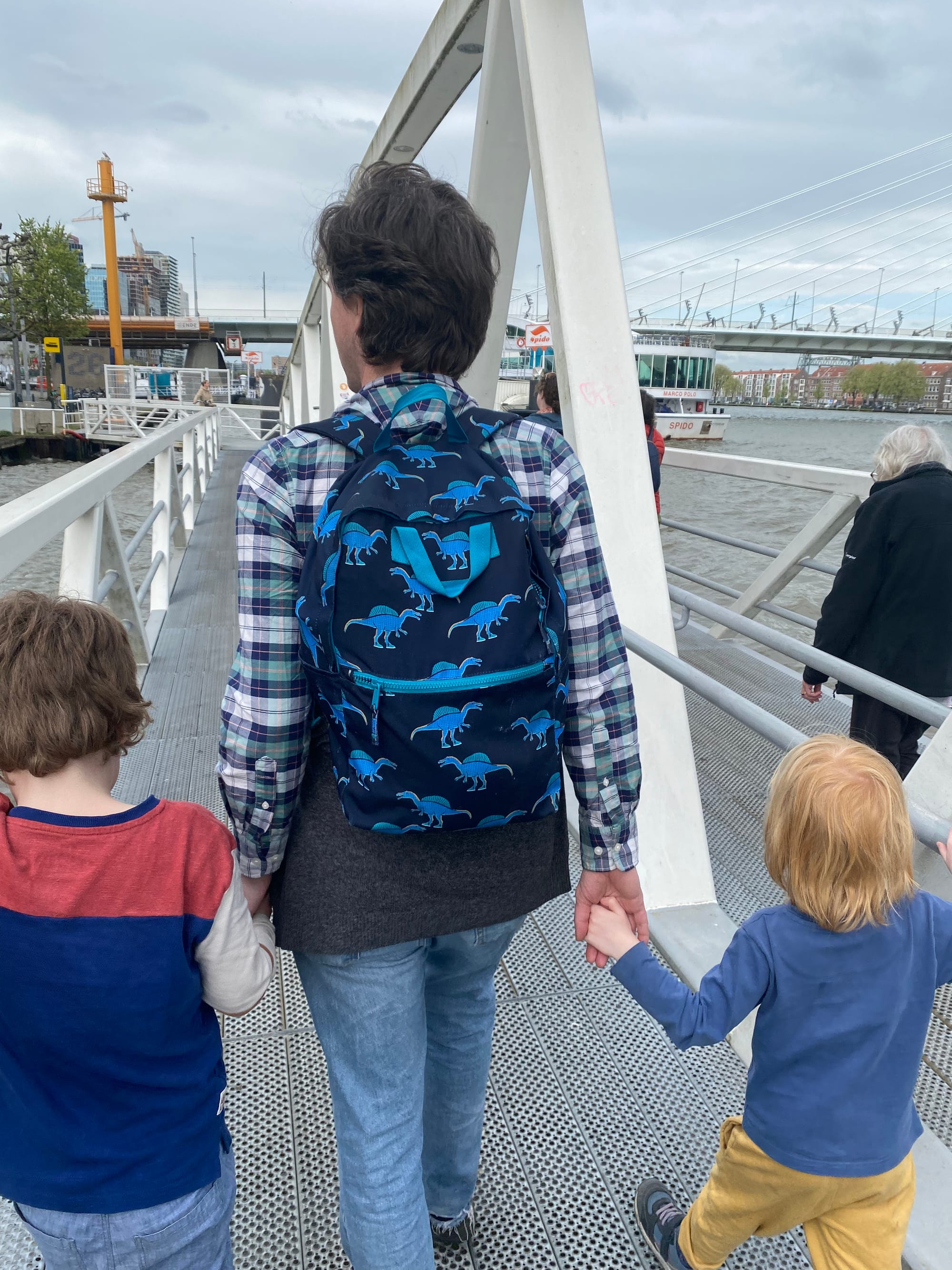
The Waterbus stops at Kinderdijk directly across the road from the visitors’ centre entrance, making it easy to navigate. The only complication is that our Waterbus made an unexpected stop at Ridderkerk, across the river from Kinderdijk, causing us a moment of confusion.

More information on the Waterbus and ground routes can be found in this comprehensive trip guide to Kinderdijk.
Where to eat
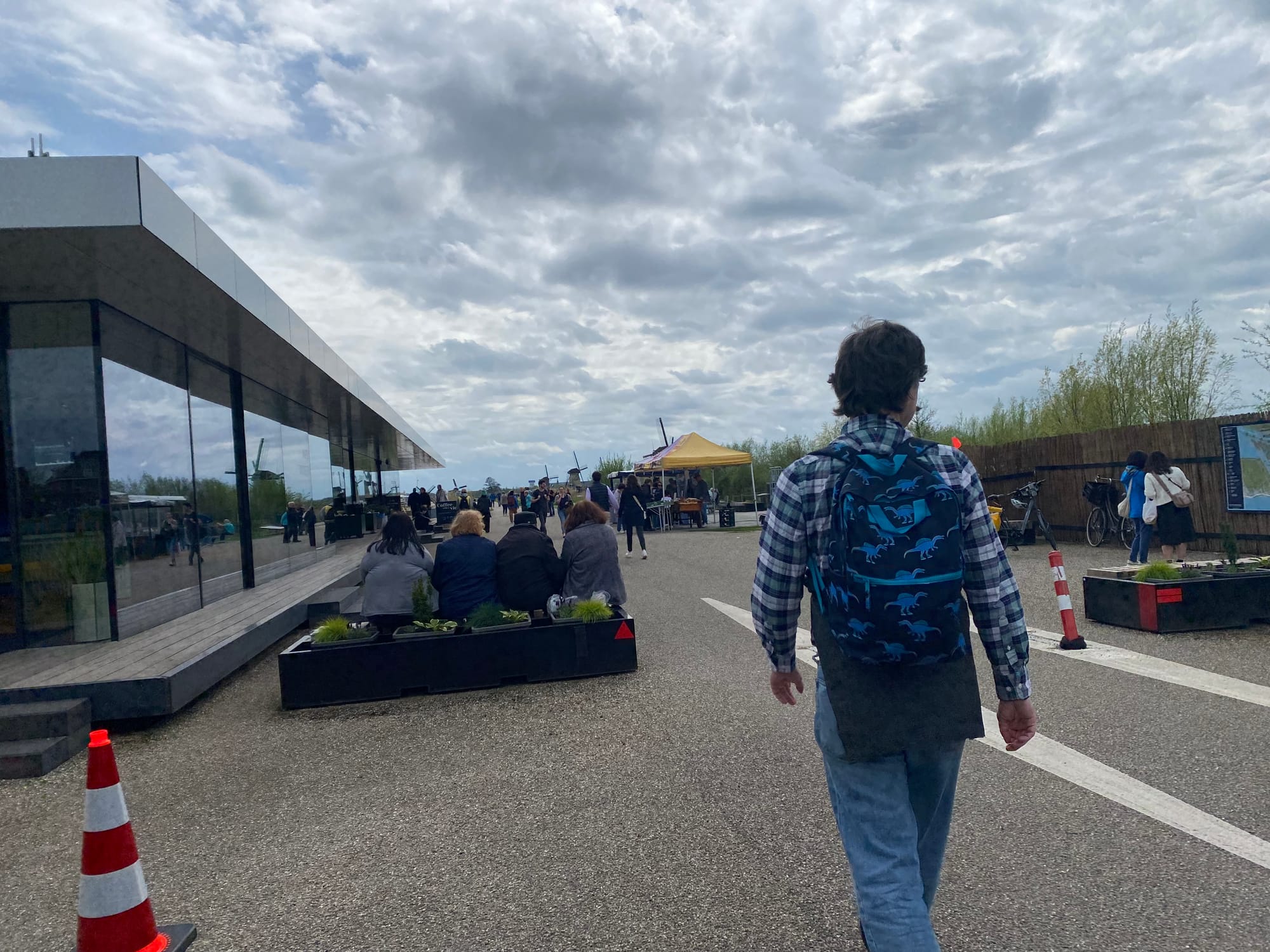
Kinderdijk has multiple eating opportunities on a relatively small site, including a restaurant, a visitor’s centre and an ice cream kiosk. We didn’t eat at any of them, but, instead, brought along (emergency) sandwiches and went to the excellent Bakkerij Stam coffee shop/bakery in Kinderdijk village.

I can’t praise Bakkerij Stam enough, with the proviso that they only sell cakes, sweet pastries, sausage and cheese rolls, and souvenir chocolates. We ordered a selection of teas, coffees, apple turnovers and strudels, chocolate cream puffs, and cheese/sausage rolls, which were all excellent, fresh and - in the case of the rolls and turnovers - warm out of the oven.
The toilets were clean, the cafe was immaculate, and the owner was kind enough to let us eat our homemade sandwiches and water in the tea shop. Not the healthiest meal ever, but I doubt the official Kinderdijk restaurant would have been tastier.
Getting around the Kinderdijk tourist site
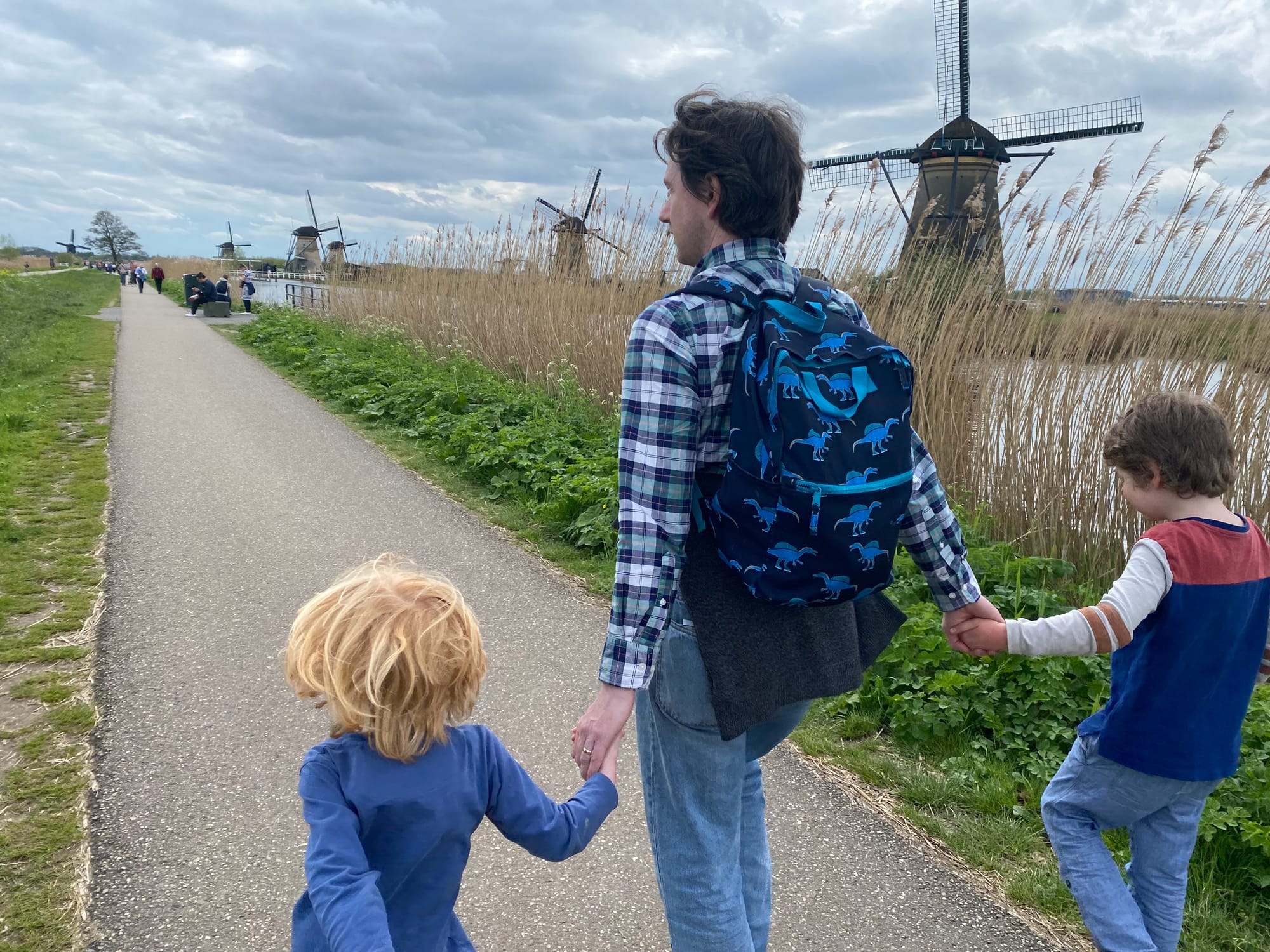
The Kinderdijk site has nineteen windmills built in 1738/1740, spread out along the edge of a canal in the Alblasserwaard polder. Only two windmills are open to the public, and it takes about twenty minutes to walk from the restaurant to the furthest museum windmill.
There’s a bike path if you want to cycle to (and beyond) the museum windmills, and also a couple of ferries running up and down the canal, carrying people to and from the windmills. The site is super flat, with tarmac down the bike lanes, so the boats aren’t really necessary, even if you have a pushchair or are a wheelchair user.
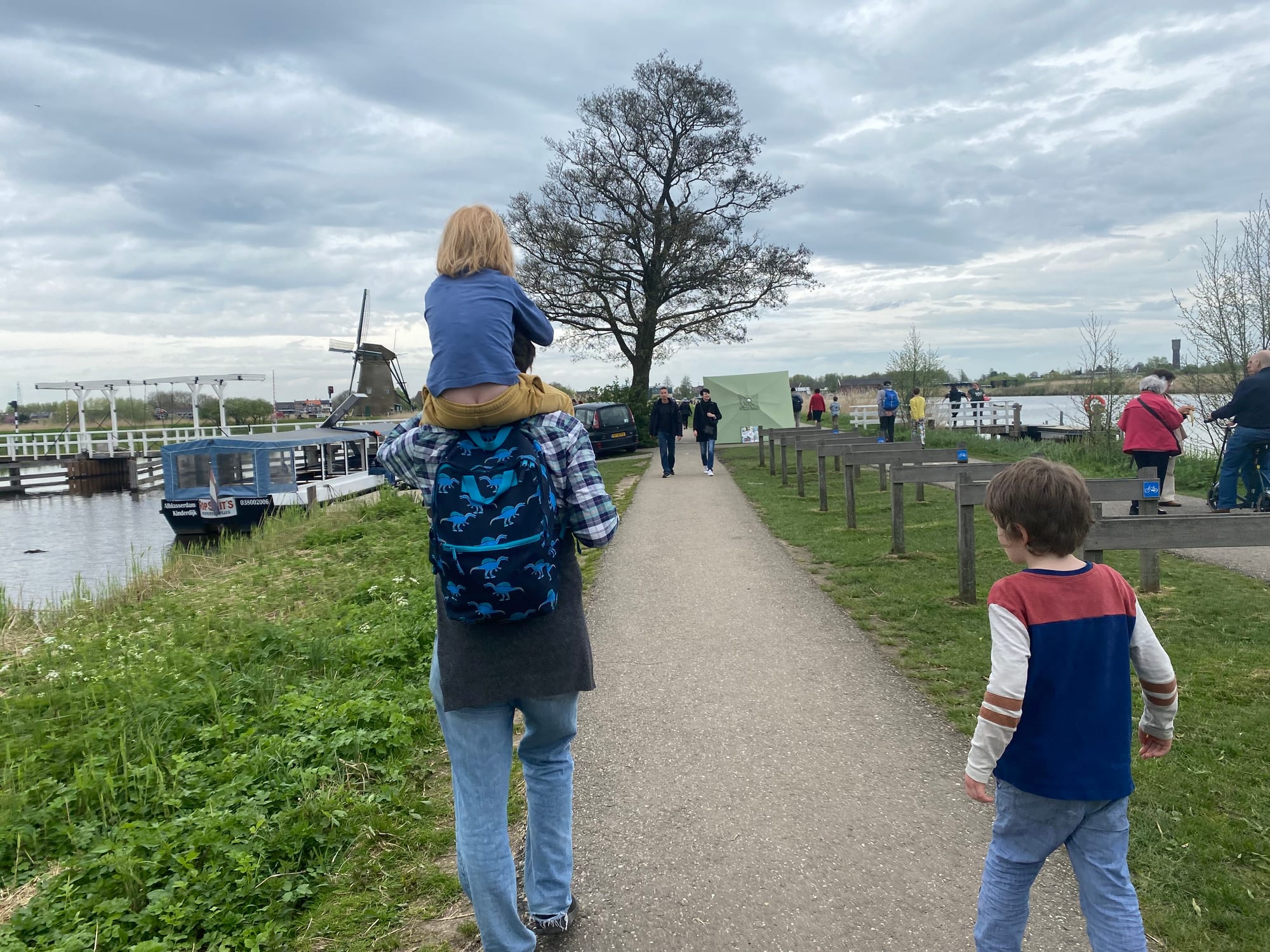
There was a cruise liner visiting Kinderdijk when we were there, and I saw several older people with mobility scooters using the bike lanes and footpaths to navigate the site.
Visiting the further (museum) windmill
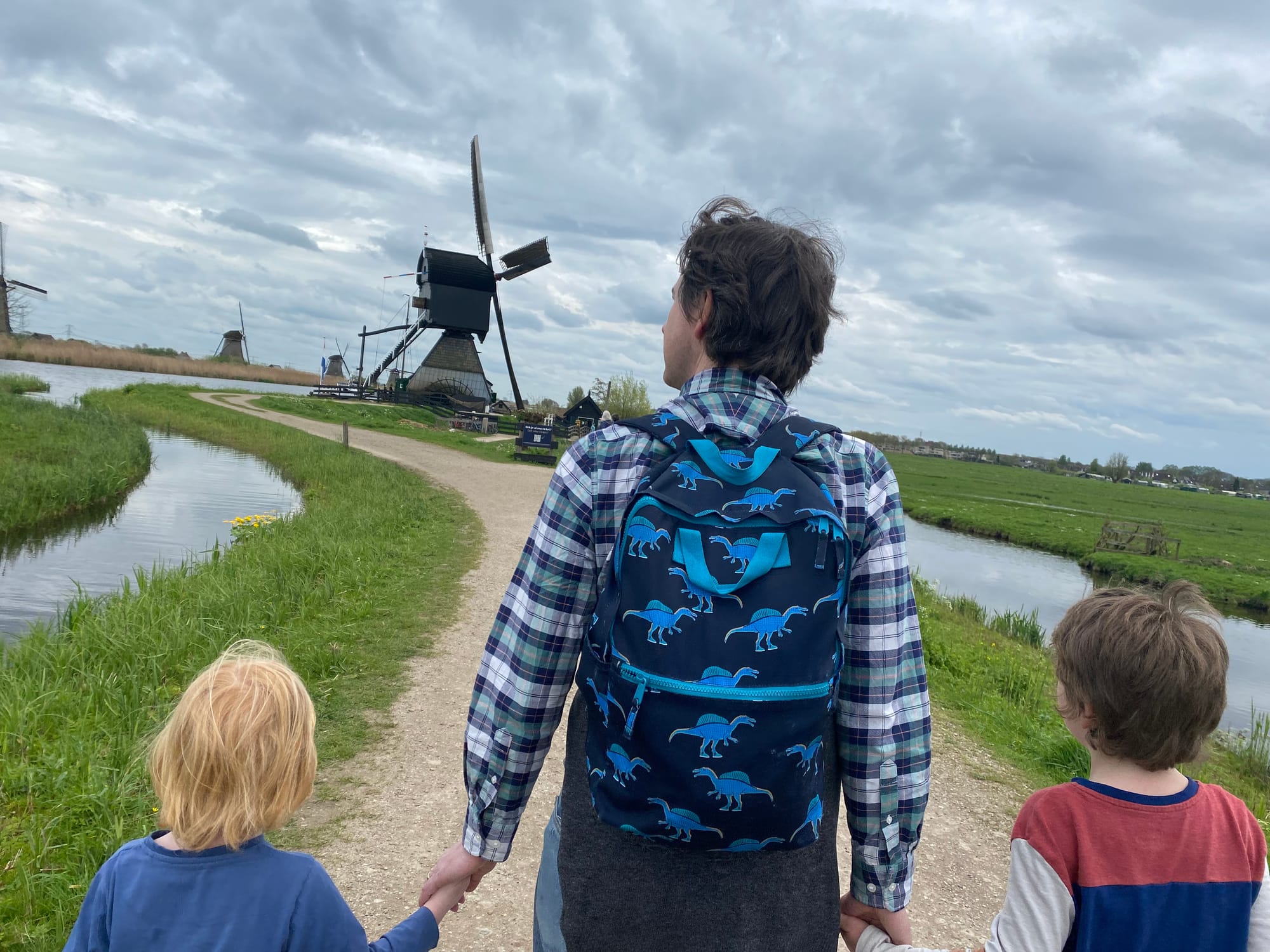
We visited the furthest windmill first, in the hope it would be less crowded. It had working sails when we visited, along with the opportunity to go inside the ground floor, which was furnished as a historical house.
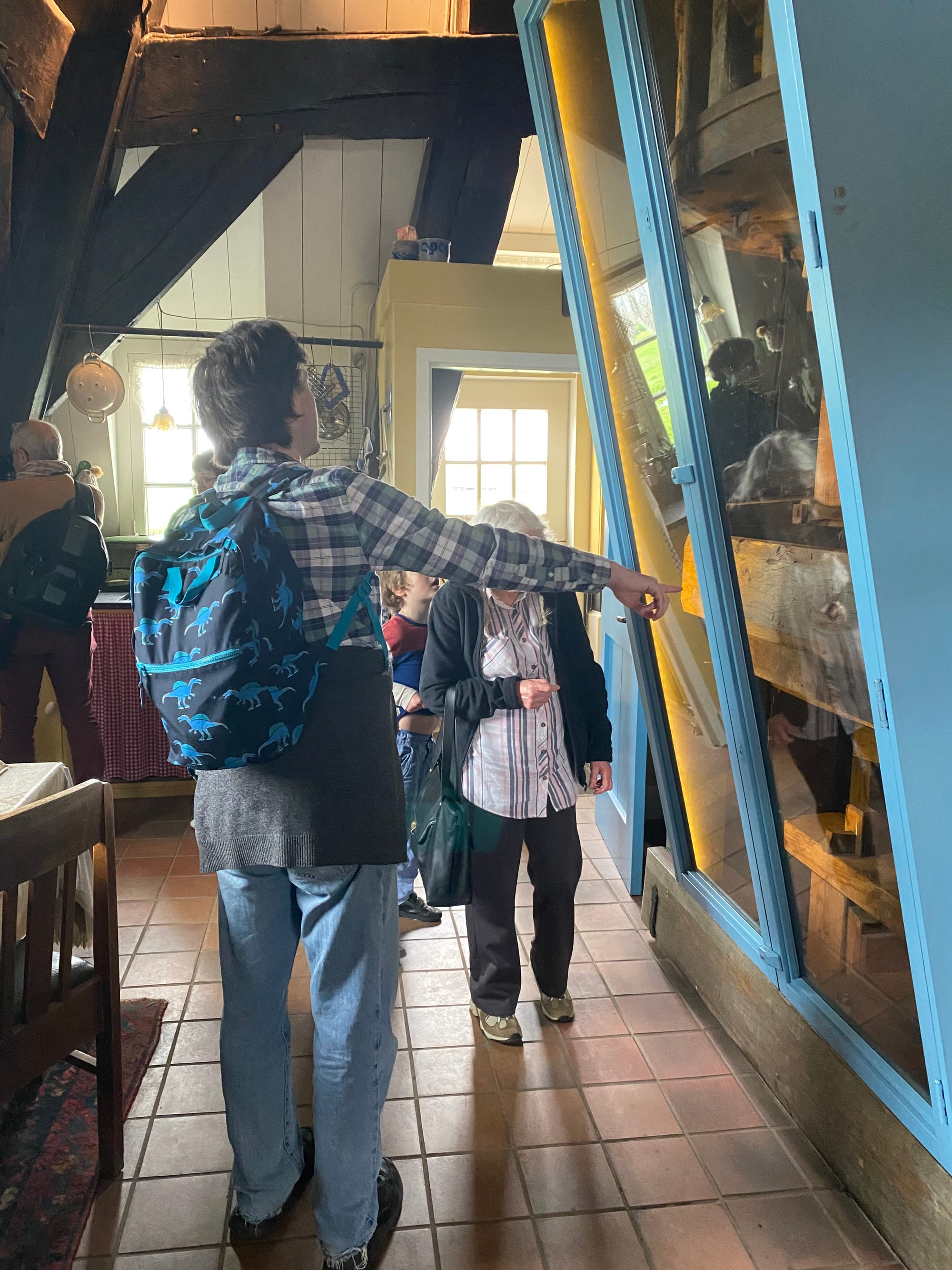
Outside the windmill was a kitchen garden along with an outdoor toilet, fireproof kitchen, and other outbuildings that would have served the mill family.
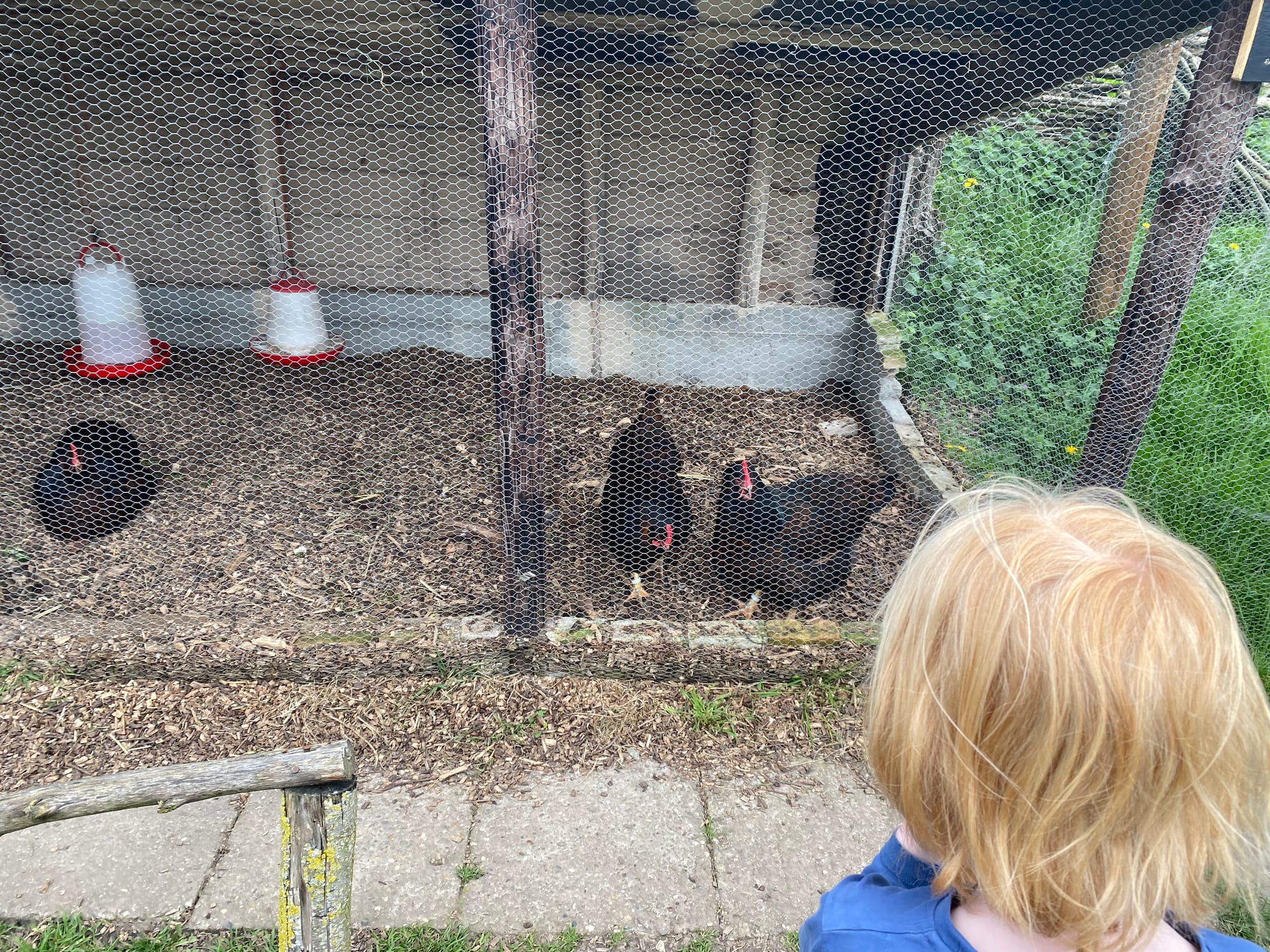
The boys enjoyed the turning sails, the model of the windmill, and exploring a canal boat moored alongside.
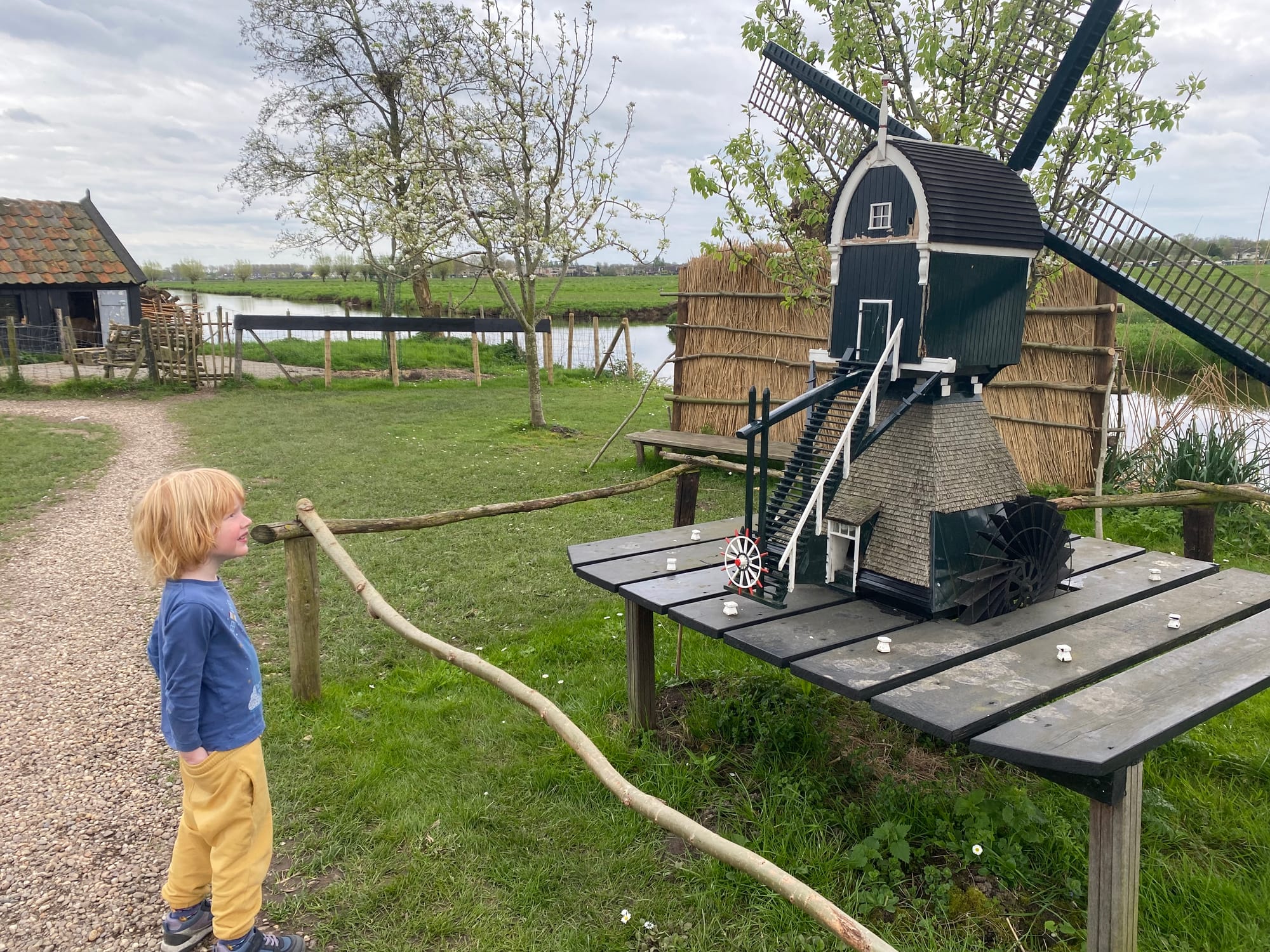
The furthest windmill was not wheelchair accessible, due to a couple of steps. The canal boat was accessed via a ricketty gangway and had a steep ladder down into the cabin. Bigger Boy refused to go into the cabin because it was dark with a low ceiling, and my husband had to lift Smaller Boy down the ladder.
Visiting the closer windmill
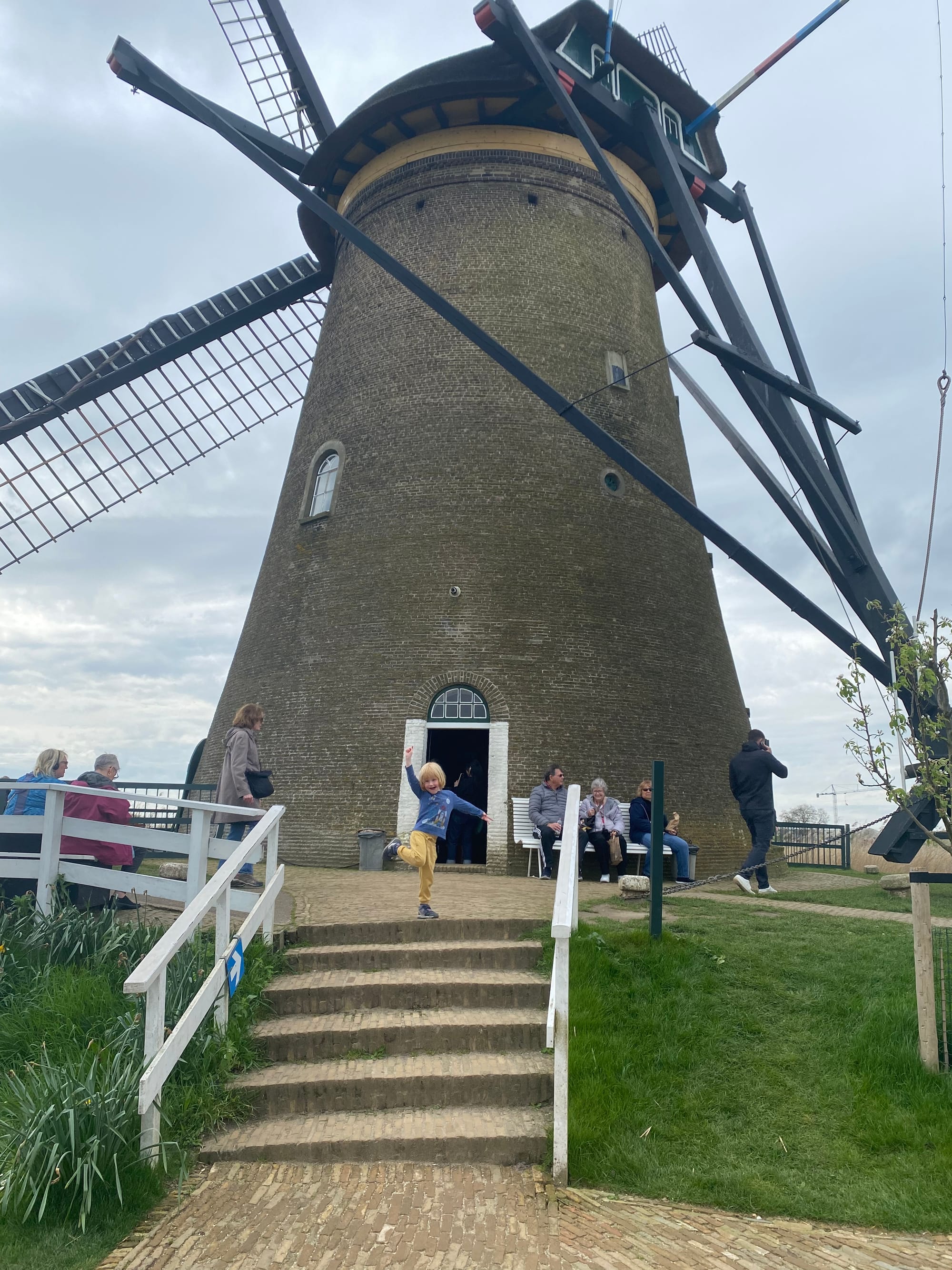
The museum windmill closest to the visitor’s centre was built later than the furthest windmill. Three storeys high, a family of fifteen lived there at one point, and it has a kitchen, some bedrooms and the windmill mechanism to visit.
We arrived at the same time as a Viking river cruise, which created an enormous queue to get into the windmill and overcrowding for the ladders inside. At one point, Bigger Boy panicked in the darkness, and I had to beg an older lady to let him go down before her.
The old pumping station

The old pumping station across the bridge from the visitor’s centre had a couple of great exhibits for geeky kids, including a four-person windmill management game, and a big wooden marble run.
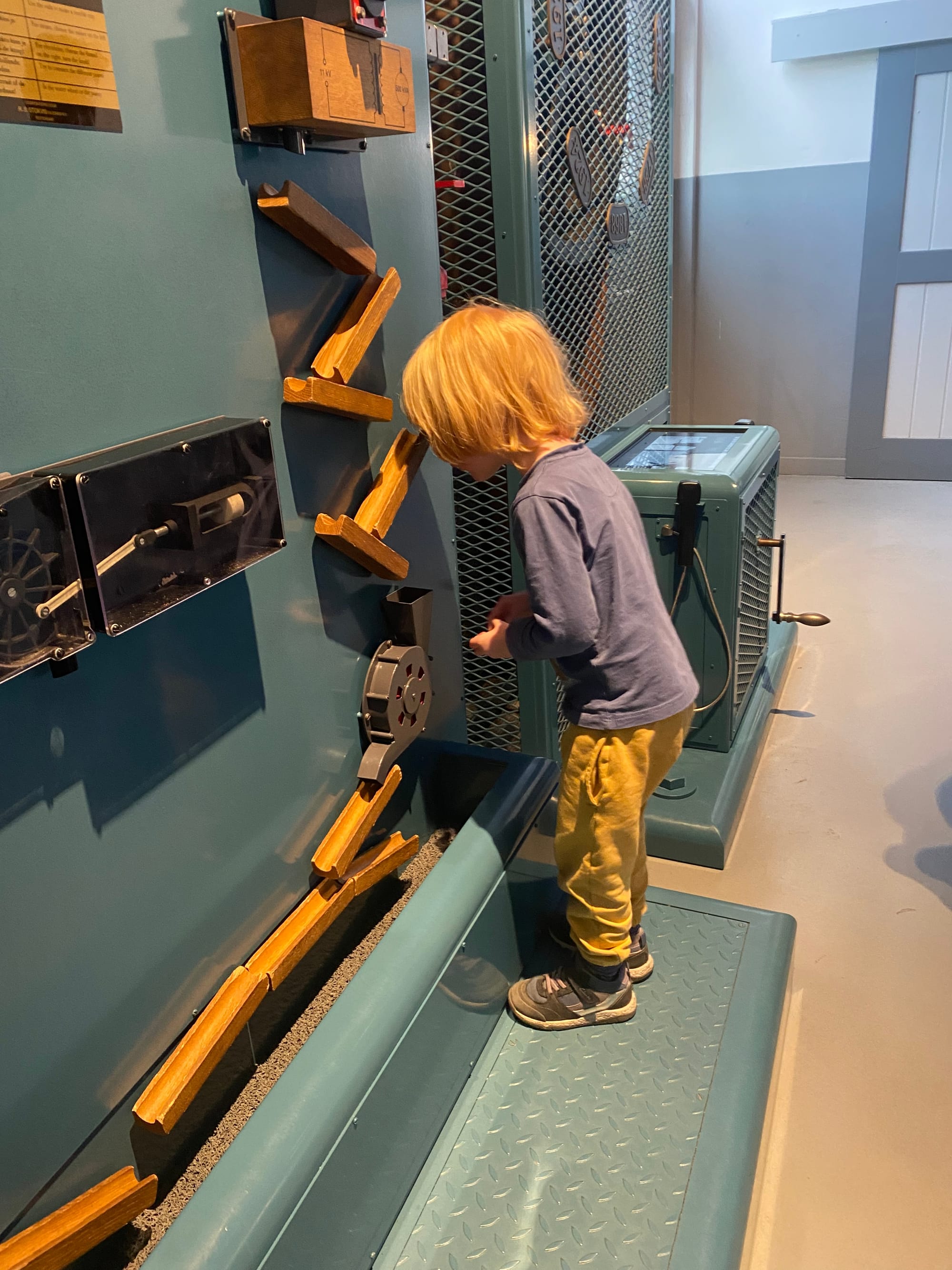
Both boys had a super time turning their windmills towards the prevailing wind, setting up the magnetic wooden ramps, and testing their marble runs. I think the marble run was supposed to be an exhibition about water flow, water wheels or pump machinery… but any lessons got lost in the excitement.
Day Four: Bodyworlds and the Nemo Science Museum, Amsterdam

Day Four was supposed to be a trip to Rotterdam port, but we went to Amsterdam instead. Our trip was mostly focused on the interests of Bigger Boy, who wants to be a medical researcher when he grows up. For this reason, it’s quite different from most Amsterdam guides, which are usually all about art galleries, tulips and legal cannabis (none of which appeal to our kids, thankfully… yet).
Getting there
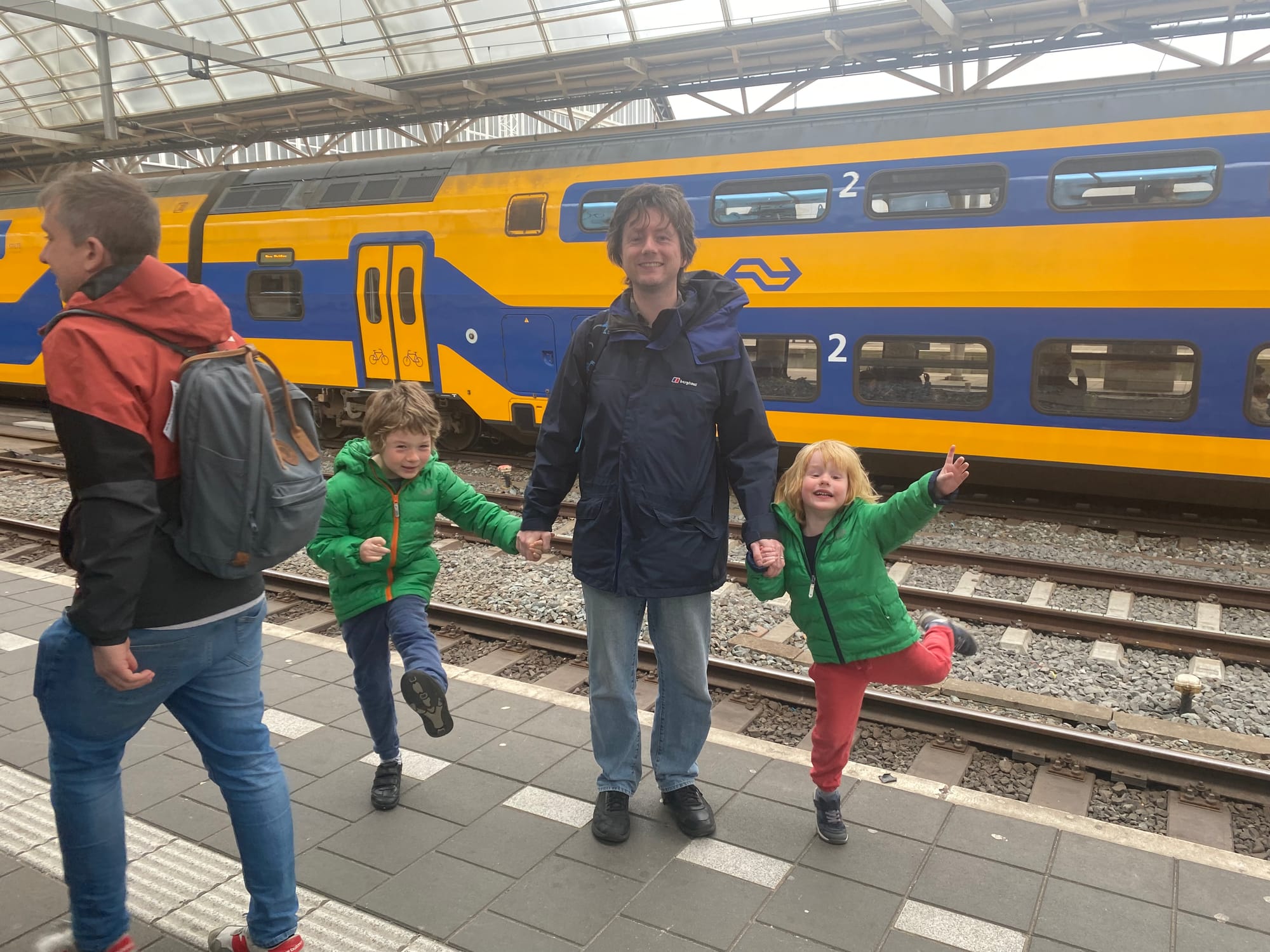
We took an Intercity Direct train between Rotterdam Centraal and Amsterdam Centraal, which takes about 40 minutes. It was fast, smooth and convenient, also stopping at Amsterdam’s Schiphol airport, and travelling between both cities multiple times a day.
Body Worlds
When I told a parent that I’d taken my kids to Body Worlds on holiday, I got an eyebrow raise and was told it was a “bold” choice…Ha, ha!
Body Worlds is a very famous, and controversial, exhibition of real dissected human corpses and body parts preserved by a process called plastination. Initially a touring exhibition, Body Worlds are now a permanent exhibit in multiple world cities, including Amsterdam.
Due to Bigger Boy’s fascination with all things human biology, Body Worlds Amsterdam was a ‘must-see’ for our family in the Netherlands - and one of my motivations for choosing the holiday.
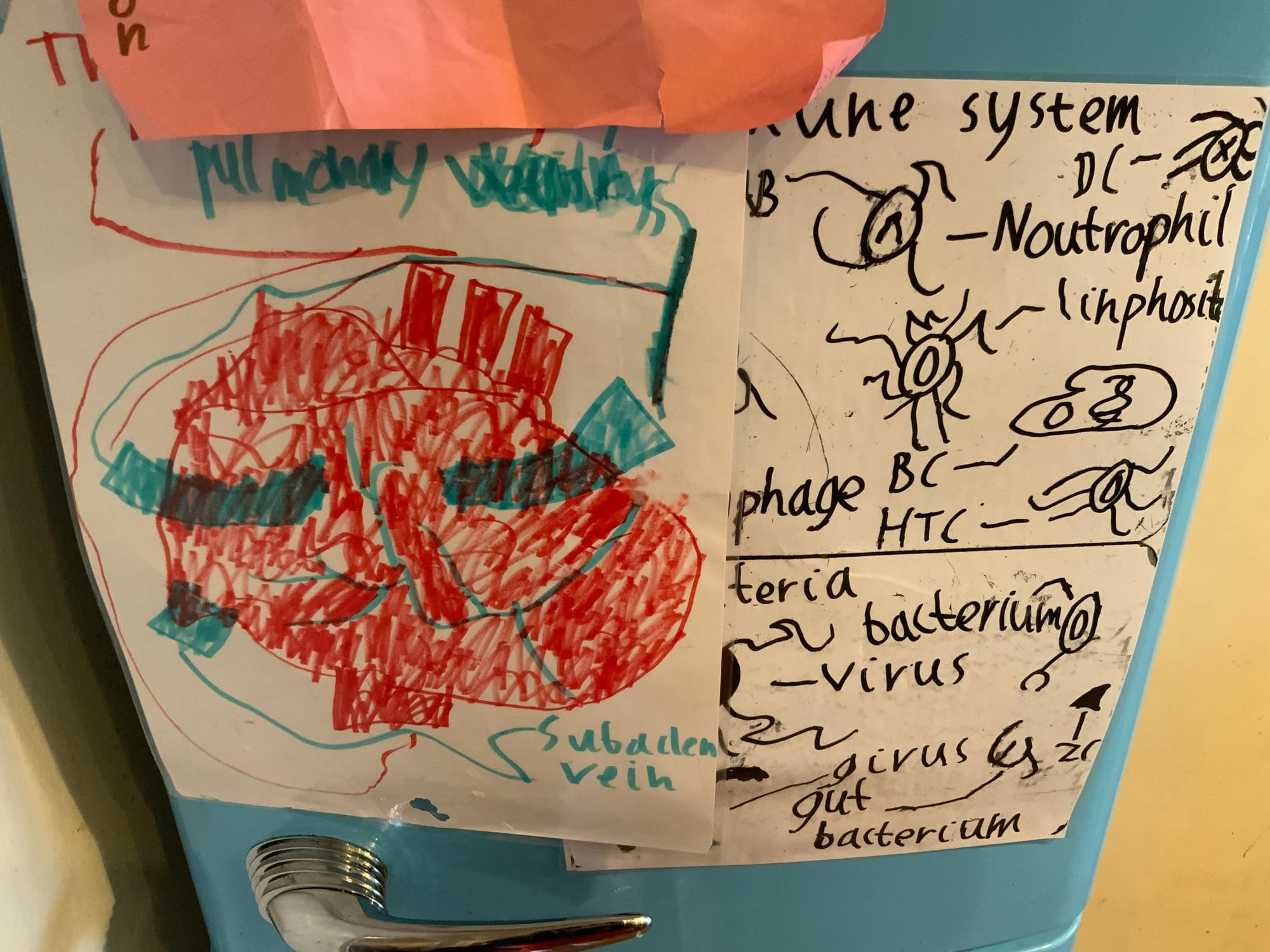
Located over seven floors, the exhibition is located within walking distance to Amsterdam station. It’s suitable for DME kids of seven upwards, as it’s got a lot of display cases of disembodied organs, and Smaller Boy just got very bored and wanted to play on the swing.
Bigger Boy thoroughly enjoyed himself, watching animated videos about metastatic cancer and asking questions about a plastinated smoker’s lung.
I wasn’t sure I was allowed to take photos in Body Worlds, so here’s some stock footage
He was especially fascinated by the display on reproduction, with the multiple foetuses plastinated at different ages. I was monitored a lot during both pregnancies, and he was interested to hear how he ‘swam’ in my uterus at nine weeks’ gestation, and how I first saw his younger brother as a five-day-old blastocyst.
Nemo Science Museum
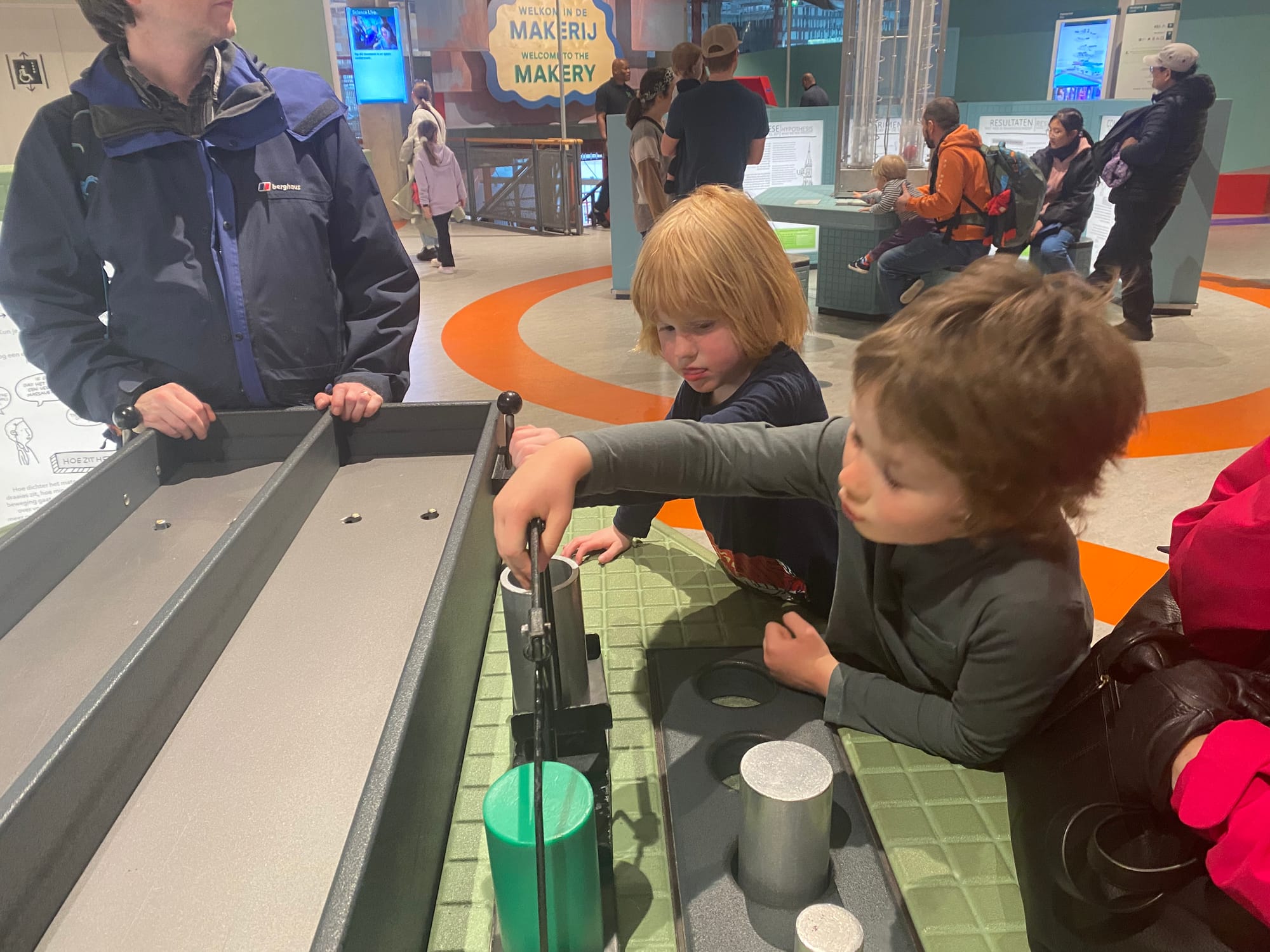
After a grim lunch at Starbucks in Amsterdam station (prepare better than this, folks), both boys opted to walk to Nemo, the biggest science museum in the Netherlands.
Nemo is super for DME kids of my sons’ age. Unlike the Science Museum in London, there are no adult exhibits (such as Helen Sharman’s space suit). Instead, there are five floors of interactive kiddie science experiments - rather like the Wonderlab Gallery in the Science Museum, but on multiple areas of science, and on more than one floor.
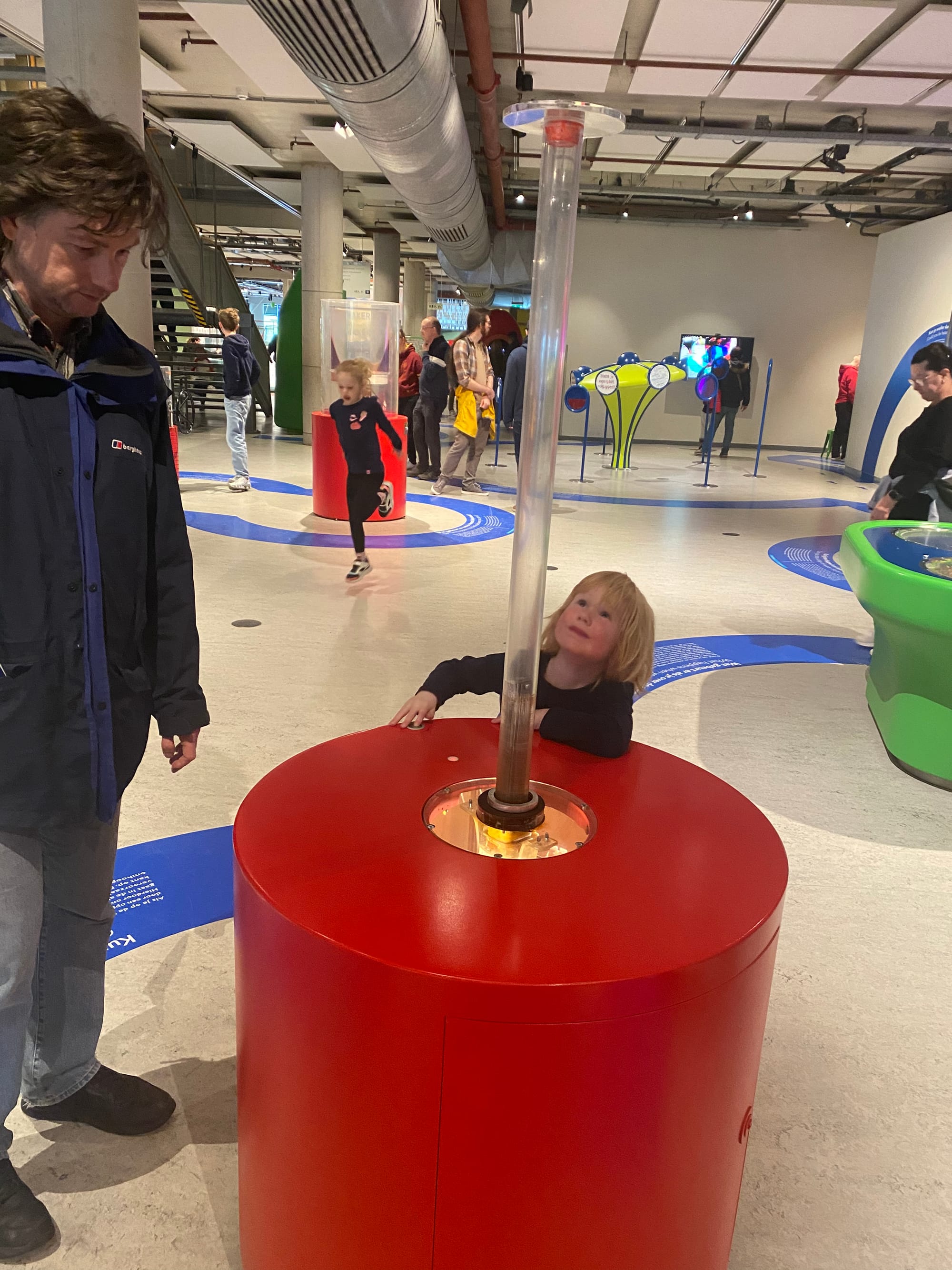
As you might imagine, it was absolute chaos, especially on a weekday afternoon, with kids running around everywhere. Both boys had enormous fun, but the scientific value of the exhibitions depend heavily on parental input. Each experiment has a description, in English and Dutch, on the floor and any educational benefit comes from a parent (or carer) explaining it aloud.
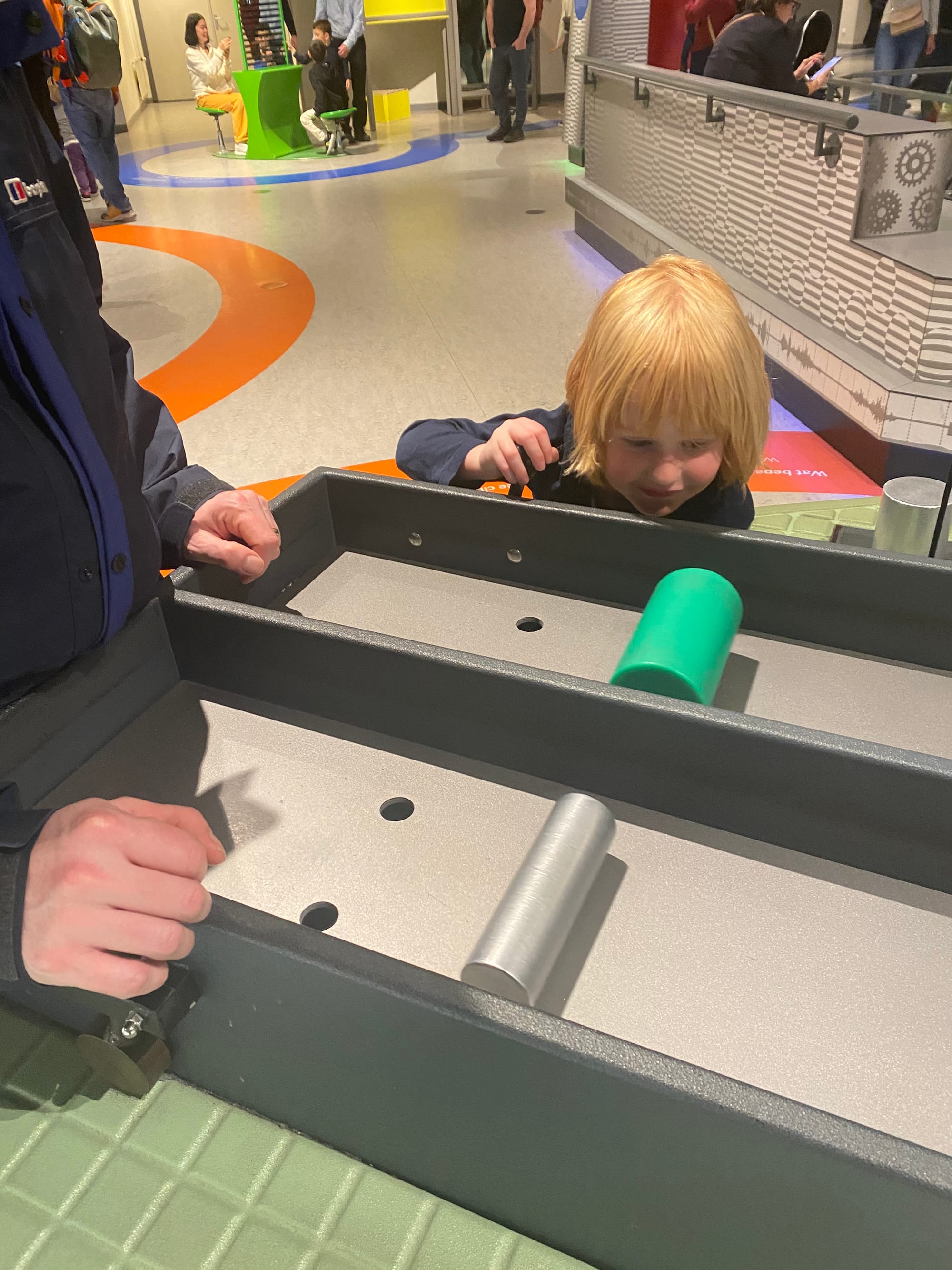
The ground floor physics/engineering exhibition, and the space science exhibition on the first floor were dramatically better than the biology or environmental science exhibitions - neither of which seemed to cover pioneering science.
The environmental science exhibition was mostly focused on Dutch polder management (a common theme), and the biology exhibition was a bit vague and abstract. If I hadn’t been to Body Worlds immediately beforehand, I’d have felt that Bigger Boy had missed out.
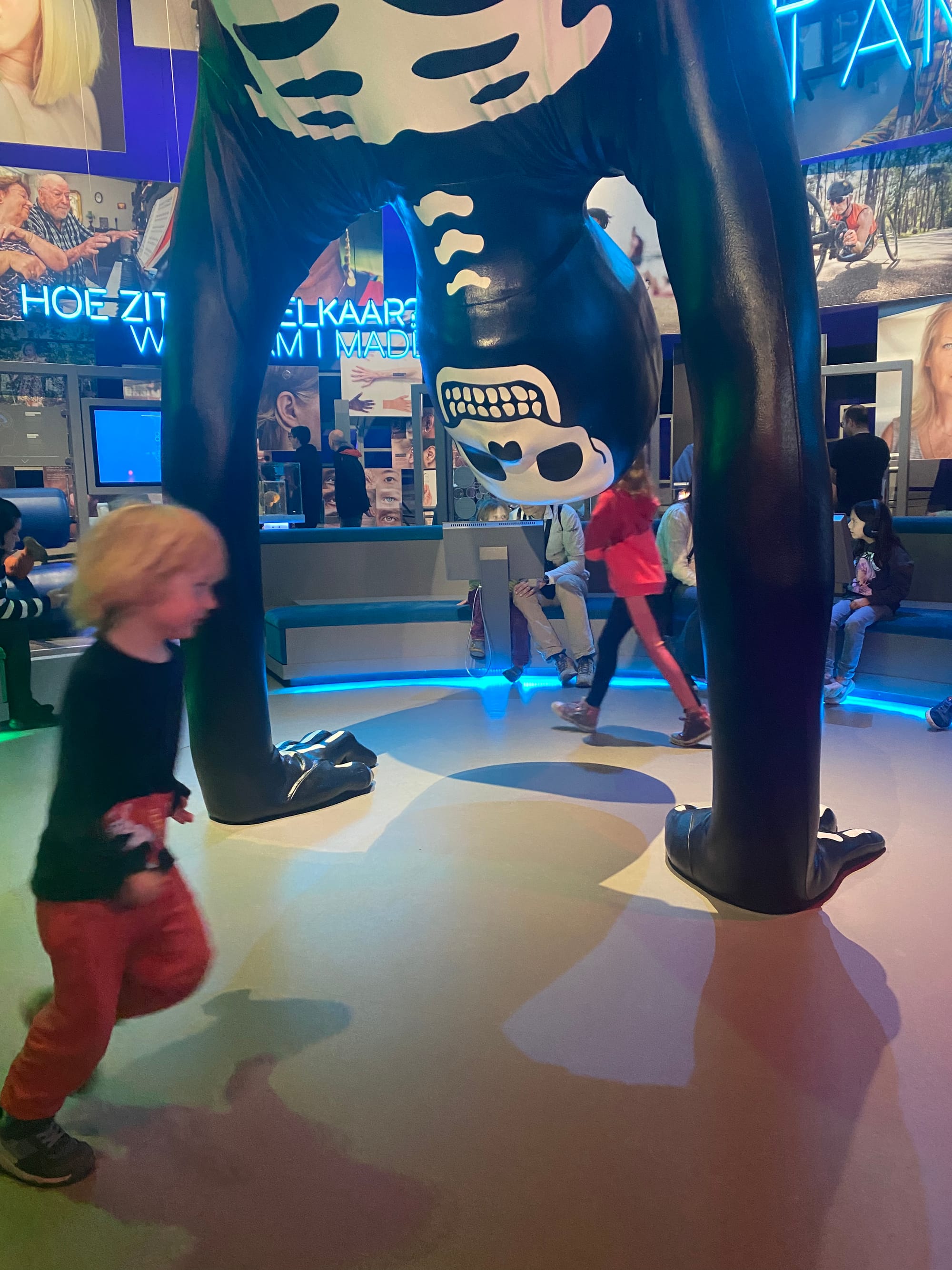
There was a lot of content, and both boys were museum’d out by the time they got to the upstairs biology exhibition. Smaller Boy lost concentration entirely, and ran about madly, including climbing in and out of the sensory ‘squeeze’ machine.
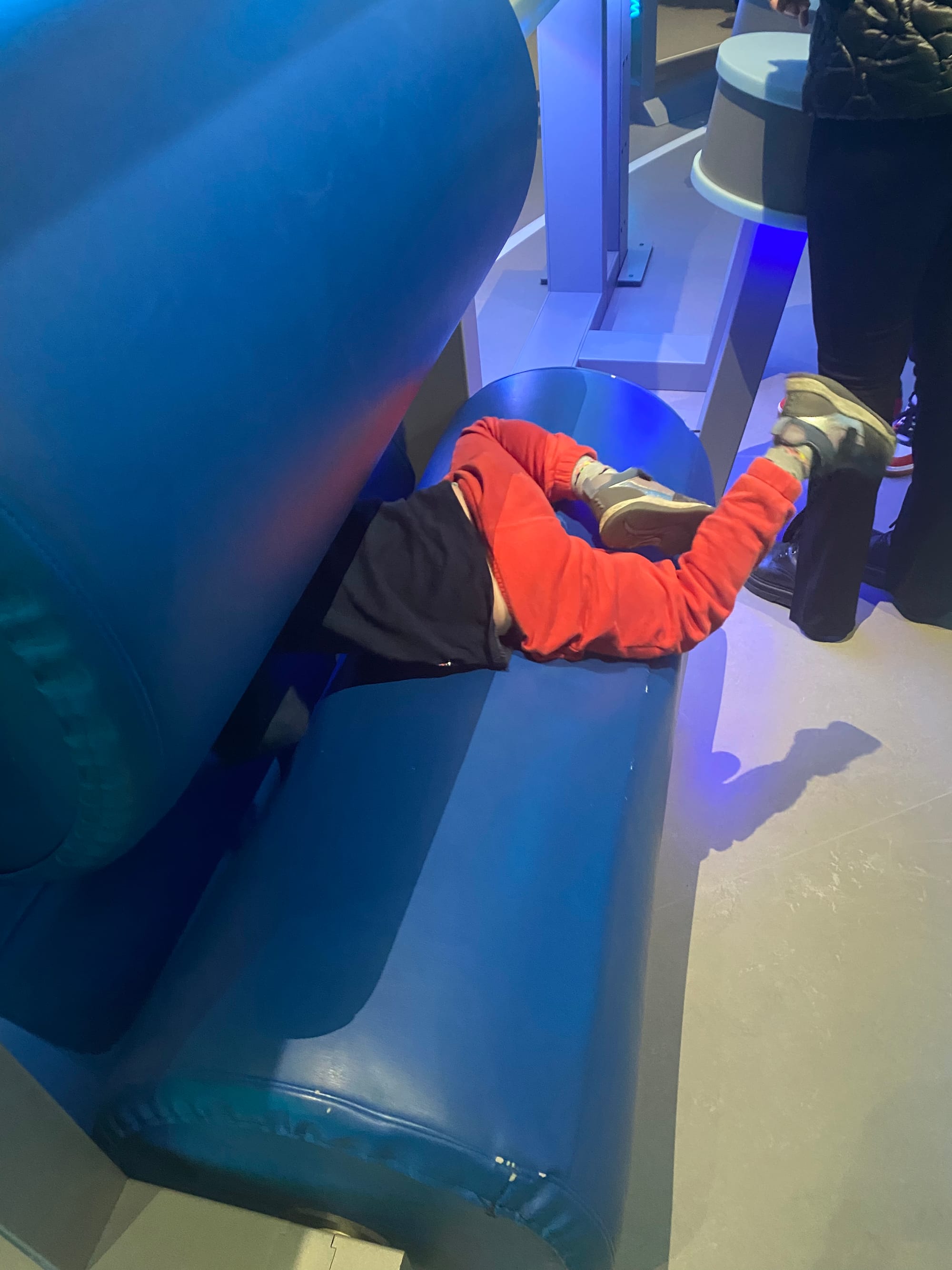
There’s also a floor on energy and an interactive chemistry lab, which we didn’t manage to visit. If you were staying in Amsterdam, you might want to make an (expensive) return trip to Nemo to get the full benefit of the museum.
The Rijksmuseum Boerhaave is the ‘adult’ science and medical museum and, presumably, also worth a visit if you have more time in Amsterdam than we did.
Day Five: A trip to FutureLand… and container terminal tour

Rotterdam’s container port is the largest in Europe and my husband thought it would be of interest to transport geek kids. He found that the newest part of the port had a visitors’ centre, called FutureLand, which organises boat and bus tours, and we organised these for our last full day.
Getting there (and back)
Maasvlakte 2 is a port extension opened in 2013. The biggest Dutch civil engineering project since the Delta Works that shortened the coastline, it reclaimed about 5,000 sports fields in area from the sea.
Land reclamation for the Maasvlakte 2 extension to the Port of Rotterdam promotional video by Dutch dredging company, Van Oord.
As Maasvlakte 2 has reshaped the Dutch coastline in the last decade, it’s not that easy to reach from Rotterdam by public transport. The best routes seem to be an Uber (van) from Schiedam Nieuweland on Rotterdam Metro Line B or the tourist-friendly route we took - with a Hoeksveer ferry from the pier next to Hoek van Holland Haven tube station.
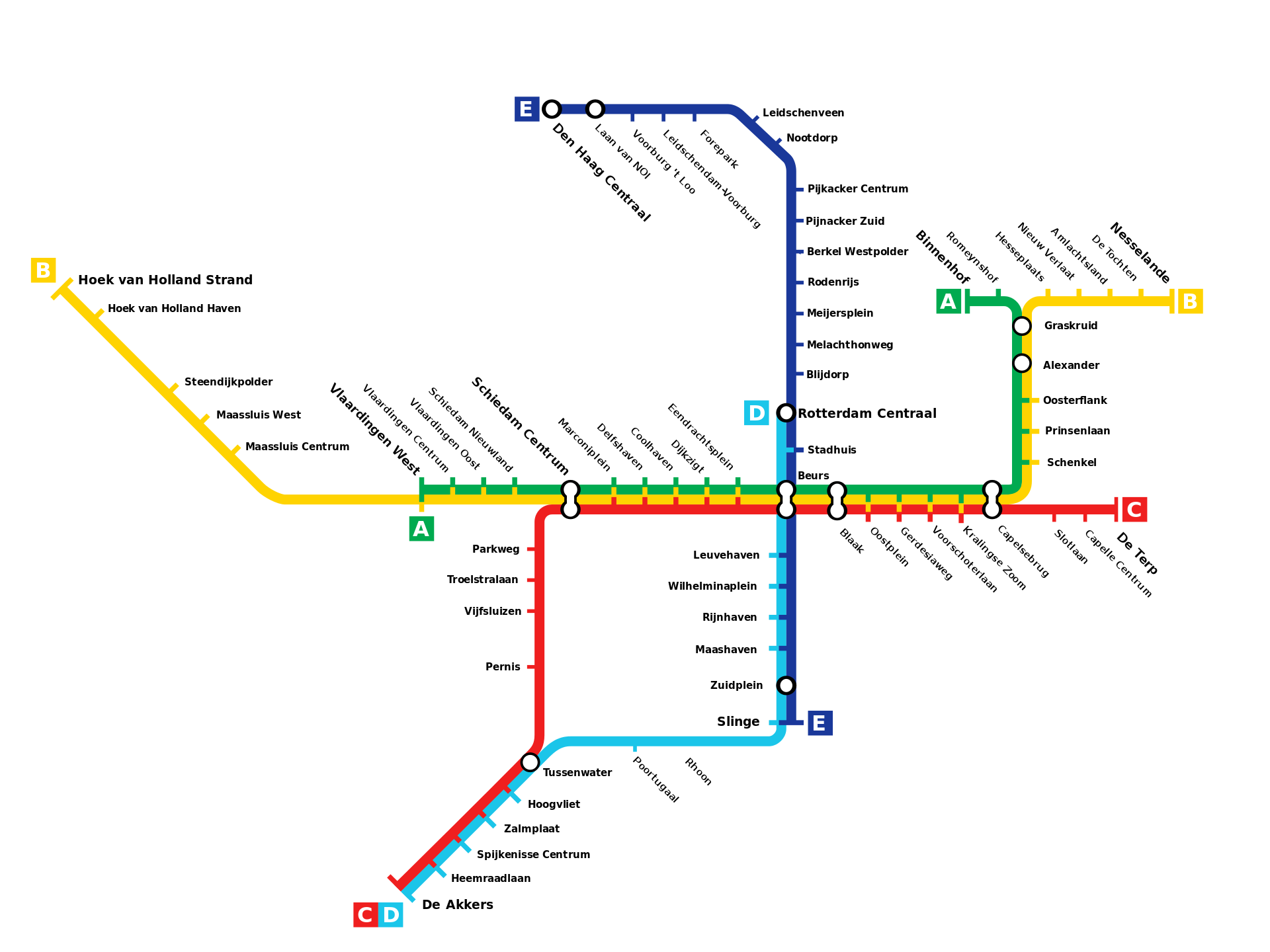
Metro trains depart every 20 minutes to Hoek van Holland with a more frequent service to Steendijkpolder.
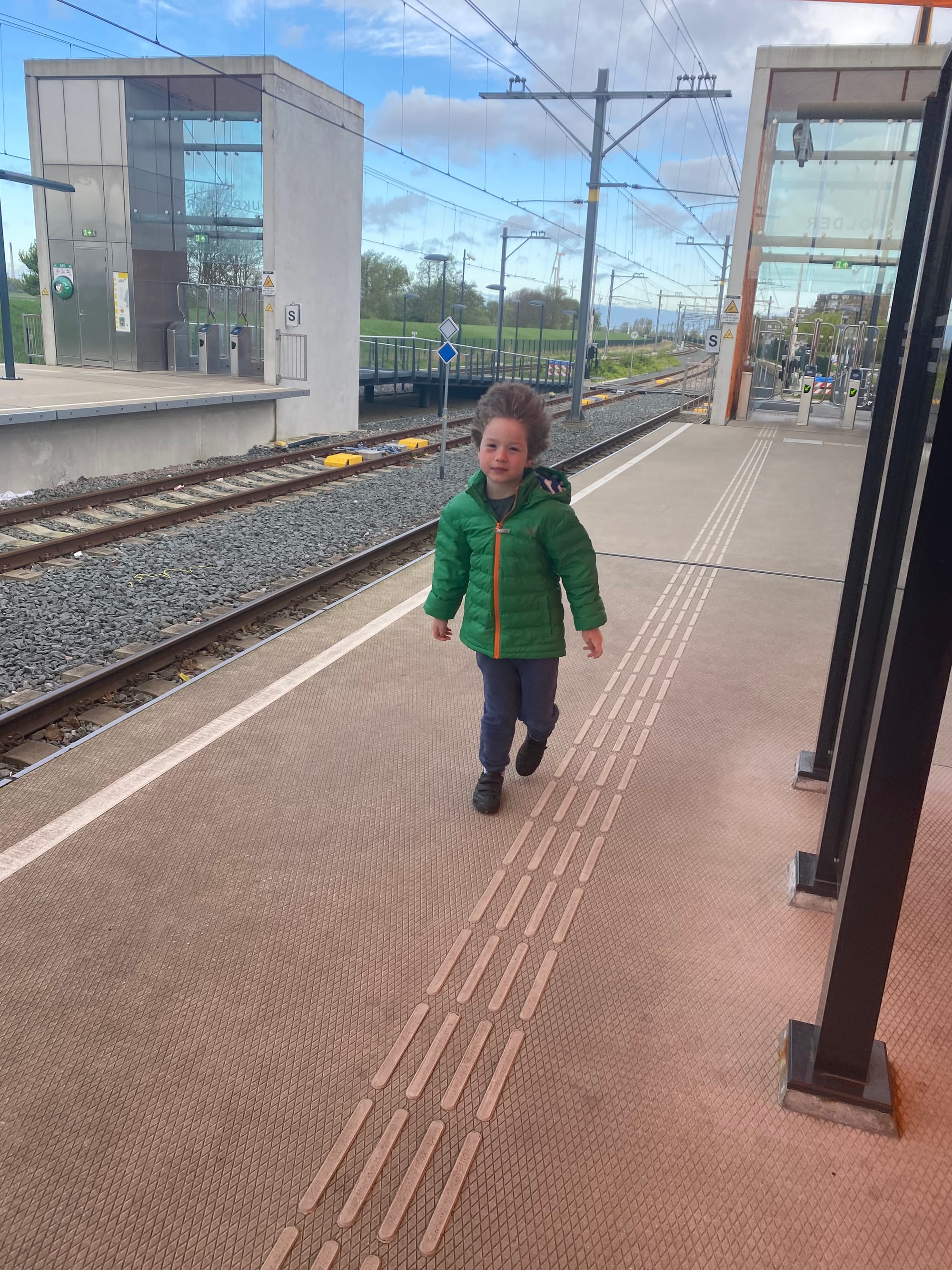
The Hoeksveer ferry to the FutureLand visitors’ centre is just across the road from the Metro station, and sailing times seem scheduled to meet the coach and ferry tours. Off-season, neither the ferry nor the FutureLand tours depart daily, so check both are running before you make plans.
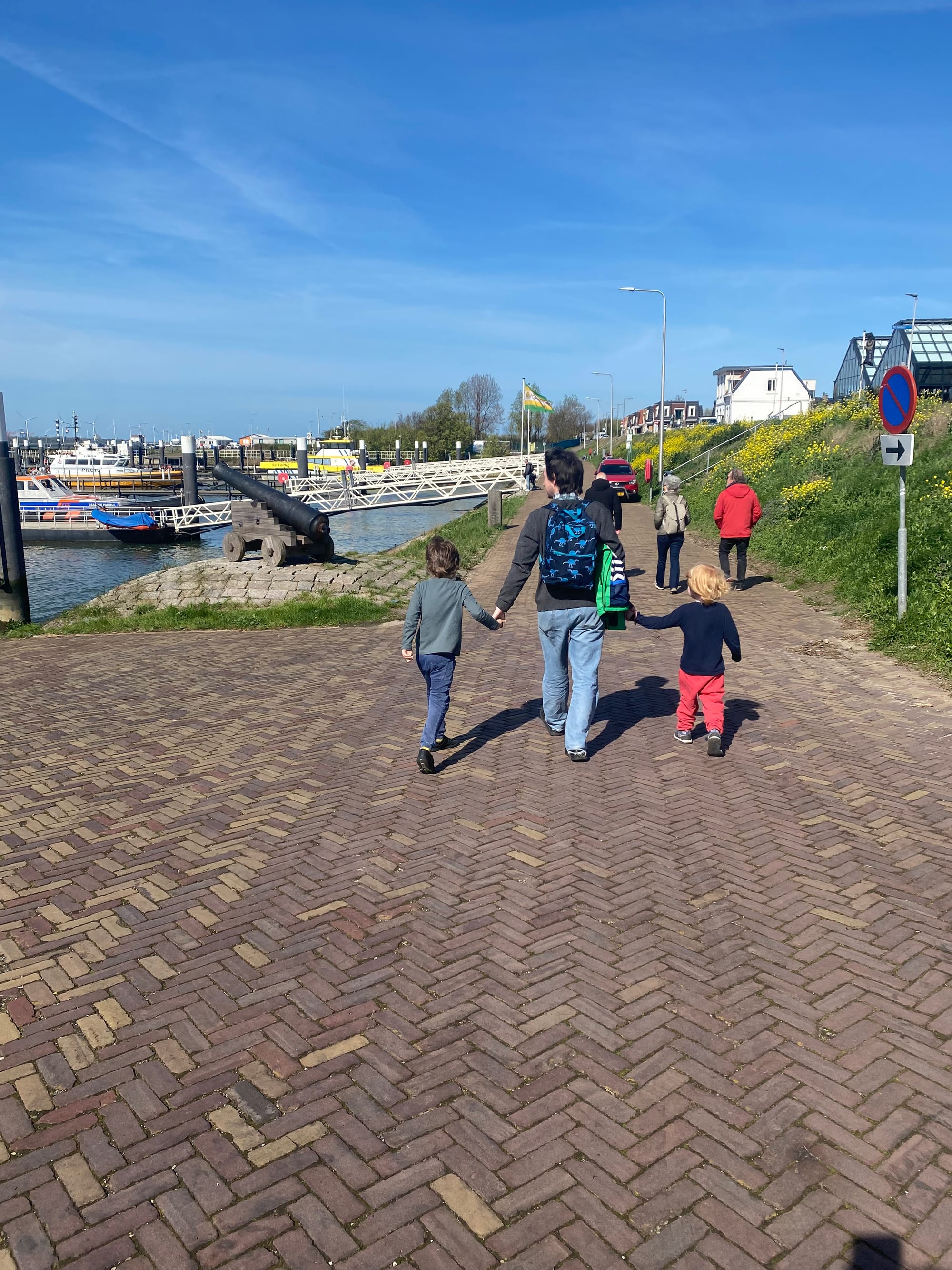
The Hoeksveer ferry was probably the best part of the trip for the boys. Not only does it go inside the Maasvlakte 2, but it’s a very small boat with prow seating and a proper wooden cabin.
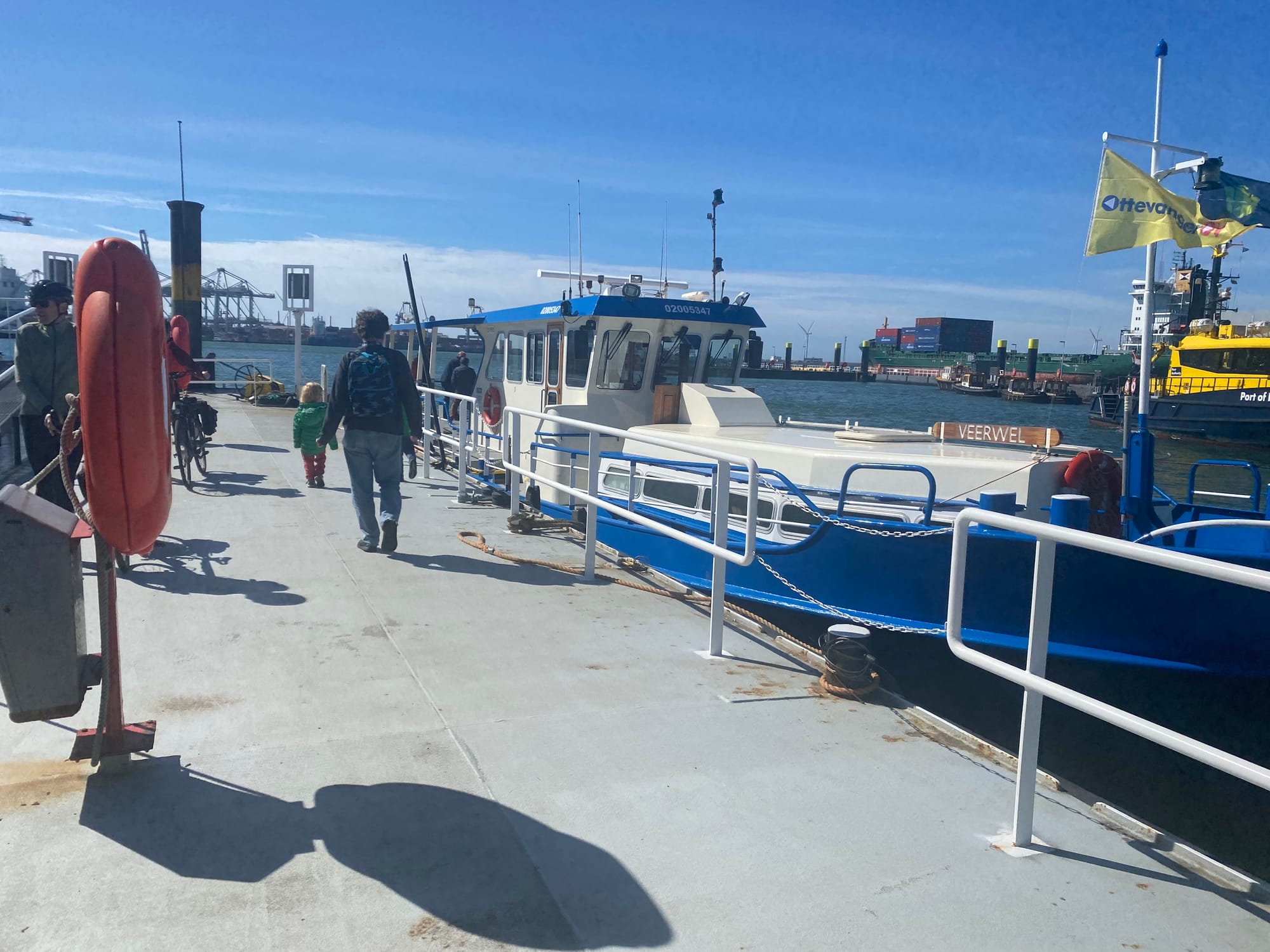
The boat takes fifty minutes, dependent on weather, to cross the Nieuwe Waterweg shipping canal and to sail inside the Maasvlakte 2.

It’s worth emphasising that the Hoeskveer ferry sails about halfway through the Maasvlakte 2 because the Hoeksveer ferry duplicates much of the FutureLand Ferry tour - but on a more interesting (to kids) boat.
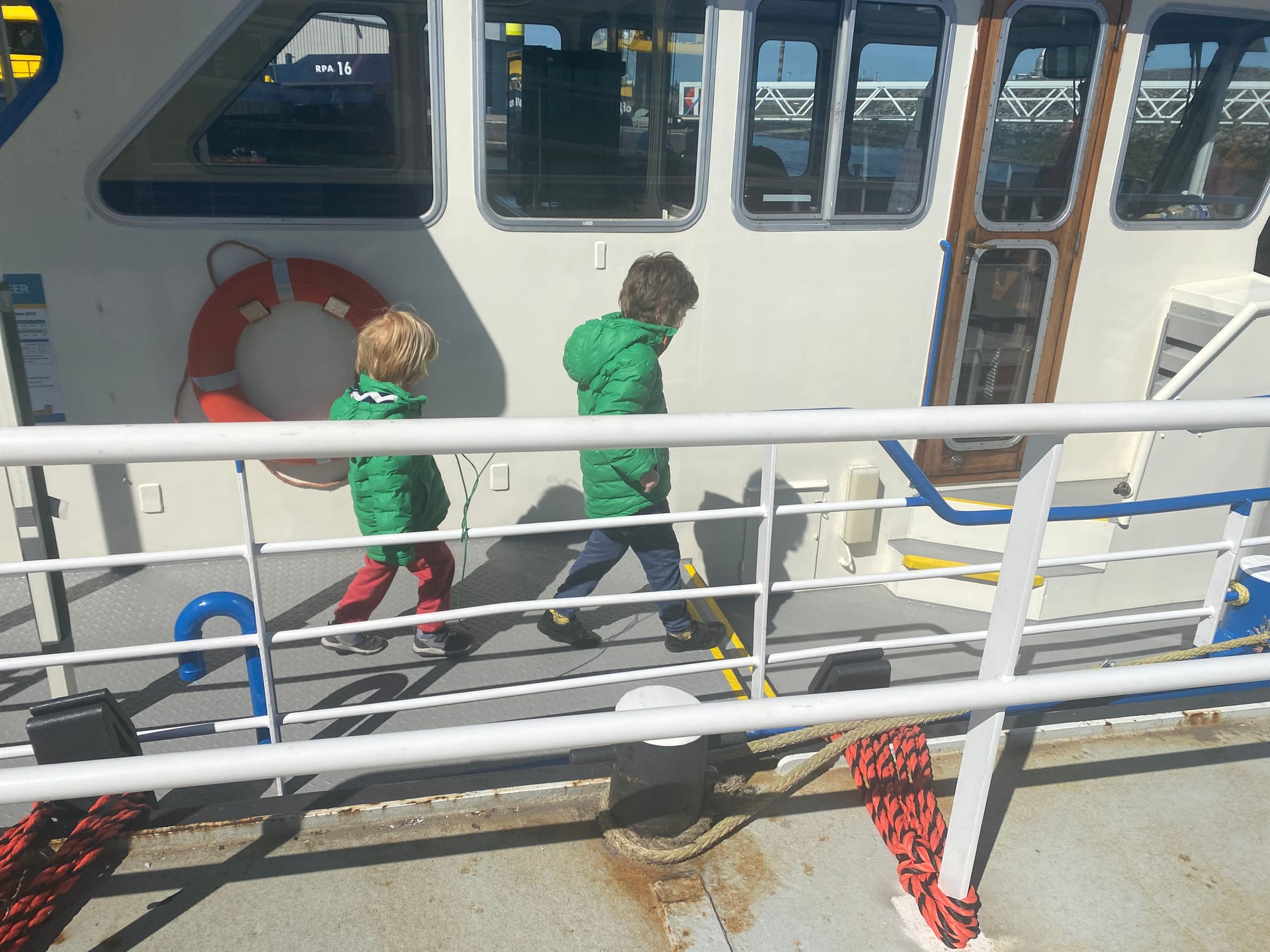
On colder, or wetter, days, the Hoeksveer ferry has a warm downstairs cabin with covered seating. Smaller Boy loved the little cabin, especially looking through the hold windows to see his older brother’s feet on the prow!
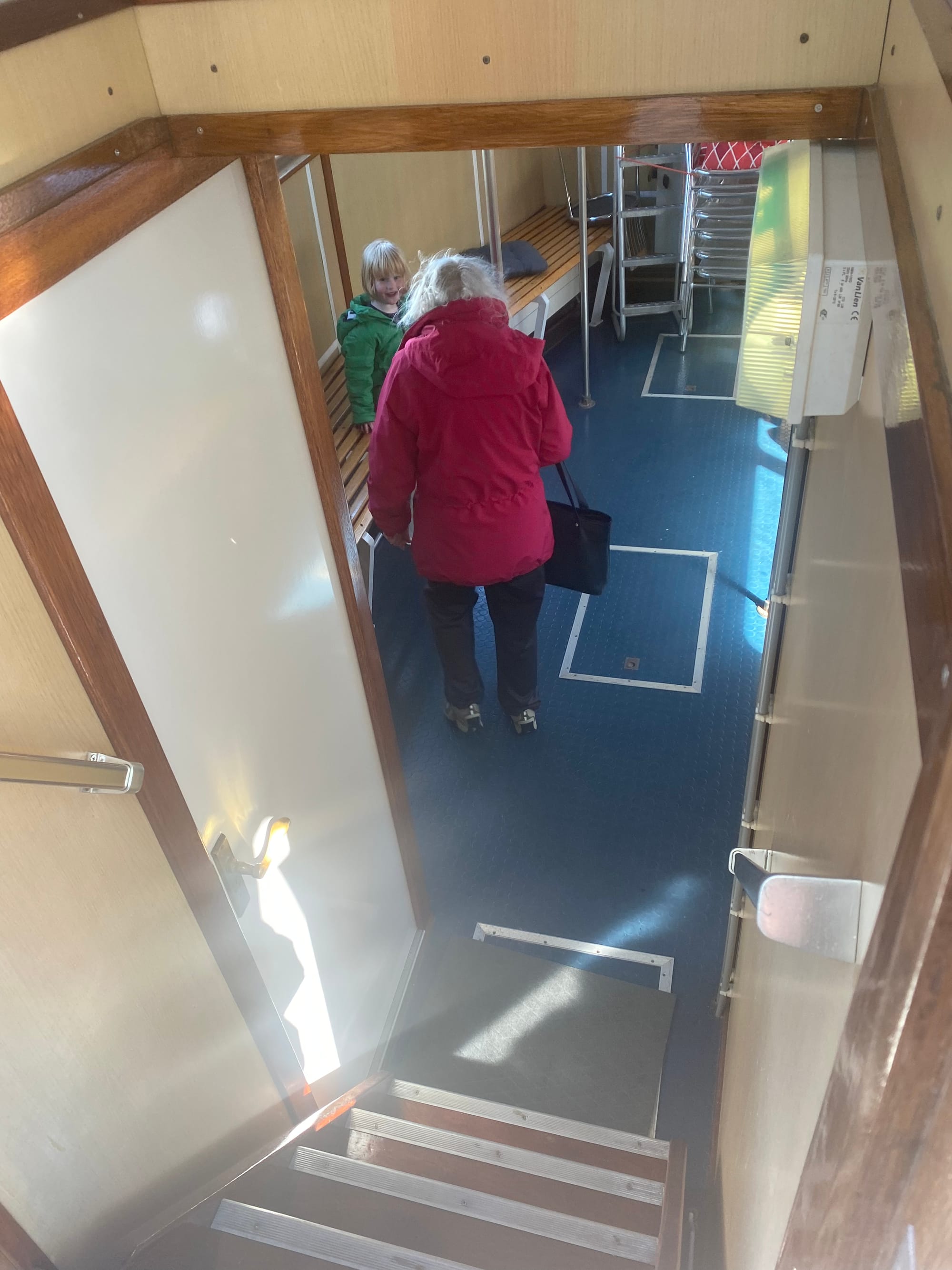
FutureLand ferry tour
The Maasvlakte 2 visitors’ centre, FutureLand, offers both a boat and a coach tour of the port. We opted for both, but only ended up going on the ferry tour because the boys were tired (and disappointed) by FutureLand.
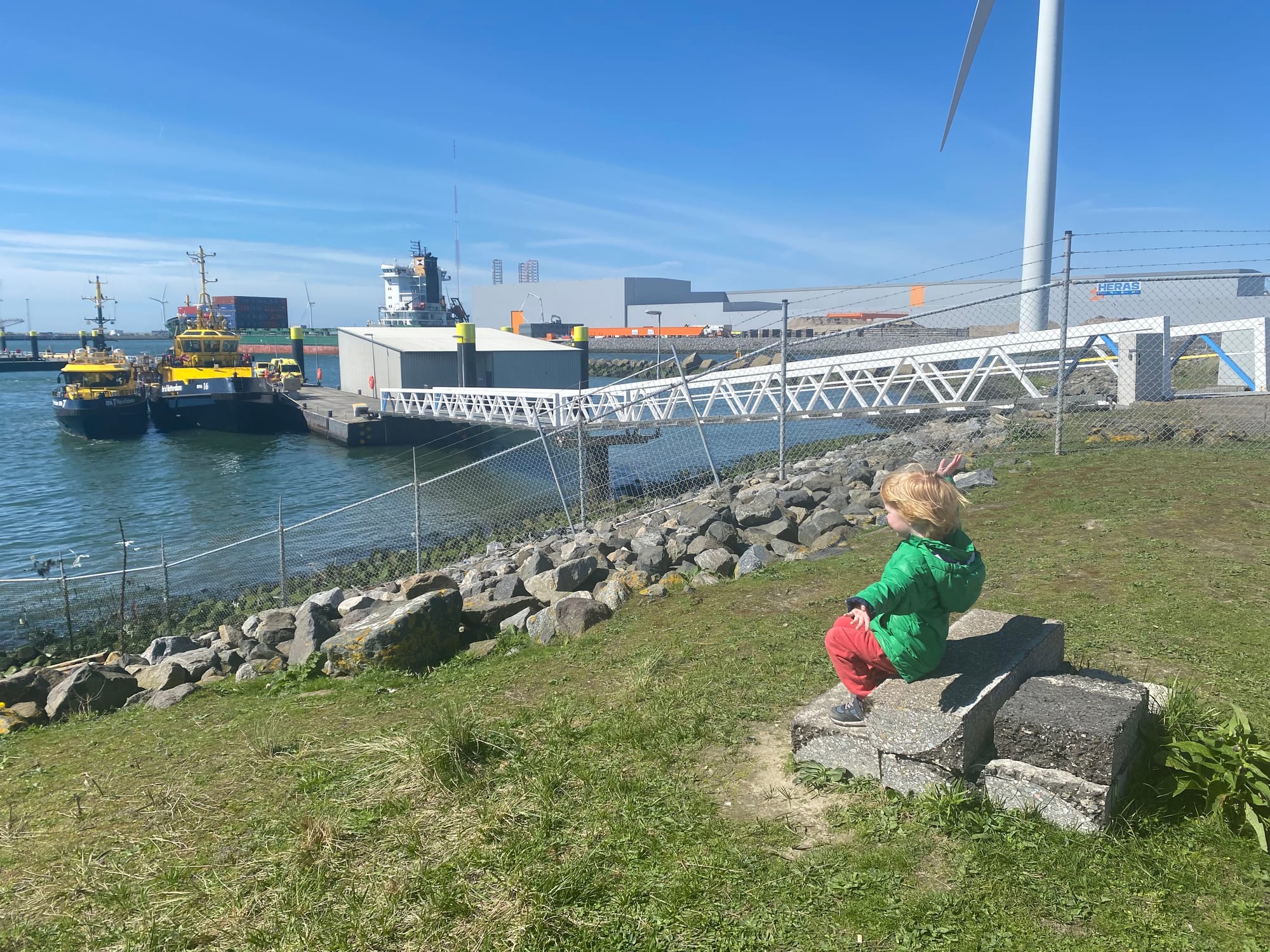
The boat tour is run by Spido (see the Rotterdam Harbour Tour) on one of their multi-storey cruise boats, and the first third replicates the route that the Hoeksveer ferry takes into the port. The boys got onto the cruise cold from the 50-minute ferry trip and then sat indoors.
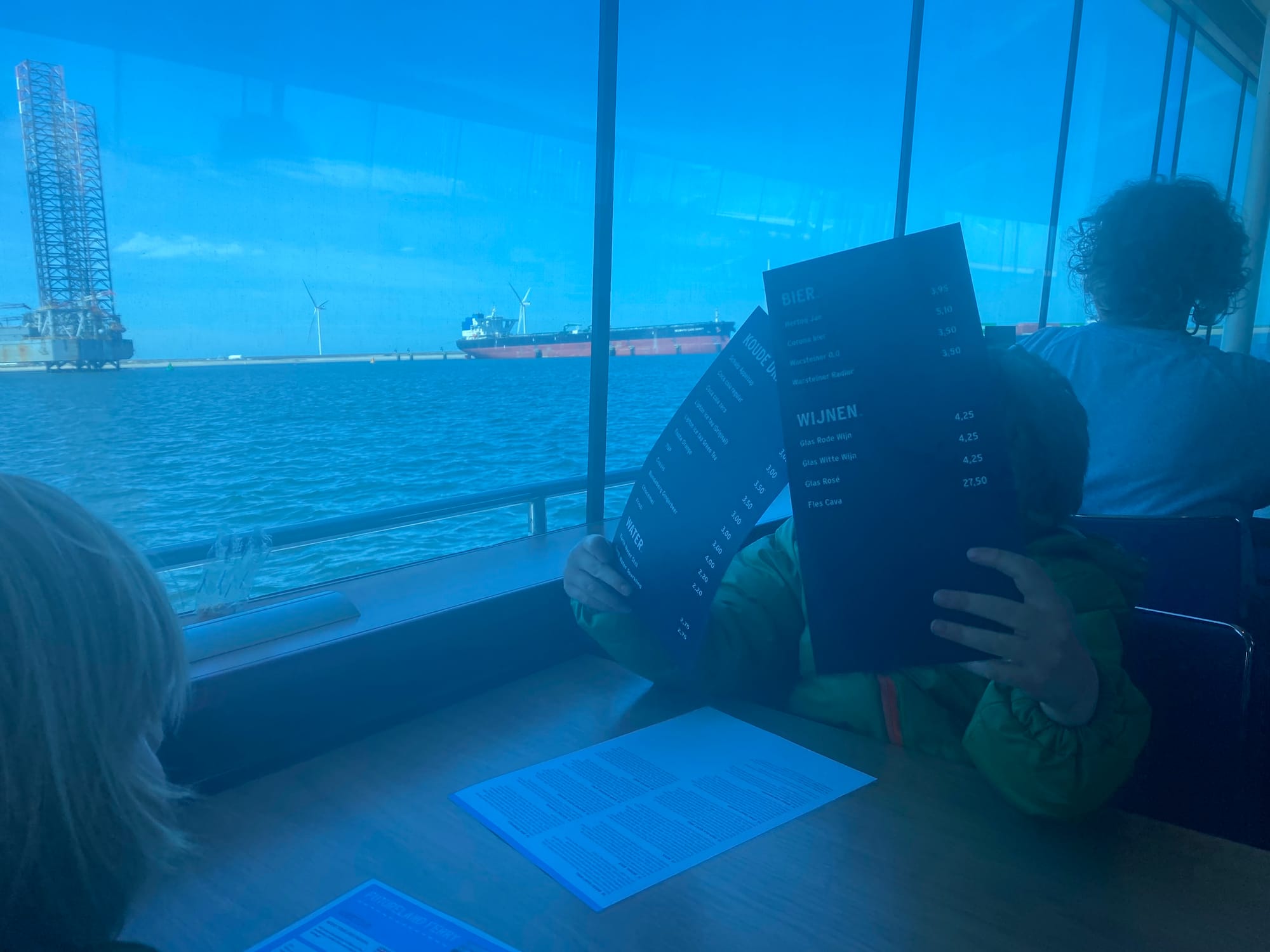
The tour was in Dutch, with a cut-down English leaflet available to pick up near the bar. This was nowhere as interesting for them as an English-language tour, and we missed a lot of information we could hear the guide delivering to the Dutch-speaking tourists.
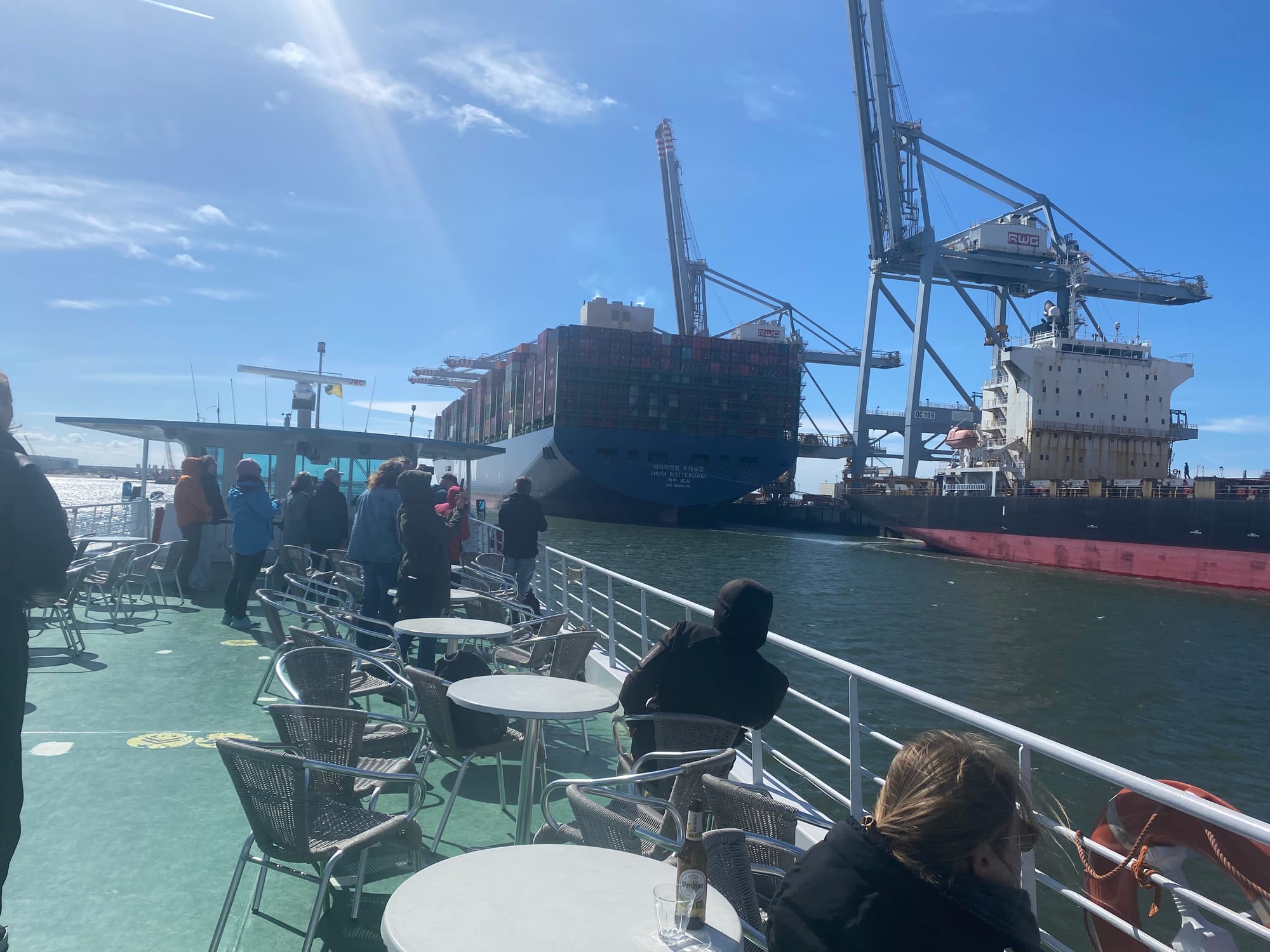
Bigger Boy soon lay in the darkness under the table, making occasional moaning noises. Smaller Boy scribbled on his kids’ dock/boat picture with coloured crayons that a waiter kindly provided. My attempts to get them interested in massive cranes failed. Turns out that huge cranes are like giant robots destroying Chicago; you can see too many in one sitting.
Transformers 3 has a solid hour of giant robots destroying Chicago and I got bored after 30 minutes. Hard to believe, but it turns out you can also ‘crane out’ two small boys in a container terminal.
The only interesting section of the FutureLand ferry tour, which we hadn’t already seen, was the Pioneering Spirit - a crane ship for moving oil and gas platforms. If you’re geeky enough to follow the dimensions, it’s 382 metres long and 124 metres wide, and the largest vessel in the world by tonnage.
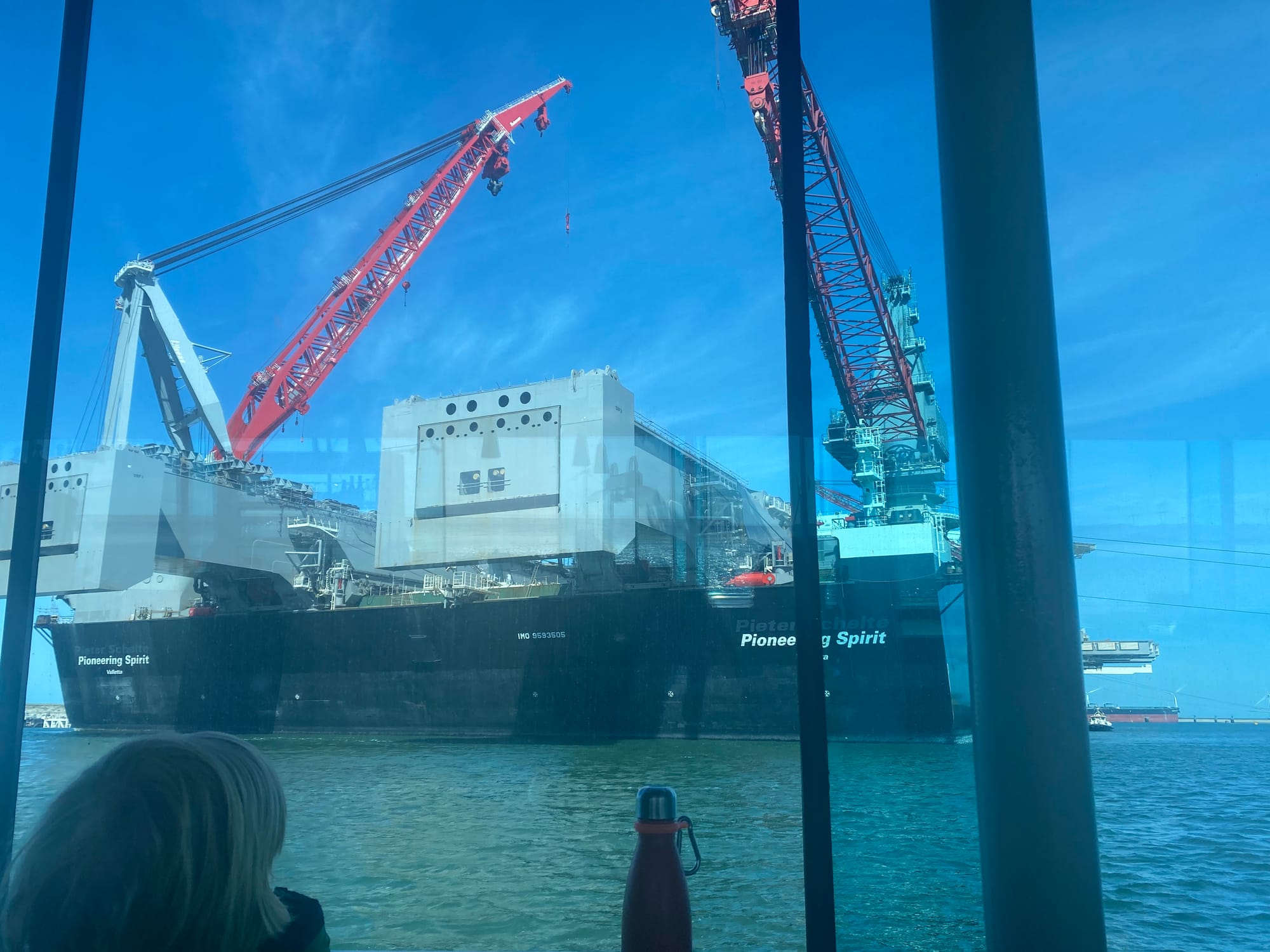
The Pioneering Spirit is so ridiculously large that it looks like two ships from the front (it’s a catamaran) and is currently moored in the unused part of the Maaslavkte 2 because - from what I can tell - there aren’t many other harbours big enough to store it.

We didn’t take the coach tour because the boys were tired, and there didn’t seem much else to see. The Yangtzehaven channel leading into the port, for example, is about 600m wide and most of the Maaslavkte 2 feels like open water. Apparently this is to allow the world’s biggest ships, which can be up to 400m long, space to pass each other in strong winds and to turn around.
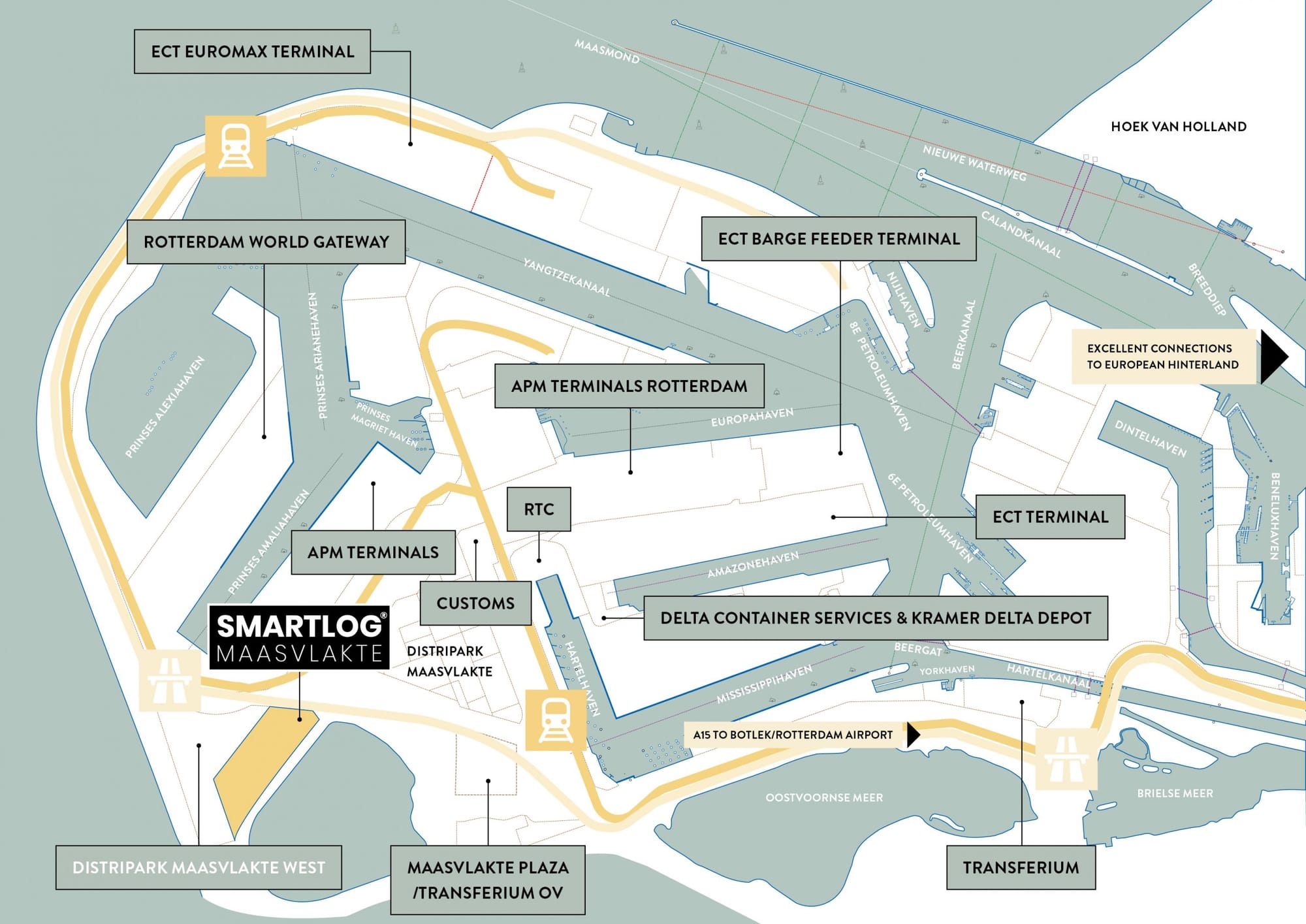
Overall, the FutureLand ferry trip was designed for a domestic audience who needed convincing about the value (and environmental sustainability) of the port.
FutureLand visitors’ centre
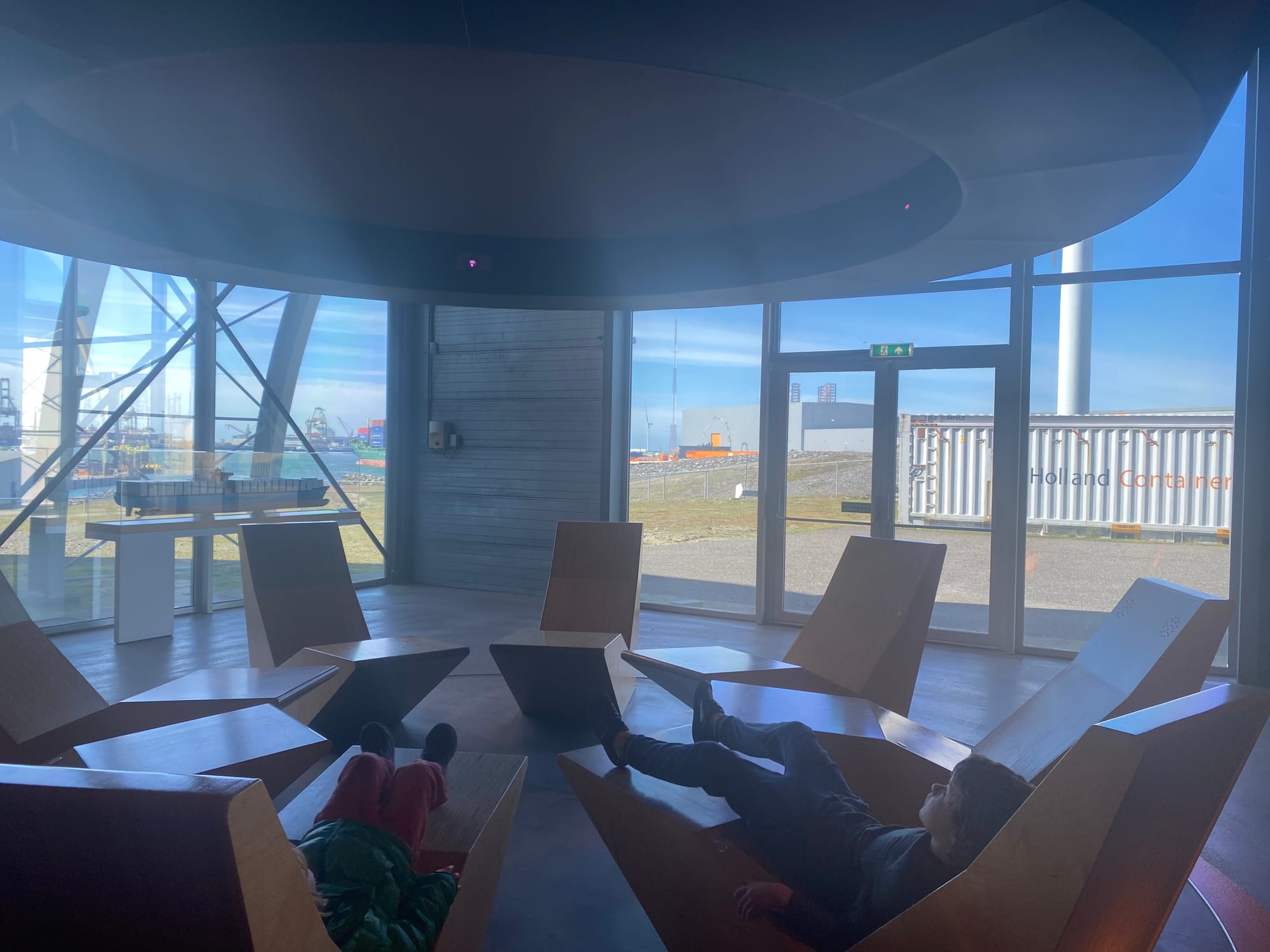
The visitors’ centre was a similar deal to the ferry tour, but with more English language exhibits. If I said that it was ‘designed for school tours’, you’d understand why myself - and two young children - only spent about five minutes there.
The only positive thing I can say is that it had a clean-looking cafe that smelt of IKEA, which you might want to use if you were at the port over lunchtime. We took homemade sandwiches, which we ate - somewhat breezily - on the Hoeksveer ferry before the trip.
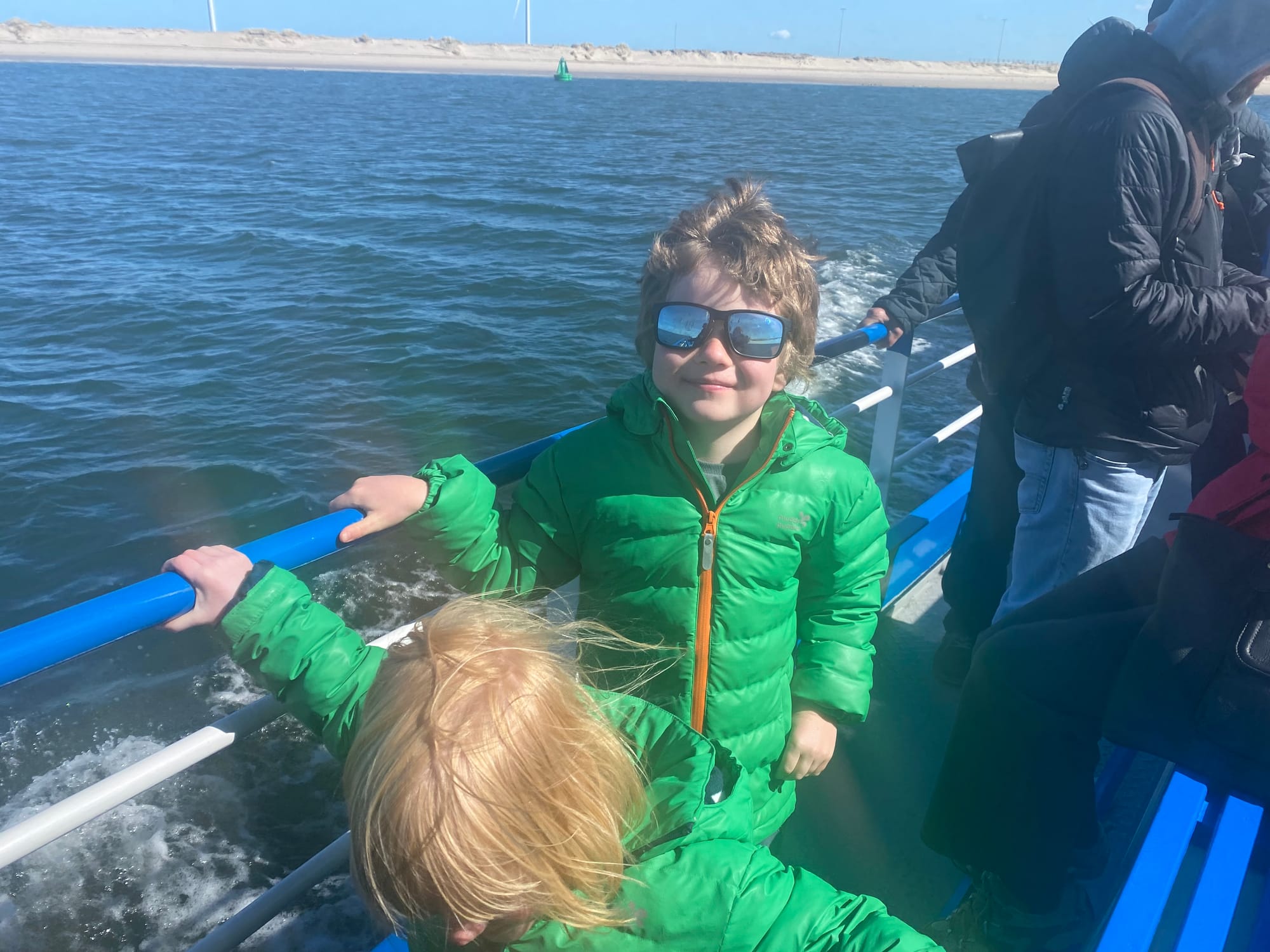
Putting together your own itinerary
Whether it’s the Madurodam model city or The Hague/Scheveningen beach, there are lots of things to do in and around Rotterdam. If you don’t like our itinerary, you can always adjust it to suit your own family!
